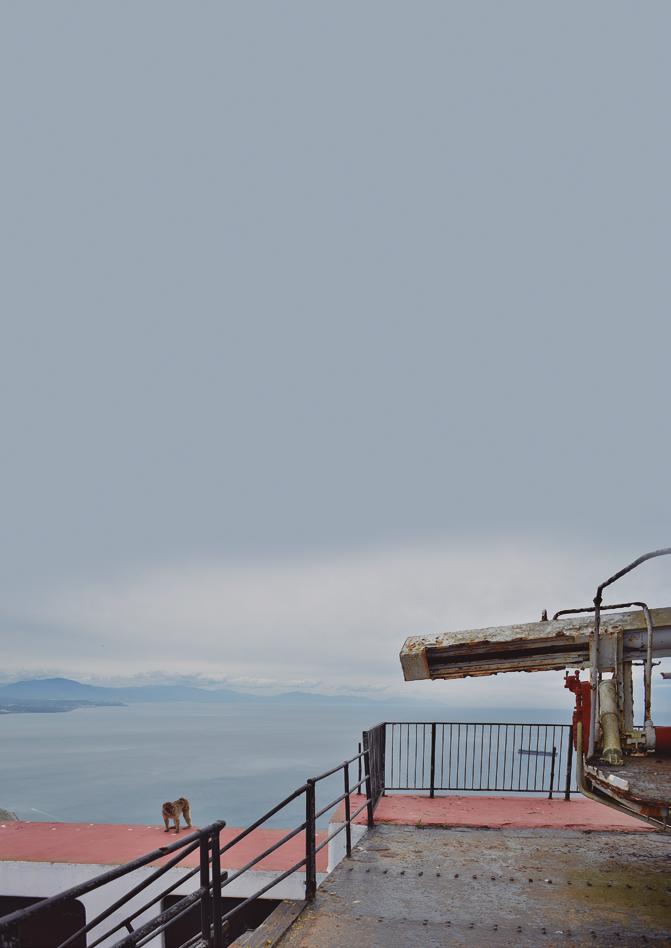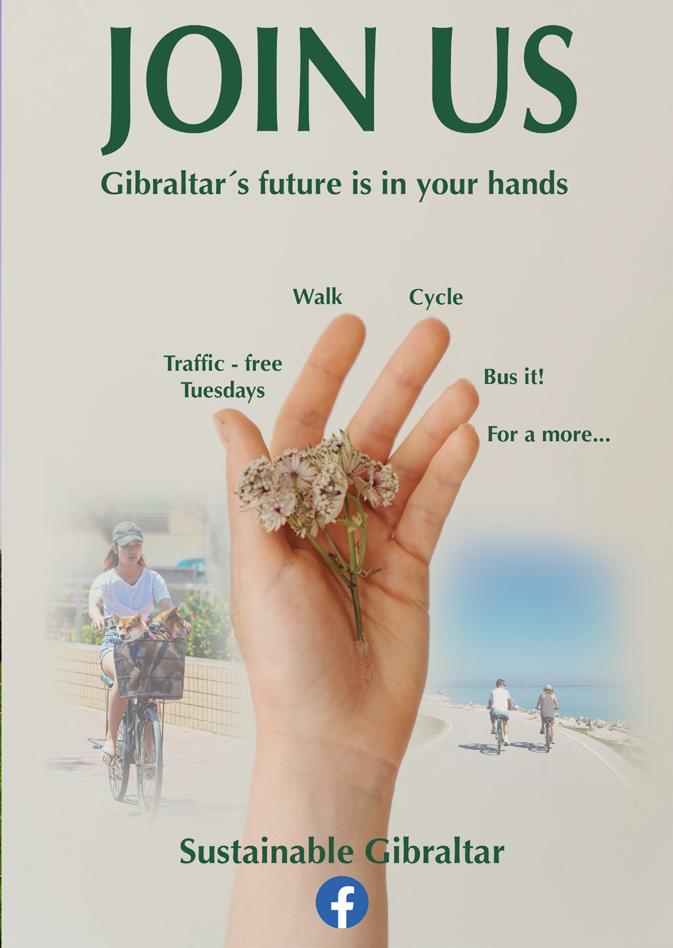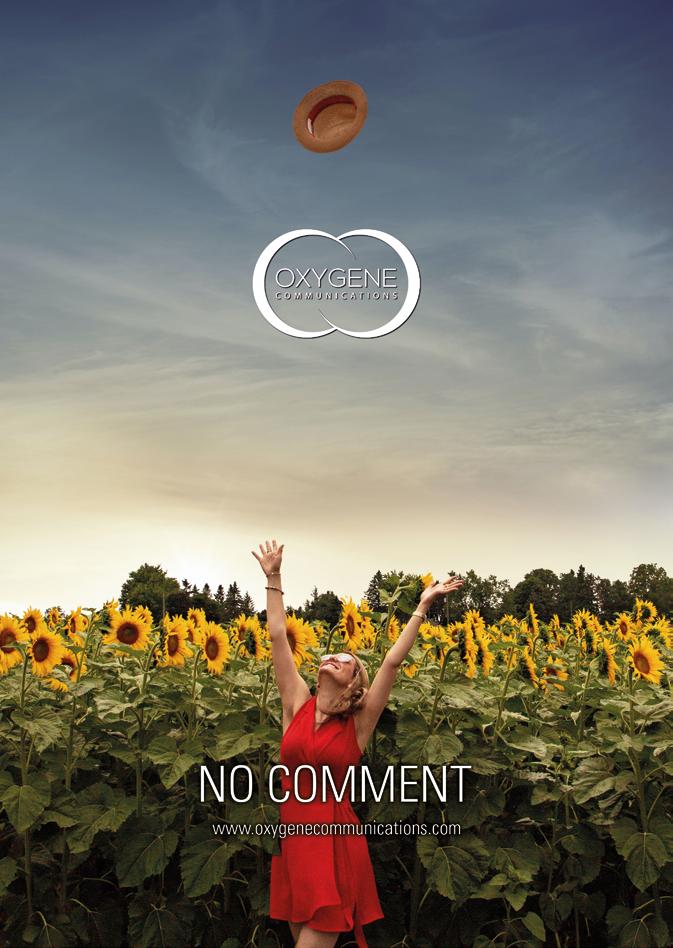


“No city should be too large for a man to walk out of in a morning”.
Cyril Connolly.
«Ninguna ciudad debería ser tan grande que no se pudiera salir de ella a pie en una mañana».
Cyril Connolly.
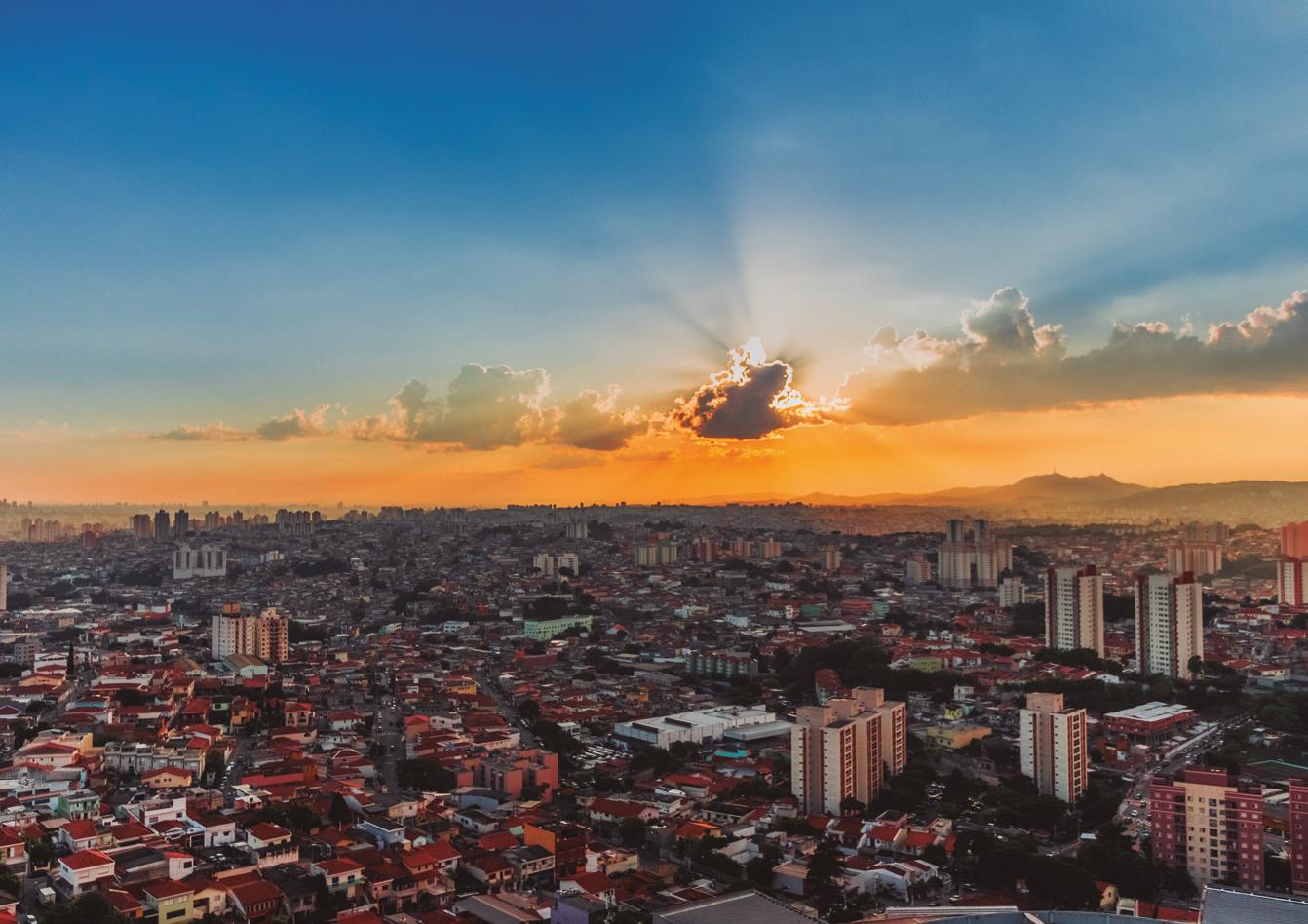
PHOTOGRAPHY: PEXELS.COM
“Sunset in spring time walks on the tail of the golden pheasant”.
Yosa Buson.
«La puesta del sol en primavera camina sobre la cola del faisán dorado».
Yosa Buson.
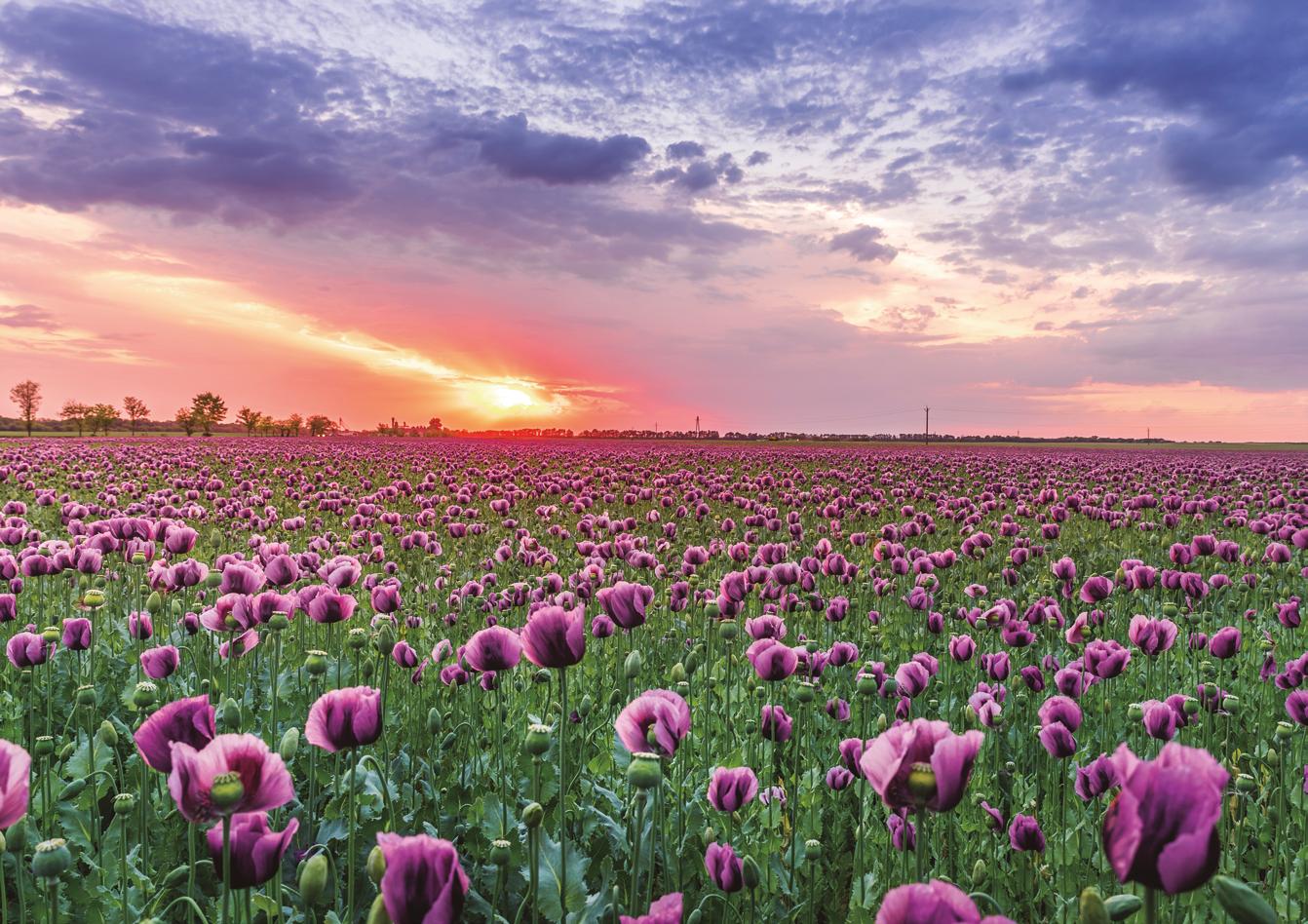
“My country is there, where the most beautiful clouds pass”.
Jules Renard.
«Mi país está allí donde pasan las nubes más bellas».
Jules Renard.
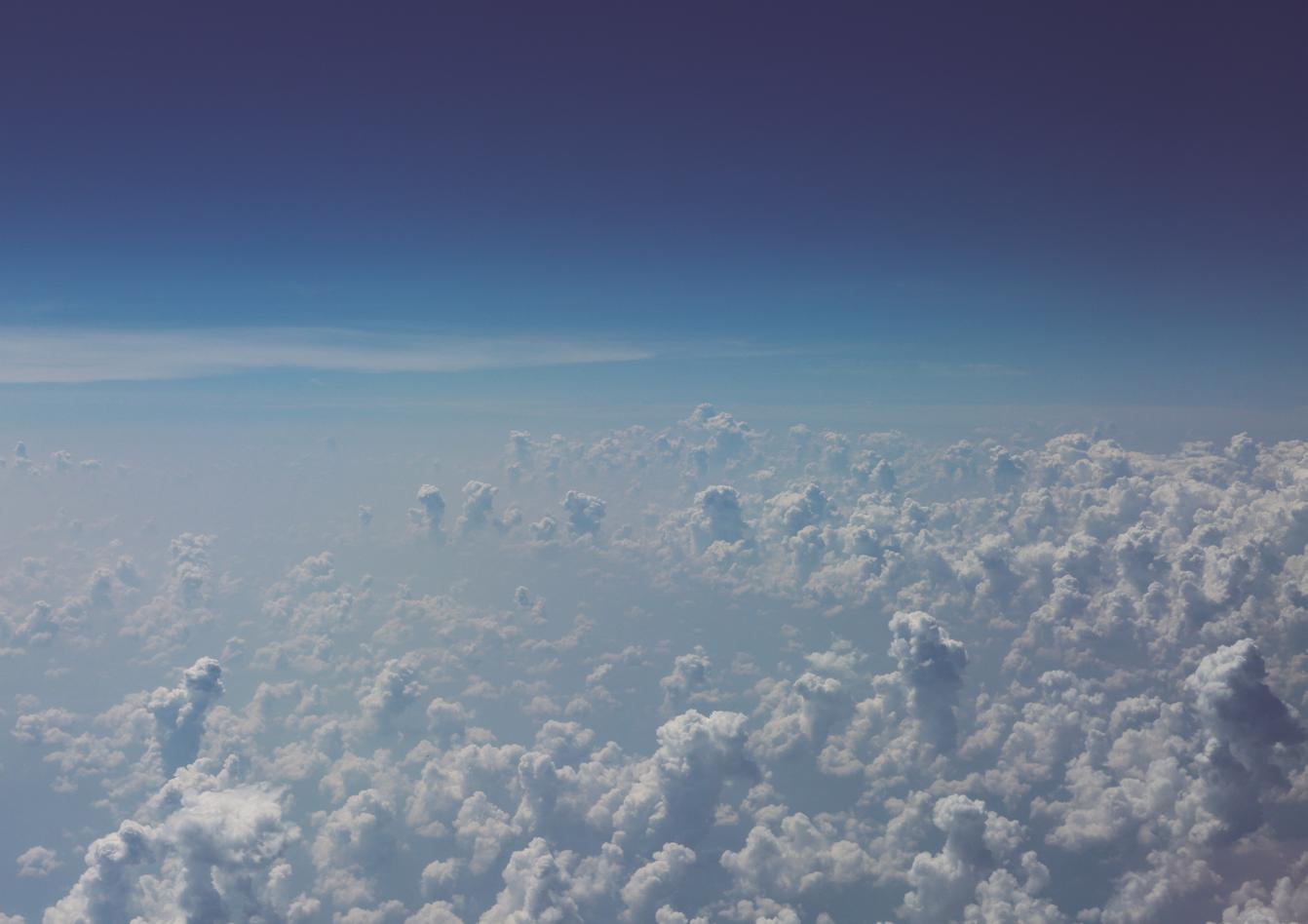
Stop looking the other way and subscribe
Deja de mirar para otro lado y suscríbete

This volume was published in March 2022 by Oxygene Ltd. OTWO Issue 32
Oxygene Ltd.Business Centre. 19 George´s Lane.
GX11 1AA, Gibraltar
Tel. +00350 54080331

Collection “The flower of the month”. Colección “La flor del mes”.
Shorts
www.oxygenecommunications.com
© Publishing:
Oxygene Ltd.
Vanessa Byrne
Managing & Commercial Director
Juanjo Trujillo
Creative Director & Chief Designer
Sarah Birch
Columnist & Translation
Photographer:
Ruben0568, Raquel Collante, María del Carmen Fajardo, Carlos del Pico, Toni Coyle, Manuel Márquez, Ainara Martínez, Pexels, Anthony Pitaluga, Julio González, Proema, Yvette De la Rosa, In2Adventures, Ebikes Gibraltar.
Cover photo: Pexels.
Back Cover photo: Mandy.
Printing:
Santa Teresa Industrias Graficas SA
All rights reserved. No part of this publication may be reproduced, stored in a retrieval system or transmitted in any form or by any means, electronic, mechanical, photocopying, recording or otherwise, without the prior permission in writing from the publishers.
All rights reserved. ISSN 2633-7401
www.otwomag.com

A Chat with Melanie Soiza Stagnetto. Una charla con Melanie Soiza Stagnetto.
The oriental hornet in the Campo de Gibraltar. El avispón oriental en el Campo de Gibraltar.
Fair traveler of Amarytierra. Chapter 2. Viajante de Amarytierra. Capítulo 2.
COAMBA: Environmental health and the One Health approach.
Salud ambiental y el enfoque One Health.
84
68 Gibraltar-Bordeaux 7: Santander
Narrowing the Strait. Estrechando el Estrecho.





OTWO 32 2022 001
Editorial 10 18 28 34
46
100 60 98 102 104
107
Experiences Quick Guide Nosha´s Corner
Way Clubhouse Minds
Nature´s
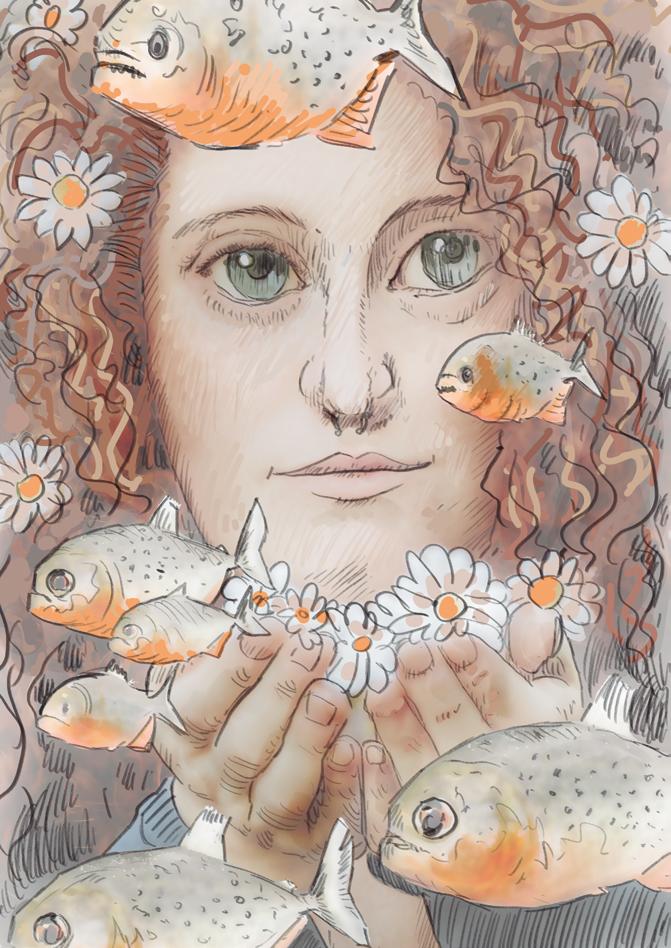
A note from the editor
Vanessa Byrne / Managing Director
Welcome to our wonderous March 2022 edition.
We, the people have to act against the rising temperatures of our earth and focus on how to save energy for our future generations. This month we celebrate Earth Hour Day. This is the initiative to fight against all the negatives and convert them into positives.
This is a worldwide campaign organized by WWF (World Wide Fund) held annually to encourage all to turn off electric lights that are not essential for one hour. The main motive is to raise awareness about climate change, increase in global warming and other environmental issues we are witnessing in recent years.
Locally, along with our friends at Whole Wild World and many other organizations, we have arranged various family friendly activities to help encourage the community lessen their carbon footprint on this very day. We have calculated all activities with the total distance, calories burnt (for those looking to trim the waist), duration and finally with a total of carbon footprint reduction achieved.
With this initiative we at OTWO join forces with other like-minded representatives and the Department of Sustainable Development to increase the scope and impact of this day. We hope that this year will be the beginning of an ever-increasing awareness and participation. These figures will serve to illustrate how easily we as individuals CAN make a difference and they will be targets to beat year upon year.
Keep an eye out in town for the posters and information for the 26th of March.
We are very excited to have teamed up with Motricity to create consultancy services both in Gibraltar and beyond to adapt our transport needs to new sustainable standards. These guys are geniuses when it comes to organizing and planning roads to adapt them for the new challenges ahead. We bring together their undoubted experience and expertise with our communications structure which is proving invaluable in the implementation of these very necessary measures. No doubt we will be working very closely with them in trying to shift the current situation locally to a more people friendly city. Much more information to follow in next month’s edition.
Sometimes in our journey to help develop a better way of life for all we come across special people that can portray a message beautifully in words and images. Our new collaborator Ainara Martínez Rodríguez is in my mind an important addition to this incredible team that is being thrust together by the need to act. Check out and enjoy her latest article on page 42.
What is evident since we first started our OTWO venture is a growing optimism that is surrounding us. Yes, we still have a big problem to fix, but I feel there is an awareness of the tools needed. Now I believe we can focus on the benefits and not just despair over the daunting task ahead.
As always, thank you all for your continuous support with us.
Peace and Love to all.
11 10
ILLUSTRATION:
JUANJO TRUJILLO
OTWO 32 / MARCH 2022
Una nota de la editora
Vanessa Byrne / Directora General
Bienvenidos a nuestra maravillosa edición de marzo de 2022.
Nosotros, la gente, tenemos que actuar contra el aumento de las temperaturas de nuestra tierra y centrarnos en cómo ahorrar energía para nuestras futuras generaciones. Este mes celebramos el Día de la Hora del Planeta. Se trata de una iniciativa para luchar contra todo lo negativo y convertirlo en positivo.
Esta campaña mundial organizada por el WWF (Fondo Mundial) que se celebra anualmente para animar a todos a apagar durante una hora las luces eléctricas que no sean imprescindibles. El motivo principal es concienciar sobre el cambio climático, el aumento del calentamiento global y otros problemas medioambientales a los que estamos asistiendo en los últimos años.
A nivel local, junto con nuestros amigos de Whole Wild World y muchas otras organizaciones, hemos organizado varias actividades familiares para ayudar a animar a la comunidad a reducir su huella de carbono en este mismo día. Hemos calculado todas las actividades con la distancia total, las calorías quemadas —para aquellos que buscan recortar la cintura—, la duración y, finalmente, con un total de reducción de la huella de carbono conseguida.
Con esta iniciativa, en la que OTWO une fuerzas con otros representantes afines y con el Departamento de Desarrollo Sostenible para aumentar el alcance y el impacto de este día. Esperamos que este año sea el comienzo de una concienciación y participación cada vez mayor. Estas cifras servirán para ilustrar la facilidad con la que nosotros, como individuos, podemos marcar la diferencia y serán objetivos a batir año tras año.
Esté atento a los carteles y las informaciones que colocaremos en la ciudad sobre el 26 de marzo.
Estamos muy contentos de habernos asociado con Motricity para crear servicios de consultoría tanto en Gibraltar como fuera de él para adaptar nuestras necesidades de transporte a los nuevos estándares sostenibles. Estos chicos son unos genios a la hora de organizar y planificar las carreteras para adaptarlas a los nuevos retos que se avecinan. Unimos su indudable experiencia y conocimientos con nuestra estructura de comunicación, que está resultando inestimable para la aplicación de estas medidas tan necesarias. No cabe duda de que trabajaremos muy estrechamente con ellos para intentar cambiar la situación actual a nivel local hacia una ciudad más amable con las personas. En la edición del mes que viene habrá más información al respecto.
A veces, en nuestro viaje para ayudar a desarrollar una mejor forma de vida para todos, nos encontramos con personas especiales que pueden retratar un mensaje maravillosamente en palabras e imágenes. Nuestra nueva colaboradora Ainara Martínez Rodríguez es, en mi opinión, una importante adición a este increíble equipo que se está reuniendo por la necesidad de actuar. Vea y disfrute su último artículo en la página 42.
Lo que es evidente desde que comenzamos nuestra aventura en la OTWO es el creciente optimismo que nos rodea. Sí, todavía tenemos un gran problema que solucionar, pero siento que hay una conciencia de las herramientas necesarias. Ahora creo que podemos centrarnos en los beneficios y no sólo desesperarnos por la ingente tarea que tenemos por delante.
Como siempre, gracias a todos por su continuo apoyo con nosotros.
Paz y amor para todos.

12
OTWO 32 / MARCH 2022 ILLUSTRATION: JUANJO TRUJILLO
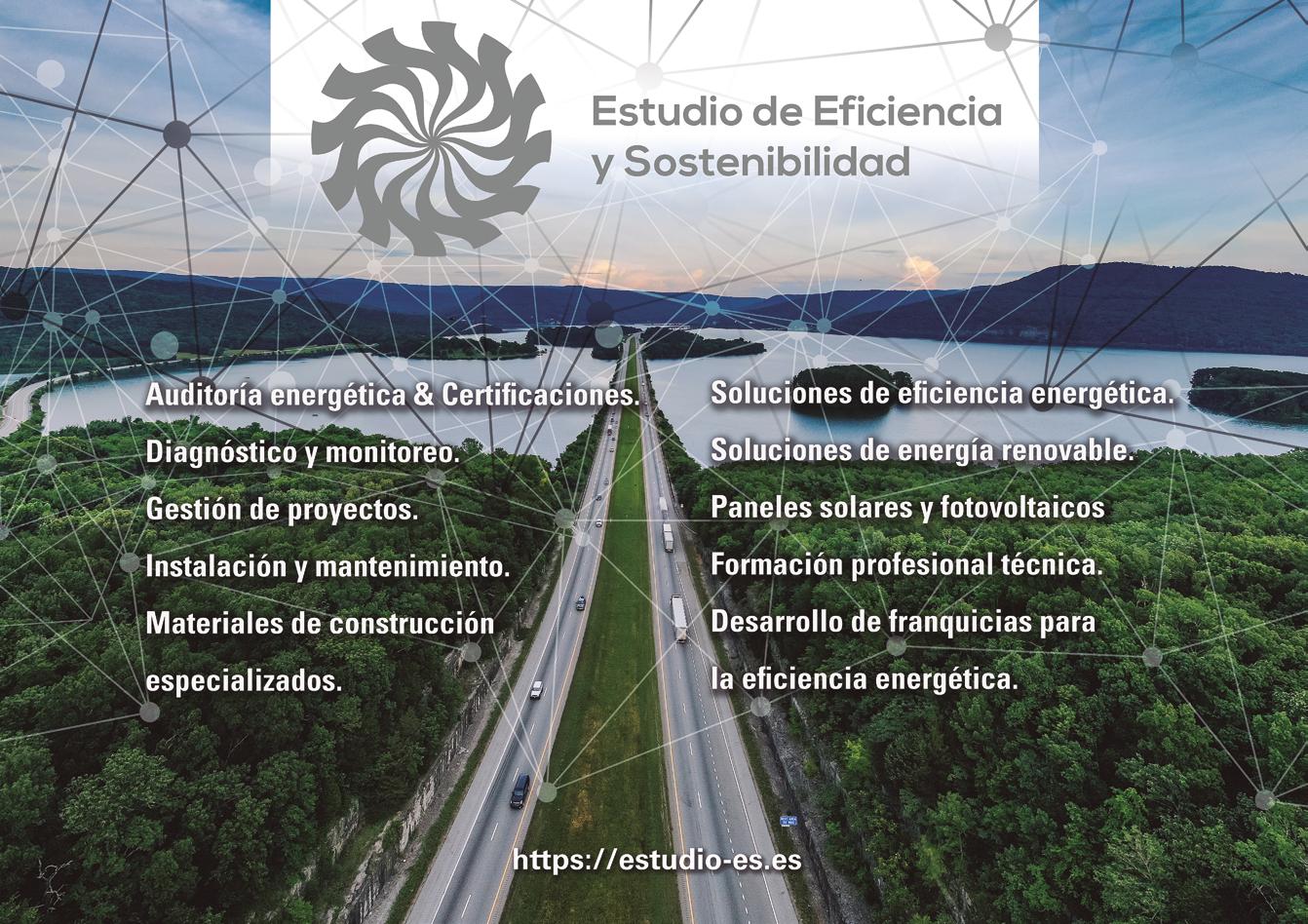
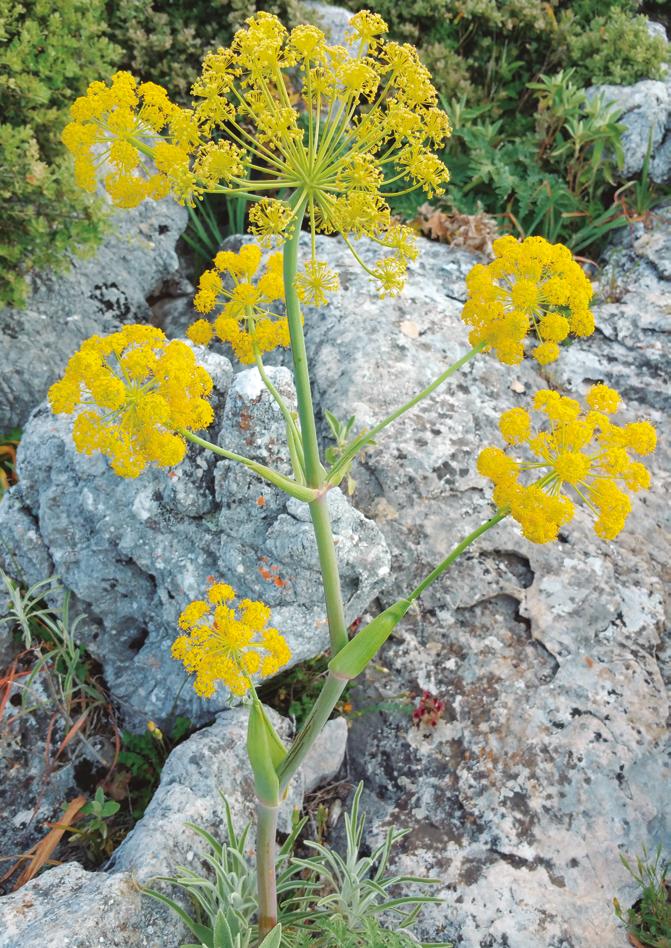

MARCH / Marzo
Collection “The flower of the month”
Ferula tingitana
Hinojo gigante de Tánger
Giant Tangier Fennel
Dr Keith Bensusan Director
Gibraltar Botanic Gardens, The Alameda.
There are a number of elements that help to make Gibraltar’s flora distinctive. Some species are found only in Gibraltar or have very restricted distributions, whilst others stand out for their abundance. The Giant Tangier Fennel is a large and particularly attractive umbellifer that is distributed in southern Iberia, North Africa and the Middle East. Although quite rare in the hinterland, it is very common in Gibraltar, where it favours open and rocky habitats. It can be a dominant component of some of these and it can be seen growing in the Gibraltar Botanic Gardens too. The Giant Tangier Fennel does not have colourful flowers. Its value as a garden plant lies instead in its extremely glossy and attractive foliage, and its tall flower spikes with a very interesting structure. It attracts many insects onto its nectar rich flowers and these in turn attract many birds, including refuelling migrants. Ferula tingitana is a member of the Carrot or Parsley family (Apiaceae), which includes some familiar species used for culinary purposes. The wild forms of probably the most well-known are found in Gibraltar: Wild Parsley Petroselinum crispum grows on cliffs and rocky slopes, whilst Wild Carrot Daucus carota is an extremely common plant of open spaces.
Hay una serie de elementos que contribuyen a hacer distintiva la flora de Gibraltar. Algunas especies sólo se encuentran en Gibraltar o tienen una distribución muy restringida, mientras que otras destacan por su abundancia. El hinojo gigante de Tánger es una umbelífera grande y especialmente atractiva que se distribuye por el sur de Iberia, el norte de África y Oriente Medio. Aunque es bastante rara en el interior, es muy común en Gibraltar, donde prefiere los hábitats abiertos y rocosos. Puede ser un componente dominante de algunos de ellos y también puede verse creciendo en los Jardines Botánicos de Gibraltar. El hinojo gigante de Tánger no tiene flores coloridas. Su valor como planta de jardín reside en cambio en su follaje extremadamente brillante y atractivo, y en sus altas espigas de flores con una estructura muy interesante. Atrae a muchos insectos a sus flores, ricas en néctar, que a su vez atraen a muchas aves, incluidas las migratorias. La Ferula tingitana pertenece a la familia de la zanahoria o el perejil (Apiaceae), que incluye algunas especies familiares utilizadas con fines culinarios. En Gibraltar se encuentran las formas silvestres de, probablemente, las más conocidas: El perejil silvestre Petroselinum crispum crece en acantilados y laderas rocosas, mientras que la zanahoria silvestre Daucus carota es una planta muy común de los espacios abiertos.
16
17
OTWO 32 / MARCH 2022 OTWO 32 / MARCH 2022
Photographs: Ruben0568

GIBRALTAR GOVERNMENT APPOINTS CLIMATE CHANGE COMMITTEE

The Gibraltar Government has announced the appointment of the Climate Change Committee, as outlined in the Climate Change Act published in 2019.
The Climate Change Committee has been established as an independent body to provide advice and assistance on matters to do with climate change, such as trading schemes, carbon budgets and mitigation and adaptation measures.
The Committee’s remit also includes providing scrutiny of Gibraltar’s plans to deliver emissions reduction targets and express views on any appropriate matters, including emissions reductions opportunities across all sectors. Any reports from the Climate Change Committee must be presented before Parliament.
The Committee is largely comprised of Climate Change experts from outside Gibraltar. Angelique Linares will be Chair, and Dr Darren Fa will be the other Gibraltar-based member. Committee Members based in the UK are Nicky Crawford, Nikki Kent, Dr Ali Mashayek and Nicola Webb.
The Minister for the Environment and Climate Change, the Hon Prof John Cortes, commented: “I am very pleased that we are now moving ahead with putting our Climate Change legislation into real effect, following the publication a few months ago of the Climate Change Strategy. This Committee of experts will be able to monitor our progress and advise on improving performance on our Climate Change targets and agenda. I was able to welcome the new members at their first meeting on Friday and am
very much looking forward to their input and help in ensuring that we achieve our climate change”.
El Gobierno de Gibraltar nombra un Comité de Cambio Climático
El Gobierno de Gibraltar ha anunciado el nombramiento del Comité de Cambio Climático, tal y como se recoge en la Ley de Cambio Climático publicada en 2019.
El Comité de Cambio Climático se ha establecido como un organismo independiente para proporcionar asesoramiento y asistencia en asuntos relacionados con el cambio climático, como los sistemas de comercio, los presupuestos de carbono y las medidas de mitigación y adaptación.
El mandato del Comité también incluye el escrutinio de los planes de Gibraltar para cumplir con los objetivos de reducción de emisiones y expresar opiniones sobre cualquier asunto apropiado, incluyendo las oportunidades de reducción de emisiones en todos los sectores. Todos los informes de la Comisión de Cambio Climático deben presentarse ante el Parlamento.
El Comité está compuesto en gran parte por expertos en cambio climático de fuera de Gibraltar. Angelique Linares será la presidenta y el Dr. Darren Fa será el otro miembro con sede en Gibraltar. Los miembros del Comité radicados en el Reino Unido son Nicky Crawford, Nikki Kent, el Dr. Ali Mashayek y Nicola Webb.
El Ministro de Medio Ambiente y Cambio Climá-

tico, el Honorable Profesor John Cortes, comentó: «Estoy muy satisfecho de que estemos avanzando en la puesta en práctica de nuestra legislación sobre el cambio climático, tras la publicación hace unos meses de la Estrategia sobre el Cambio Climático. Este Comité de expertos podrá supervisar nuestros progresos y asesorarnos para mejorar el cumplimiento de nuestros objetivos y nuestra agenda en materia de cambio climático. Tuve la oportunidad de dar la bienvenida a los nuevos miembros en su primera reunión, el viernes, y espero con gran interés sus aportaciones y su ayuda para garantizar la consecución de nuestros objetivos en materia de cambio climático».
PARIS TO LIMIT CARS IN CITY CENTRE FROM 2024
Vehicles will no longer be able to drive through the historical centre of Paris as from 2024. The plans, which were initially supposed to take effect this year, have been delayed by two years as more preparation time is needed to implement the plan.
Dubbed as the ‘tranquil zone’ (zone apaisée), the plans for the central districts intend to improve air quality, decrease traffic congestion and improve overall conditions in the capital ahead of the Paris Olympic Games in 2024.
The plans, however, do not constitute a complete ban of vehicles from entering the city centre but will discourage through traffic (cars travelling through the city centre to another destination), which according to the Paris Deputy Mayor, accounts for over half of all vehicle traffic in the area.
Exceptions will be made for those that live in the city centre and for delivery vehicles, those with disabilities, taxis and other transport such as buses and Uber. It is estimated that the plans would stop as many as 100,000 vehicles from entering the city centre each day.
The areas affected by the plans are the 1st to the 4th arrondissements. These central areas in Paris include famous landmarks such as Notre Dame Cathedral, the Centre Pompidou and the Louvre, as well as many of the city’s government buildings.
Over the last few years, Mayor Anna Hidalgo has
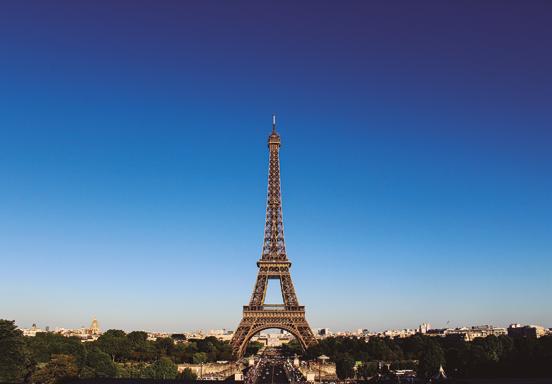
18 OTWO 32 / MARCH 2022 OTWO 32 / MARCH 2022 19
made various moves to make the French capital less car-centric and more cycle and pedestrian-friendly. The city has already banned heavily polluting diesel cars from entering parts of the centre, created more than 160 km of cycling lanes, pedestrianised parts of the walkways along the river Seine and limited cars entering other major thoroughfares.
París limitará los coches en el centro de la ciudad a partir de 2024
Los vehículos ya no podrán circular por el centro histórico de París a partir de 2024.
Los planes, que inicialmente debían entrar en vigor este año, se han retrasado dos años, ya que se necesita más tiempo de preparación para aplicar el plan.
Bautizado como «zona tranquila» (zone apaisée), los planes para los distritos centrales pretenden mejorar la calidad del aire, disminuir la congestión del tráfico y mejorar las condiciones generales de la capital de cara a los Juegos Olímpicos de París de 2024.
Los planes, sin embargo, no constituyen una prohibición total de la entrada de vehículos al centro de la ciudad, sino que desalentarán el tráfico de paso (coches que atraviesan el centro de la ciudad para ir a otro destino), que, según el teniente de alcalde de París, representa más de la mitad del tráfico de vehículos en la zona.
Se harán excepciones para los que viven en el centro de la ciudad y para los vehículos de reparto, los discapacitados, los taxis y otros transportes como los autobuses y Uber. Se calcula que los planes impedirían la entrada de hasta 100.000 vehículos al centro de la ciudad cada día.
Las zonas afectadas por los planes son los distritos 1 a 4. En estas zonas céntricas de París se encuentran lugares emblemáticos como la Catedral de Notre Dame, el Centro Pompidou y el Louvre, así como muchos de los edificios gubernamentales de la ciudad.
En los últimos años, la alcaldesa Anna Hidalgo ha tomado varias medidas para hacer que la capital francesa esté menos centrada en el coche y sea más favorable a los ciclistas y peatones. La ciudad ya ha prohibido la entrada de los coches diésel, muy contaminantes, en algunas zonas del centro, ha creado más de 160 km de carriles para bicicletas, ha peatonalizado partes de los paseos a lo largo del
río Sena y ha limitado la entrada de coches en otras vías principales.
GHOST VILLAGE EMERGES FROM RESERVOIR AS DROUGHT WORSENS IN SPAIN

Severe drought in northwest Spain has caused a large dam to nearly dry out, revealing a village that has been submerged underwater for 30 years.
Back in 1992, the village of Aceredo in Galicia was abandoned and subsequently flooded to create the Alto Lindoso reservoir. But in early February, due to the prolonged and worsening drought affecting Spain and Portugal, authorities ordered six dams to practically stop water use for electricity production and irrigation, including the Alto Lindoso reservoir.
As the reservoir dried out to just 15% of its maximum capacity, the haunting ruins of the village revealed themselves. Dilapidated structures of old homes, cafes, old water fountains and stranded cars lie crumbling on the dried and cracking muddy ground, which was just days ago at the bottom of a human-made lake. The site has drawn many visitors to the area to explore the eerie village frozen in time.
In the last three months of 2021, Spain recorded just 35% of the average rainfall during the same period between 1981-2010. The first couple of months of 2022 has also seen practically no rain, with the first months of this year declared the second driest in almost a century.
According to Spain’s national weather agency AEMET, only in 2005 has there been a January with almost no rain in this century. If there is no significant rainfall in the next few weeks, emergency funding will be needed to support farmers.
Data from the Environment ministry show that reservoirs in the country are at just 44% capacity, much lower than the average of around 61% over the last decade.
In Andalucía, the valley around the Guadalquivir River was declared under prolonged drought in November. Seven parts of the basin are in an emergency drought situation, and another ten are on alert. Experts have described the situation as critical in many provinces, including Malaga, where authorities have asked residents and businesses to limit water consumption.

Un pueblo fantasma emerge del embalse mientras la sequía se agrava en España
La grave sequía en el noroeste de España ha provocado que una gran presa esté a punto de secarse, dejando al descubierto un pueblo que ha estado sumergido bajo el agua durante 30 años.
En 1992, el pueblo de Aceredo, en Galicia, fue abandonado y posteriormente inundado para crear el embalse del Alto Lindoso. Pero a principios de febrero, debido a la prolongada y creciente sequía que afecta a España y Portugal, las autoridades ordenaron que seis embalses dejaran prácticamente de utilizar el agua para la producción de electricidad y el riego, incluido el embalse del Alto Lindoso. Cuando el embalse se secó hasta alcanzar sólo el 15% de su capacidad máxima, se revelaron las inquietantes ruinas del pueblo. Estructuras dilapidadas de viejas casas, cafés, antiguas fuentes de agua y coches varados yacen desmoronados sobre el suelo de barro seco y agrietado, que hace unos días estaba en el fondo de un lago artificial. El lugar ha atraído a muchos visitantes a la zona para explorar el inquietante pueblo congelado en el tiempo.
En los últimos tres meses de 2021, España registró apenas el 35% de la media de lluvias del mismo periodo entre 1981-2010. En los dos primeros meses de 2022 tampoco ha llovido prácticamente nada, y los primeros meses de este año han sido declarados los segundos más secos en casi un siglo.
Según la Agencia Estatal de Meteorología (AEMET), sólo en 2005 ha habido un mes de enero casi
sin lluvias en este siglo. Si no se producen precipitaciones significativas en las próximas semanas, se necesitarán fondos de emergencia para ayudar a los agricultores.
Los datos del ministerio de Medio Ambiente muestran que los embalses del país están a sólo el 44% de su capacidad, muy por debajo de la media de alrededor del 61% de la última década.
En Andalucía, el valle que rodea al río Guadalquivir fue declarado en sequía prolongada en noviembre. Siete zonas de la cuenca están en situación de emergencia por sequía, y otras diez están en alerta. Los expertos han calificado la situación de crítica en muchas provincias, incluida Málaga, donde las autoridades han pedido a los residentes y a las empresas que limiten el consumo de agua.
THE NAUTILUS PROJECT MARKS 5TH ANNIVERSARY WITH GREAT GIBRALTAR BEACH CLEAN MARATHON.
Local Marine NGO, The Nautilus Project celebrated the fifth anniversary of its Great Gibraltar Beach Cleans by undertaking a beach cleaning marathon on 18th February.
The marathon, which ran for six hours, saw various companies and individuals volunteer to spend the day cleaning eight different coastal sites around Gibraltar. The day began at Rosia Bay at 9 am and ended at Western Beach at 4 pm, with a whopping 690kg of waste collected throughout the day.

21 20 OTWO 32 / MARCH 2022 OTWO 32 / MARCH 2022
The Nautilus Project took to social media to thank everyone involved, “TNP extend their most heartfelt gratitude to all those that took time out of their day to volunteer - a heartwarming display of civic pride and solidarity. Special thanks to Nene from EcoPark who followed the trail retrieving the debris and David who diligently weighed it all for us! Shout out to young #MedOceanHero Malcolm, who on his inservice, remained with us throughout the whole day. Inspiring!”
Over the past five years, TNP has organised 76 Great Gibraltar Beach Cleans. The total amount of rubbish removed from Gibraltar’s coastline during those clean-ups amounts to a massive 4.5 tonnes!
El Proyecto Nautilus celebra su quinto aniversario con el Gran Maratón de Limpieza de la Playa de Gibraltar.
La ONG local The Nautilus Project celebró el quinto aniversario de su Gran Limpieza de Playas de Gibraltar con un maratón de limpieza de playas el 18 de febrero.
El maratón, que duró seis horas, contó con la par-
ticipación de varias empresas y particulares que se ofrecieron como voluntarios para pasar el día limpiando ocho lugares costeros diferentes de Gibraltar.
La jornada comenzó en Rosia Bay a las 9 de la mañana y terminó en Western Beach a las 4 de la tarde, con la friolera de 690 kg de residuos recogidos a lo largo del día.
El Proyecto Nautilus se hizo eco de las redes sociales para dar las gracias a todos los participantes: «TNP extiende su más sincera gratitud a todos los que sacaron tiempo de su día para ser voluntarios. Una muestra conmovedora de orgullo cívico y solidaridad. Un agradecimiento especial a Nene, de EcoPark, que siguió el rastro recuperando los escombros, y a David, que pesó diligentemente todo para nosotros. Un saludo al joven #MedOceanHero Malcolm, que, en su servicio, permaneció con nosotros durante todo el día. ¡Inspirador!».
En los últimos cinco años, el TNP ha organizado 76 Grandes Limpiezas de Playa de Gibraltar. ¡La cantidad total de basura retirada de la costa de Gibraltar durante esas limpiezas asciende a la enorme cantidad de 4,5 toneladas!
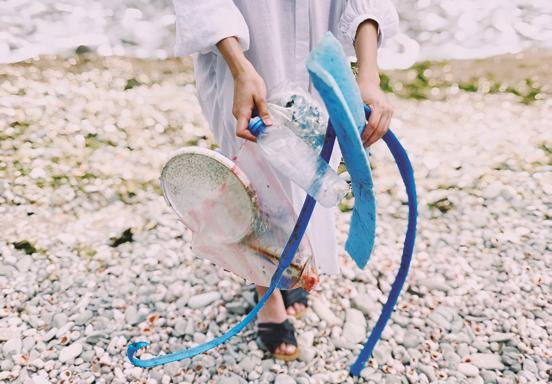


RAQUEL COLLANTE CHOSEN FOR THE IV COCA-COLA WOMEN 2022 TOUR
Our new collaborator Raquel Collante, from Algeciras and resident of San Roque has managed to make a place in the IV Coca-Cola Women Tour 2022 with her project “Reason of Nature”.
It is the realization of Shinrin Yoku (Forest Baths) Japanese therapy for health improvement, a natural way to relieve stress, lower blood pressure and countless benefits.
In addition, Raquel promotes the use and cultivation of multifunctional plants (non-conventional food plants) that support the garden, are medicinal and are a strategy to fight climate change.
She told us that she feels proud and grateful for the training opportunity that comes with participating in the ‘I want to undertake’ edition.
After the training sessions, mentoring and advice, a specialized jury will select the 24 finalist projects, from which the four winners will be chosen. Raquel, if selected, will receive 5,000 euros in seed capital to materialize her dreams or make them grow.
A purely professional and personal empowerment initiative. Because it is very difficult, if not practically impossible, for women, and anyone else, to build their own project if they do not believe in themselves first.
Raquel Collante elegida para la IV Gira Mujeres Coca-Cola 2022
Nuestra nueva colaboradora Raquel Collante, algecireña y residente en San Roque ha logrado hacerse un hueco en la IV Gira Mujeres Coca-Cola 2022 con su proyecto «Razón de Naturaleza».
Se trata de la realización de Shinrin Yoku (Baños de Bosques) terapia japonesa para la mejora de la salud, una manera natural de aliviar el estrés, bajar la presión arterial e infinidad de beneficios.
Además, Raquel promueve el uso y cultivo de las plantas multifuncionales (plantas alimenticias no convencionales) que sirven de apoyo en el huerto, son medicinales y suponen una estrategia de lucha contra el cambio climático.
Nos ha contado que se siente orgullosa y agradecida por la oportunidad formativa que conlleva participar en la edición «Quiero emprender».
23 22 OTWO 32 / MARCH 2022 OTWO 32 / MARCH 2022

Terminadas las sesiones de formación y las mentorías y asesorías, un jurado especializado seleccionará los 24 proyectos finalistas, entre los que se elegirán los cuatro ganadores. Raquel si sale seleccionada, recibirá 5.000 euros de capital semilla para materializar sus sueños o hacerlos crecer.
Una iniciativa puramente profesional y de empoderamiento personal. Porque es muy difícil, por no decir prácticamente imposible, que las mujeres, y cualquier persona, levanten un proyecto propio si antes no creen en ellas mismas.
PEDALING TOWARDS A SUSTAINABLE FUTURE
Current traffic and urban mobility patterns necessitate considering the bicycle as a mode of transportation capable of meeting the difficulties of urban sustainability. In this regard, the best way is to integrate the use of bicycles in the city with other modes of urban transportation in a logical and coordinated manner.
To offer this type of services and solutions, the publishing company of OTWO Magazine, Oxygene Communications LTD, and the company Motricity have signed an agreement to position themselves at the forefront of these proposals.
The Motricity team has been involved in the drafting of documents related to facilities and spaces for sport and physical activity, healthy urban environments, sustainable mobility and cycling, contributing to the development of active cities.
It is already undeniable that OTWO Magazine has become the reference publication on environmental issues in this part of Europe and North Africa. With a significant increase in readership, recognitions and awards, agreements with important institutions such as COAMBA (College of Environmentalists of Andalusia) or its incorporation into the SICA (Scientific Research Service of Andalusia) make our magazine a benchmark for information, outreach and strategic positioning of the sector.
Among its innovative and much needed services we can highlight research for the design of sustainable urban solutions and active mobility based on data analysis and qualitative studies; advice on planning and management policies for cities with sustainable land use and transport models; studies on the social and environmental effects of cycling and
the coordination of citizen laboratories, actions to promote healthy habits and active modes of travel: to school, to work, home or sightseeing; the design of non-motorized itineraries and drafting of active mobility implementation projects, mainly cycling routes or training on the implementation of smarter decisions in the field of active tourism (hiking and cycling).
The agreement was signed by Vanessa Byrne, managing director of OTWO Magazine and José Antonio Duarte as manager of Motricity. Both were accompanied by Juanjo Trujillo, our creative and technical director. Pedaling towards a sustainable future
Pedaleando hacia un futuro sostenible.
Las tendencias actuales del tráfico y la movilidad urbana obligan a considerar la bicicleta como un medio de transporte capaz de responder a los retos de la sostenibilidad en las ciudades. En este sentido, lo más adecuado es acercarse a la incorporación del uso de la bicicleta en la ciudad de forma coherente y coordinada con el resto de medios de transporte urbano.
Para ofrecer este tipo de servicios y soluciones la compañía editora de OTWO Magazine, Oxygene Communications LTD, y la empresa Motricity han firmado un acuerdo para posicionarse a la vanguardia de estas propuestas.
El equipo de Motricity ha participado en la redacción de documentos relacionados con las instalaciones y espacios para el deporte y la actividad física, los entornos urbanos saludables, la movilidad sostenible y la bicicleta, contribuyendo al desarrollo de ciudades activas.
Ya es innegable que OTWO Magazine se ha convertido en la publicación de referencia en temas medioambientales por esta parte de Europa y del norte de África. Con un aumento de significativo de lectores, los reconocimientos y premios, los acuerdos con importantes instituciones como COAMBA (Colegio Ambientólogos de Andalucía) o su incorporación el el SICA (Servicio de Investigación Científica de Andalucía) convierten a nuestra revista en un referente de la información, la divulgación y el posicionamiento estratégico del sector.
Entre sus novedosos y tan necesarios ofertas de servicios podemos destacar la investigación para el
diseño de soluciones urbanas sostenibles y de movilidad activa a partir del análisis de datos y estudios cualitativos; el asesoramiento en políticas de planificación y ordenación de ciudades con modelos de usos del suelo y transportes sostenibles; los estudios sobre los efectos sociales y ambientales del uso de la bicicleta y la coordinación de laboratorios ciudadanos, las acciones de promoción de hábitos saludables y modos de desplazamiento activo: a la escuela, al trabajo, a casa o de visita turística; el
diseño de itinerarios no motorizados y redacción de proyectos de ejecución de movilidad activa, principalmente vías ciclistas o la formación sobre la aplicación de decisiones más inteligentes en el ámbito del turismo activo (senderismo y ciclismo). El acuerdo se firmó por Vanessa Byrne, directora gerente de OTWO Magazine y José Antonio Duarte como gerente de Motricity. Ambos acompañados por Juanjo Trujillo nuestro director creativo y técnico. Pedalendo hacia un futuro sostenible.

25 24 OTWO 32 / MARCH 2022 OTWO 32 / MARCH 2022
The Senegal Appeal
Help us to Help Them!!
#reuse#savingourenviroment#sustainability#letsturnthisaround #recycle#greenchoice#earthmatters
Since 2015 we are very proud to say that Metalrok Ltd has been providing Gibraltar with a Recycling Service at the premises delivered by the government of Gibraltar Ecopark which is a joint public and private partnership located at 8 Flint Road. There has been an increase in Recycling but even so our daily waste stream contains goods which are perfectly suited to be reused not been recycled ending up in the landfill polluting the environment.
Together we can turn this around by reusing, preventing pollution, reducing usage of raw materials, sustaining the environment for future generations thus preventing them from ending in landfill and sea.
There is a need for these items in places like Senegal in West Africa were there are areas of extreme Poverty. with your cooperation we would like to meet their necessities by helping to provide them with donated unwanted items like:
All Clothing, Furniture inc Mirrors, Linen, household items, toys, office equipment, medical equipment electro domestics, bicycles, scooters, books. Car seats, doors windows, sinks, Showers, toilets.
We are collecting items that are still good for purpose and in usable condition in a bid to give them a new lease of life. Kindly take note that we will not make ourselves responsible for the collection of broken down items. The circumstances these people unfortunately live in deserve a sense of dignity and pride. Please only get in touch for items that will enhance and enrich their livelihoods.
Drop of points are:
Nanot Ltd 27 New Harbours: Mon To Fri from 10am to 3pm.
Ecopark 8 Flint Road: every day from 8am to 8pm.
Collections Mon to Fri 5pm to 7pm pre booked only ( Sat only Prebooked) this may change depending on demand. Is limited to more than 5 bags or large items only please send pics post collection.
WATSAPP ONLY: No 00350 56003361
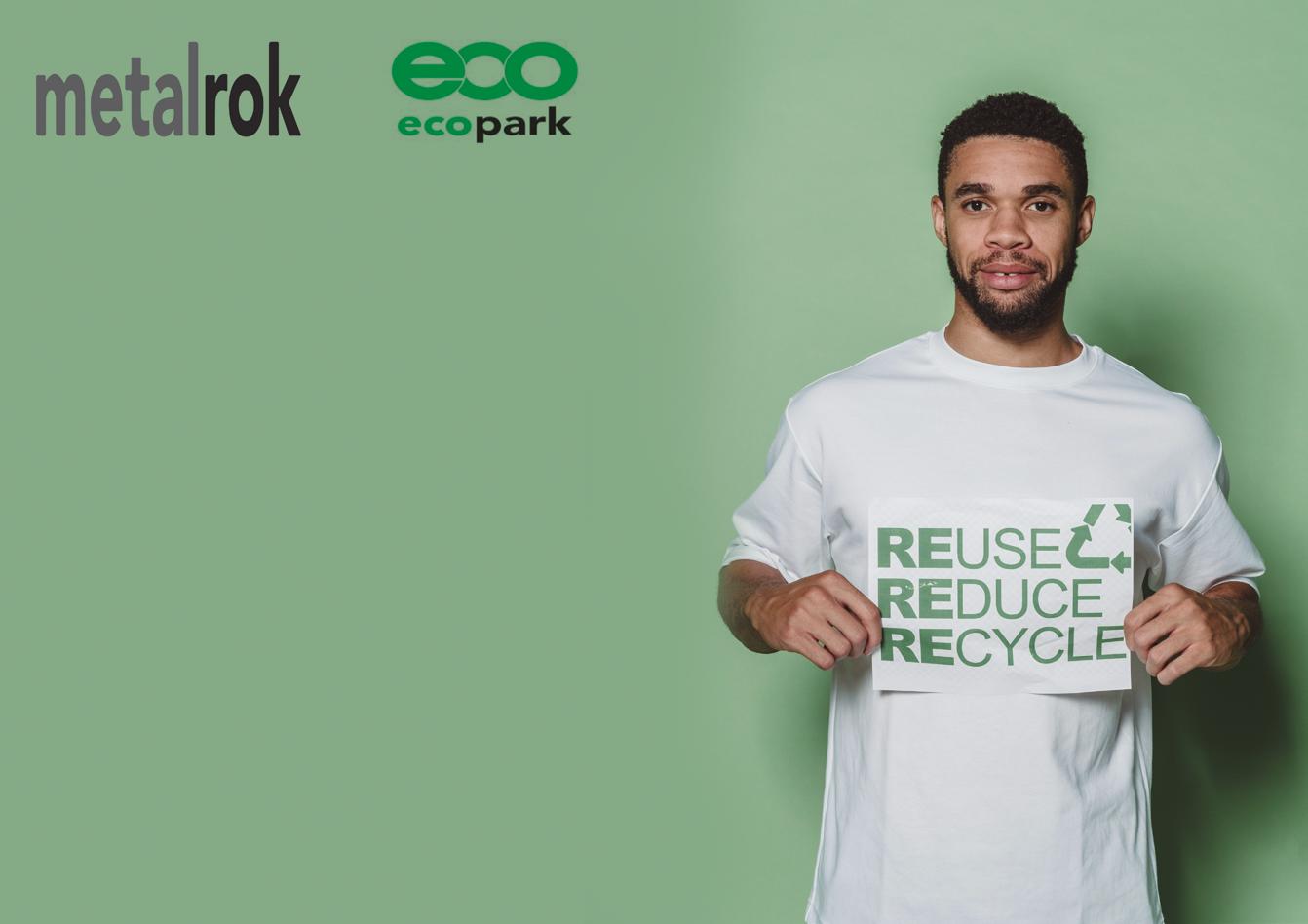
A Chat with Melanie Soiza Stagnetto
Nautilus Costume Bank. Another amazing initiative by the Nautilus crew.
Una charla con Melanie Soiza Stagnetto. Banco de disfraces de Nautilus. Otra increíble iniciativa del equipo de Nautilus.
How did you make a decision to launch the initiative to start collecting donations of the costumes for World Book Day?
I played a very active part of the PTA’s whilst my children attended both Lower and Upper primary schools. Circular fashion and environmentally friendly events were always at the heart of my time spent volunteering in the schools. Now that my children are in Secondary School, I guess this in an extension of what I have been working on for the last few years; the upcycling of costumes, uniforms, books and educational games within the school environment, in a bid to reduce waste and help families that are unable to afford these cyclic costs. Here in Gibraltar and especially the UK, World Book Day is a very popular event, with an article in 2019 stating that parents can spend up to £100 on a costume for just one day. Not only is this a lot of money but also the children will grow out of the costumes quickly, so may not be able to use the following year. Therefore is your aim to cut the costs and also unnecessary buying and wastage?
Absolutely! As a mum of two boys, I am fully aware of the recurring expenses and the pressure of searching for the right costume for WBD. These costumes are usually just used once and at a vast economic and environmental expense. It is of utmost
¿Cómo tomó la decisión de poner en marcha la iniciativa de recoger donaciones de disfraces para el Día Mundial del Libro?
Participé muy activamente en la Asociación de Padres de Alumnos (APA) mientras mis hijos asistían a las escuelas primarias inferiores y superiores. La moda circular y los eventos respetuosos con el medio ambiente fueron siempre el centro de mi tiempo de voluntariado en los colegios. Ahora que mis hijos están en la escuela secundaria, supongo que esto es una extensión de lo que he estado trabajando en los últimos años; el upcycling de trajes, uniformes, libros y juegos educativos en el entorno escolar, en un intento de reducir los residuos y ayudar a las familias que no pueden permitirse estos costes cíclicos.
Aquí en Gibraltar y especialmente en el Reino
Unido, el Día Mundial del Libro es un evento muy popular, en un artículo de 2019 se afirma que los padres pueden gastar hasta 100 libras en un disfraz para un solo día. No solo es mucho dinero, sino que además los niños crecerán y no puedrán usarlos al año siguiente. Por lo tanto, ¿su objetivo es reducir los costes y también las compras innecesarias y el despilfarro?
Por supuesto. Como madre de dos niños, soy plenamente consciente de los gastos recurrentes y de la presión que supone buscar el disfraz adecuado para
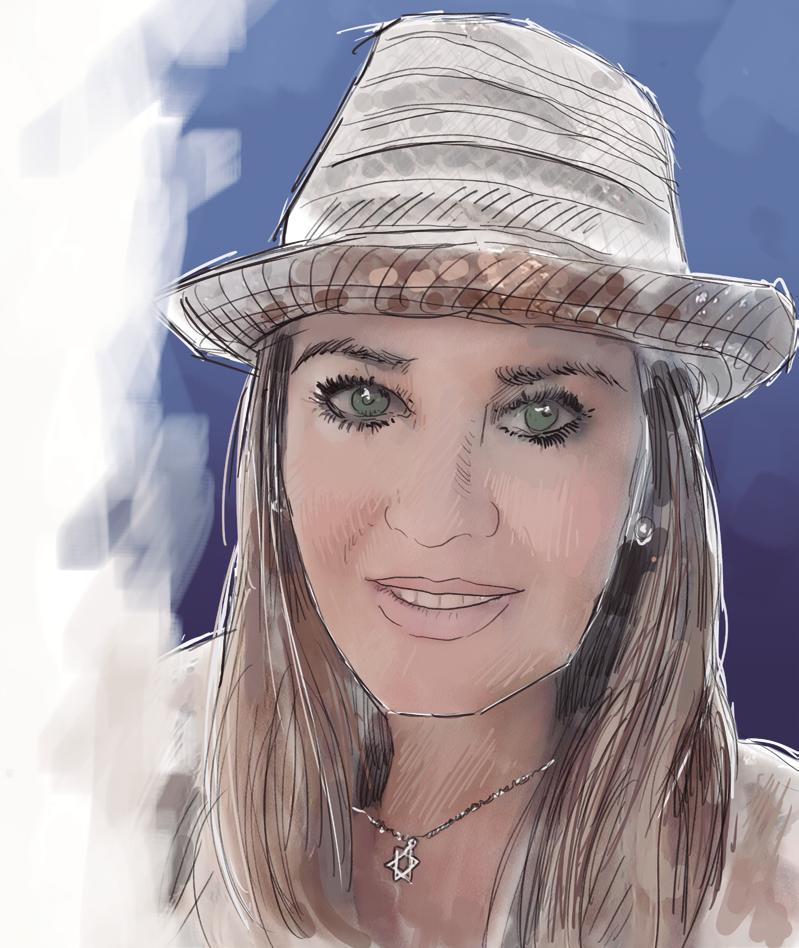
OTWO 32 / MARCH 2022 29 28 OTWO 32 / MARCH 2022
ILLUSTRATION: JUANJO TRUJILLO

importance to give these items a new lease of life. Circular fashion prompts the effective and responsible circulation of items within the society until they eventually reach the end of their cycle. How many donations have you received already and how many would you like to receive? Do you have a target?
As a new initiative just launched to the community at large, it is still early days to set a target. Ideally, we would like to reach a point where parents no longer have the stress or financial strain of sourcing a yearly costume, especially when families have more than one child to cater for. Further, the environment will benefit greatly from this initiative with an end goal of avoiding unnecessary waste ending up in landfill. Some donations have already started to trickle in with some parents even donating a costume they no longer need for one from the Costume Bank. A great swap!
If people want to donate costumes how can they do this, and how can they then borrow the costumes once World Book Day is almost here? We can be reached on any of The Nautilus Project social platforms. Our young group of #MedOceanHeroes are fully onboard and ready to collect and deliver; on shanks pony may I add!
We have various offerings whereby parents can borrow a costume and then return it, donate costumes their children have outgrown, swap their outgrown costumes for any at the Nautilus Costume Bank, or even keep a costume and give the charity a donation of their choice if they so wish. We have experienced all of these already so the initiative is actually going with the flow with what the community is requesting. Is there anything else you would like to add?
I would encourage readers to take this opportunity to have a good rummage through their wardrobes. It is always a good time for a thorough Spring Clean and we are here waiting to take all your preloved costumes. I strongly believe that as a community, we can turn the tide and work together for the good of our environment.
el Día Mundial del Niño. Estos disfraces suelen usarse una sola vez y con un enorme gasto económico y medioambiental. Es muy importante dar una nueva vida a estos artículos. La moda circular fomenta la circulación eficaz y responsable de los artículos en la sociedad hasta que llegan al final de su ciclo. ¿Cuántas donaciones ha recibido ya y cuántas le gustaría recibir? ¿Tienen un objetivo?
Al tratarse de una nueva iniciativa que se acaba de lanzar a la comunidad en general, aún es pronto para establecer un objetivo. Lo ideal sería llegar a un punto en el que los padres ya no tuvieran el estrés o la presión financiera de buscar un disfraz anual, especialmente cuando las familias tienen más de un hijo al que atender. Además, el medio ambiente se beneficiará enormemente de esta iniciativa con el objetivo final de evitar que residuos innecesarios acaben en el vertedero.
Ya han empezado a llegar algunas donaciones y algunos padres han donado un disfraz que ya no necesitan por uno del Banco de Disfraces. ¡Un gran intercambio!
Si la gente quiere donar disfraces, ¿cómo pueden hacerlo y cómo pueden tomar prestados los disfraces una vez llegado el Día Mundial del Libro?
Pueden contactarnos en cualquiera de las plataformas sociales del Proyecto Nautilus. Nuestro joven grupo de #MedOceanHeroes está totalmente a bordo y listo para recoger y entregar; ¡en pony de zancos si me permite añadir!
Tenemos varias ofertas por las que los padres pueden pedir prestado un disfraz y luego devolverlo, donar los disfraces que a sus hijos se les han quedado pequeños, cambiar sus disfraces superados por cualquiera en el Banco de Disfraces Nautilus, o incluso quedarse con un disfraz y dar a la caridad una donación de su elección si así lo desean. Ya hemos experimentado todo esto, por lo que la iniciativa está siguiendo la corriente de lo que pide la comunidad. ¿Hay algo más que le gustaría añadir?
Animo a los lectores a que aprovechen esta oportunidad para rebuscar en sus armarios. Siempre es un buen momento para hacer una limpieza primaveral a fondo y aquí estamos esperando para llevarnos todos sus disfraces preciados. Creo firmemente que, como comunidad, podemos cambiar la situación y trabajar juntos por el bien de nuestro medio ambiente.
OTWO 32 / MARCH 2022 31 30 OTWO 32 / MARCH 2022
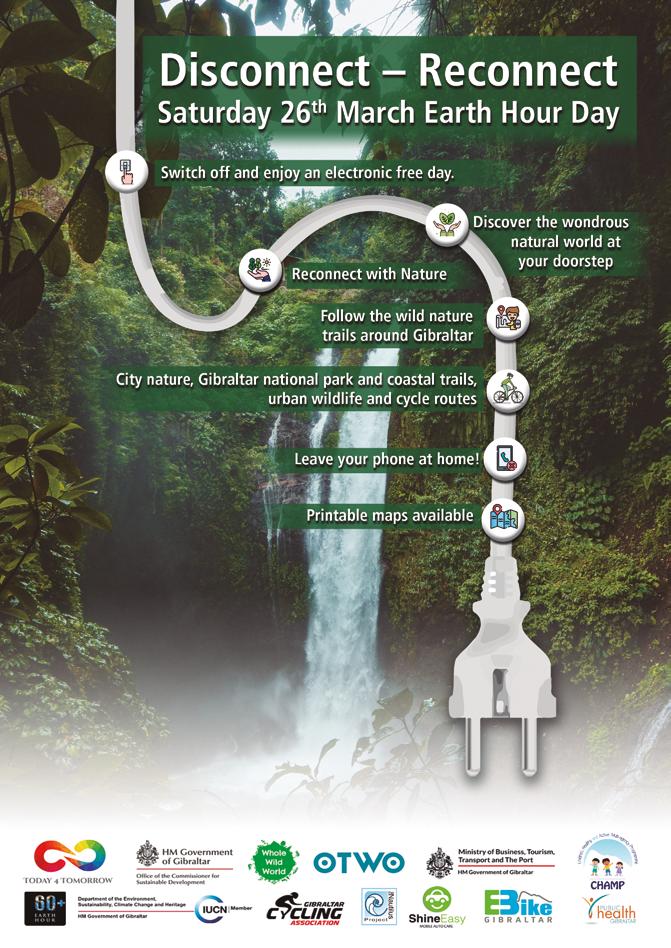


The oriental hornet in the Campo de Gibraltar
El avispón oriental en el Campo de Gibraltar María del Carmen Fajardo
OTWO 32 / MARCH 2022 35 34 OTWO 32 / MARCH 2022
Photography: Carlos del Pico

I am a retired biology teacher and I collaborate with Biodiversidad Virtual, a citizen science network.
One afternoon in October 2018, when I was depositing garbage in the organic garbage can on my street, in Algeciras, I found a striking hornet. It was about 3 cm long and had a nice yellow band on its abdomen.
A month before I had photographed a group of native hornets, Vespa crabro, in a cork oak grove in Castellar de la Frontera.
Clearly, it was another species and this was confirmed to me by an expert in wasps from Biodiversidad Virtual, Leopoldo Castro, who identified it as Vespa orientalis, the oriental hornet, an exotic species with invasive potential, and advised me to inform the authorities.
I did so, both at municipal and regional level. From the Regional Ministry, they informed me that in 2012, they arrived at a park in Valencia, apparently from its port and after their elimination, they were never heard of again. They hoped that they were not adapted to our climate.
The species has a natural range associated with a semi-arid climate from the eastern Mediterranean, Israel, Jordan, Greece, Romania, Bulgaria, Albania and as far south as Italy. Also in Algeria, Libya, Egypt, up to the horn of Africa. Also in Iran, Pakistan, northern India and Nepal.
However, in that autumn I was able to know other testimonies of their presence in Algeciras, even when visiting some dependencies of the city coun-
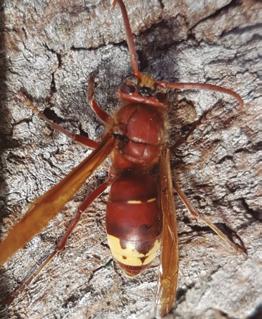
Soy una profesora de Biología jubilada y colaboro con Biodiversidad Virtual, una red de ciencia ciudadana.
Una tarde de octubre de 2018, cuando depositaba basura en el contenedor de orgánicos de mi calle, en Algeciras, encontré un llamativo avispón. Medía unos 3 cm y tenía una bonita banda amarilla en su abdomen.
Un mes antes había fotografiado un grupo de avispones autóctonos, Vespa crabro, en un alcornocal de Castellar de la Frontera.
Claramente se trataba de otra especie y así me lo confirmó un experto en avispas de Biodiversidad Virtual, Leopoldo Castro, identificándola como Vespa orientalis, el avispón oriental, una especie exótica y con potencial invasivo, aconsejándome que lo comunicara a las autoridades.
Así lo hice, tanto a nivel municipal como autonómico. Desde la Consejería me informaron de que en 2012 llegó a un Parque de Valencia, parece ser que desde su puerto y tras su eliminación no se volvió a saber de ellos. Esperaban que no se adaptaran a nuestro clima.
La especie tiene un área natural de distribución asociada a un clima semiárido desde el Mediterráneo oriental, Israel, Jordania, Grecia, Rumanía, Bulgaria, Albania y hasta el sur de Italia. También en Argelia, Libia, Egipto, hasta el cuerno de África. Asimismo en Irán, Pakistán, norte de la India y Nepal.
Pero en aquel otoño pude conocer otros testimonios de su presencia en Algeciras, incluso al visitar unas dependencias del ayuntamiento para informar
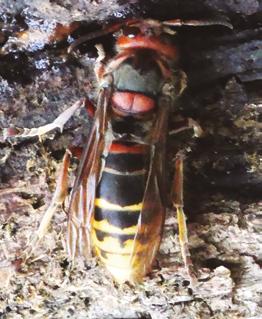
cil to inform the councilor of health on the subject, I knew of the recent invasion that they had suffered and that needed a service of pest control.
I was reporting all this to Íñigo Sánchez, a renowned biologist of the Sociedad Gaditana de Historia Natural, of which I am a member. In February 2019, he published an article in the journal of this entity with the first Vespa orientalis sighting in Andalusia.
Winter passed and at the beginning of spring, we saw again hornets and evidence of their nests. These are recognized by the entry and exit of individuals from a crack in the ground or in buildings, where they remain hidden.
That year, 2019, only the presence of the eastern hornet is documented in the arc of the bay: Algeciras, Los Barrios, San Roque and La Línea. It is obtained through the web at national level Wasp Map created recently and the digital press, estrecho.8directo.com and algecirasalminuto.es.
In elestrecho.8directo.com I published a comparative scheme with the European hornet (6). In addition, in the magazine Almoraima, of the Instituto de Estudios Campogibraltareños I presented an article with all these data.
At the end of 2019, the Ministry of Agriculture, Livestock, Fisheries and Sustainable Development of the Junta in a document on the management of exotic species, made some recommendations against the oriental hornet.
The first one, to make citizens aware of this new species. Nevertheless, it seems that it did not

a la concejala de salud sobre el tema, supe de la invasión reciente que habían sufrido y que necesitó de un servicio de control de plagas.
Fui informando de todo esto a Íñigo Sánchez, reconocido biólogo de la Sociedad Gaditana de Historia Natural, de la que formo parte. En febrero de 2019 publicó un artículo en la revista de esta entidad con la primera cita para Andalucía de la Vespa orientalis.
Pasó el invierno y al comienzo de la primavera volvimos a ver avispones y evidencias de sus nidos. Estos se reconocen por la entrada y salida de individuos de una grieta en el suelo o en edificios, donde permanecen ocultos.
Ese año, 2019, solo se documenta la presencia del avispón oriental en el arco de la bahía: Algeciras, Los Barrios, San Roque y La Línea. Se consigue a través de la web a nivel nacional Mapa de Avispas creada recientemente y a la prensa digital, estrecho. 8directo.com y algecirasalminuto.es.
En elestrecho.8directo.com publiqué un esquema comparativo con el avispón europeo. Y en la revista Almoraima, del Instituto de Estudios Campogibraltareños presenté un artículo con todos esos datos.
Terminando 2019, la Consejería de Agricultura, Ganadería, Pesca y Desarrollo Sostenible de la Junta en un documento sobre la gestión de especies exóticas, hizo unas recomendaciones frente al avispón oriental. La primera, dar a conocer a los ciudadanos esta nueva especie. Pero parece que no tuvo éxito. En el verano de 2021 un portavoz municipal de la zona hablaba a la prensa de las molestias ocasionadas por
36 OTWO 32 / MARCH 2022 OTWO 32 / MARCH 2022 37
Vespa orientalis.. Photography:
M. Carmen Fajardo.
Vespa orientalis. Photography: M. Carmen Fajardo.
Vespa crabro. Photography: M. Carmen Fajardo.
Vespa crabro. Photography: Toni Coyle.

succeed. In the summer of 2021, a local municipal spokesperson told the press about the nuisance caused by “the Asian or killer wasp”. He confused Vespa orientalis with Vespa velutina, which has been thriving in the northern peninsular since 2010.
Instructions were given to educational centers; they warned of the danger in the elimination of nests, which must be done by competent personnel. City councils will do it in schools and public spaces and individuals will have to turn to pest control companies when they nest in their homes (shutter boxes, exhaust pipes or gardens).
Finally, gardening, construction and agricultural cooperatives were warned of the need to inspect the area where machinery that generates vibrations (lawn mowers, drills, etc.) is to be used because it would be very dangerous near a nest. These hornets, which in isolation do not sting if left undisturbed, will sting near their nest.
In 2020, the year of the pandemic, there were multiple citations in Mapa de Avispas, multiplying by 10 those of the previous year and indicating the expansion towards the Costa del Sol (Mijas and
“la avispa asiática o asesina”. Confundía la Vespa orientalis con la Vespa velutina, que prospera en el norte peninsular desde 2010 .
Se daban instrucciones a los centros educativos; se advertía del peligro en la eliminación de nidos, que debe hacerse por personal competente. Los ayuntamientos lo harán en los colegios y espacios públicos y los particulares tendrán que acudir a empresas contra plagas cuando aniden en sus viviendas (cajas de persianas, tubos de salida de gases o jardines).
Por último, se advertía a empresas de jardinería, construcción y cooperativas agrícolas de la necesidad de inspeccionar la zona donde se vaya a usar maquinaria que genere vibraciones (cortadoras de césped, taladradoras,…) porque cerca de un nido sería muy peligroso. Estos avispones, que aislados no pican si no se les molesta, lo harán de forma masiva en la proximidad de su nido.
En 2020, año de pandemia, se sucedieron múltiples citas en Mapa de Avispas, multiplicando por 10 las del año anterior e indicando la expansión hacia la Costa del Sol (Mijas y Marbella) y en el interior, hasta
Marbella) and inland, as far as Benalup. It was also found again in Valencia City. From Gibraltar TV we learned that the Gibraltar Society of Ornithology and Natural History, gathering information from its neighbors, was already there.
In 2021, it has arrived in Alcalá de los Gazules, Medina Sidonia, Benarrabá and Málaga capital. Definitely, it seems that this hornet, which came to us through the port of Algeciras, as it did before in Valencia and recently in Marseilles, was brought to us by globalization to stay. Our climate is favorable to it.
Up to this point, we are referring to data provided by citizens, almost all in homes and spaces in the cities, where this hornet nests, which the European hornet does not do. However, this last year all the alarm bells have gone off in the field. We knew that in their countries of origin they damage fruit crops and attack bees, but it seems that here, without the ecosystemic controls they have in those countries, or due to the lack of predators or parasites, it is being a terrible pest for our hives. Some videos made by beekeepers from Cádiz show an extreme aggressiveness towards bees. So much that they motivated the visit from Teruel and Valencia of two experts, Leopoldo Castro and Carlos del Pico, interested in documenting this behavior. They published an article in the “Revista gaditana de Entomología” where they consider that the damage in the apiaries can be irreversible, endangering the maintenance of the hives. Some beekee-

Benalup. También se encontró de nuevo en Valencia capital. Por la televisión de Gibraltar supimos que la Sociedad Gibraltareña de Ornitología e Historia Natural, recababa información de sus vecinos, ya estaba allí.
En 2021 ha llegado a Alcalá de los Gazules, Medina Sidonia, Benarrabá y Málaga capital.
Definitivamente, parece que este avispón, que nos llegó por el puerto de Algeciras, igual que lo hizo antes en Valencia y hace poco en Marsella, nos lo trajo la globalización para quedarse. Nuestro clima le es propicio.
Hasta aquí nos estamos refiriendo a datos aportados por los ciudadanos, casi todos en viviendas y espacios de las ciudades, donde este avispón anida, lo que no hace el avispón europeo. Pero este último año han saltado todas las alarmas en el campo. Sabíamos que en sus países de origen dañan los cultivos de frutales y atacan a las abejas, pero parece que aquí, sin los controles ecosistémicos que poseen en esos países, o por la falta de depredadores o parásitos, está siendo una plaga terrible para nuestras colmenas.
Algunos vídeos hechos por apicultores gaditanos muestran una agresividad extrema con las abejas. Tanto que motivaron la visita desde Teruel y Valencia de dos expertos, Leopoldo Castro y Carlos del Pico, interesados en documentar ese comportamiento. Publicaron un artículo en la «Revista gaditana de Entomología» donde consideran que el daño en los apiarios puede ser irreversible, pone en peligro el
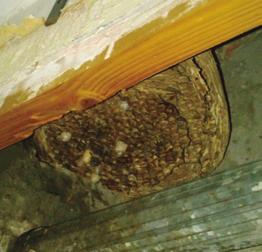
38 OTWO 32 / MARCH 2022 39
Photography: Unknown author.
Photography: Manuel Márquez.
Color rojizo
pers are moving their hives out of the affected area. This situation is very serious.
A beekeeper from Tarifa has asked the Andalusian Government, through its Subdelegation in Campo de Gibraltar, urgent measures to address this crisis. They will have to ask the ministry to consider the Vespa orientalis as an invasive exotic species in order to dedicate funds to its control, since its eradication is not possible.
Another risk to our biodiversity?
The oriental hornet not only attacks bees, it is also a fearsome predator of many other insects, some also important pollinators. All play a role in the complex balance of our ecosystems.
On its life cycle
In order to take measures, it is necessary to know it. When the cold weather arrives, at the end of autumn, only the new fertilized queens survive, and they will look for shelters where they can spend the winter. Already in spring, when the hours of sunshine increase, on which their activity depends so much, the surviving queens will become visible. Each one will start a nest, where she will lay eggs that will give rise to larvae of female workers.
This nest is hidden in holes in the ground, under beach walkways, in masonry walls, cracks in buildings, shutter boxes, disused vents in kitchens or bathrooms.
These workers will be responsible for continuing the expansion of the nest or nest box and the supply of food to their community. This food will be varied, from nectar to fruits and animals or carrion.
The queen remains in the nest until the end of the cycle, producing sexed and reproductive individuals, which will be males or new queens, from the end of August or September.
In these last months, from September to November, the colony has more individuals and requires more food of animal origin, so their predatory behavior increases.
It will be important to actively locate and eliminate nests before sexed individuals are produced and to do so at night, when all hornets are in the nest.
mantenimiento de las colmenas. Algunos apicultores están trasladando sus colmenas fuera del área afectada. Esta situación es muy grave.
Una apicultora de Tarifa ha pedido a la Junta de Andalucía, a través de su Subdelegación en el Campo de Gibraltar, medidas urgentes para afrontar esta crisis. Tendrán que solicitar al ministerio la consideración de la Vespa orientalis como especie exótica invasora para poder dedicar fondos a su control, ya que no es posible su erradicación.
¿Otro riesgo para nuestra biodiversidad?
El avispón oriental no solo ataca a las abejas, también es un temible depredador de otros muchos insectos, algunos también importantes polinizadores. Todos con un papel en el equilibrio complejo de nuestros ecosistemas.
Sobre su ciclo de vida
Para tomar medidas hay que conocerlo. Cuando llegan los fríos, al final del otoño, solo sobreviven las nuevas reinas fecundadas, que buscarán refugios donde pasar el invierno. Ya en primavera, cuando aumentan las horas de sol, de las que tanto depende su actividad, las reinas supervivientes se harán visibles. Cada una iniciará un nido, donde irá poniendo huevos que darán lugar a larvas de hembras obreras.
Ese nido se oculta en agujeros que practican en el suelo, bajo pasarelas de playa, en muros de mampostería, grietas de edificios, cajas de persianas, respiraderos en desuso en cocinas o baños.
Estas obreras se ocuparán de continuar con la ampliación del nido o avispero y el suministro de alimento a su comunidad. Este alimento será variado, desde néctar a frutas y animales o carroña.
La reina se mantiene en el avispero hasta el final del ciclo, produciendo a partir de finales de agosto o septiembre individuos sexuados y reproductores, que serán machos o nuevas reinas.
En esos últimos meses, de septiembre a noviembre, la colonia tiene más individuos y requieren más alimentos de origen animal por lo que aumenta su comportamiento depredador.
Será importante la localización activa y eliminación de nidos antes de que se produzcan los individuos sexuados y hacerlo de noche, cuando todos los avispones estén en el avispero.
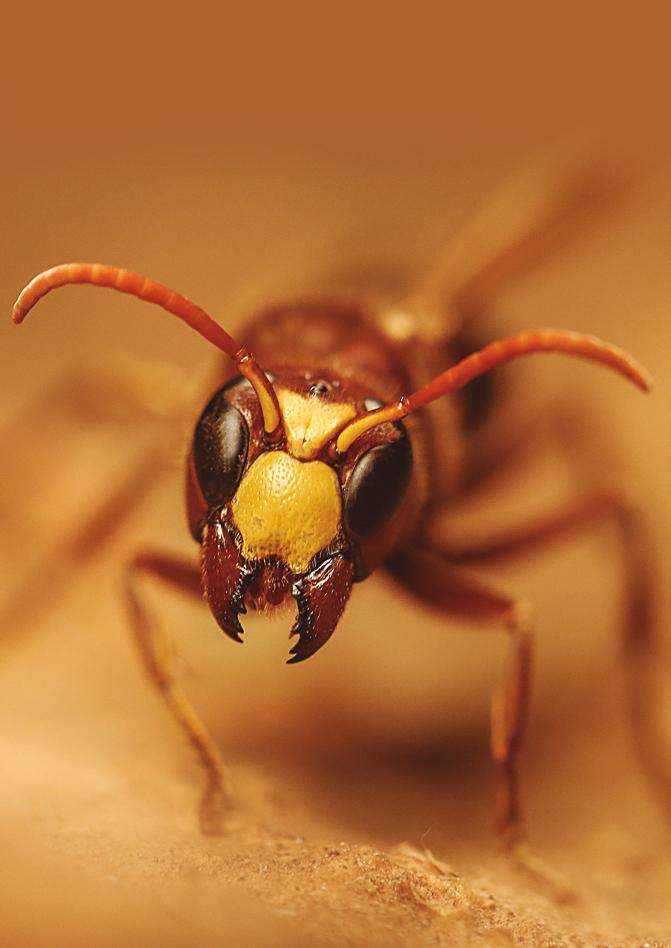
40 OTWO 32 / MARCH 2022 OTWO 32 / MARCH 2022 41
Vespa orientalis. Photography: Carlos del Pico
Possible actions
1. Improving information. To this end, the IECG (Instituto de Estudios Campogibraltareños) has prepared a brochure available to the municipalities to provide information to neighbors.
2. Advise and help beekeepers to control them in a safe, effective and sustainable way, avoiding “Trojan” insecticides.
3. Dedicate more technical and human resources to the control of invasive species.

Posibles actuaciones
1. Mejorar la información. Para ello el IECG (Instituto de Estudios Campogibraltareños) ha preparado un folleto a disposición de los ayuntamientos para facilitar información a los vecinos.
2. Asesorar y ayudar a los apicultores para su control de manera segura, efectiva y sostenible, evitando insecticidas “troyanos”.
3. Dedicar más medios técnicos y humanos al control de las especies invasoras.
OTWO 32 / MARCH 2022 43 42 OTWO 32 / MARCH 2022
Vespa crabro. Photography: Carlos del Pico
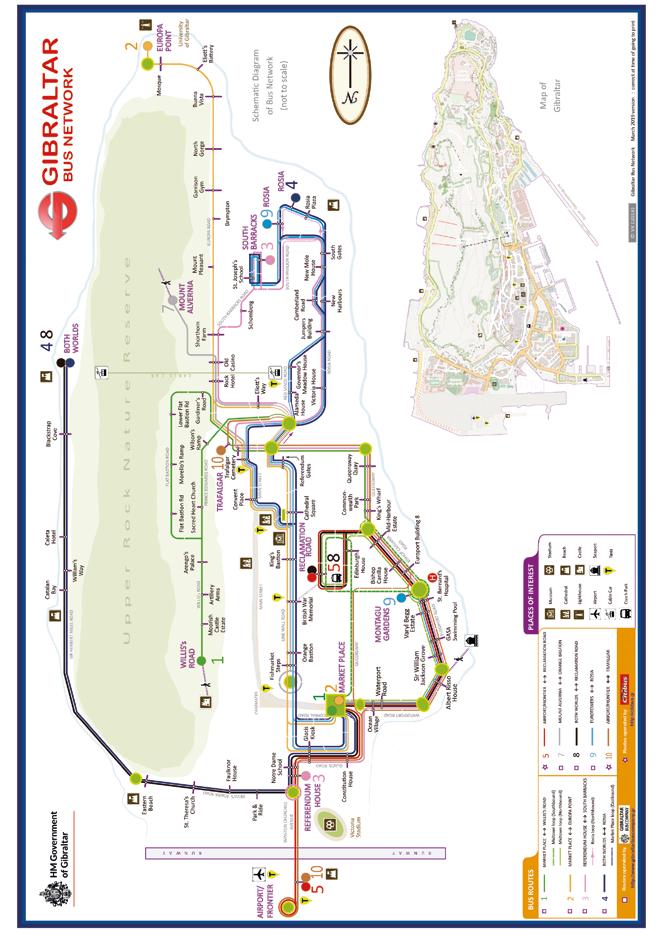

Fair traveller of Amarytierra
MENTAWAI: letting lose another piece of paradise
Chapter 2
Viajante de Amarytierra
MENTAWAI: dejando perder otro pedazo del paraíso. Capítulo 2.
Text and photos: Ainara Martínez Rodríguez
We are concerned with what we should teach kids, but what about the lessons we may learn from them?
From their millenary wisdom, they have been able to survive as a preneolithic civilisation for millennia; millennia that cannot be counted in years, in reality, millennia. Of how to make the most use of natural resources while maintaining their long-term viability. How garbage isn’t a problem if it’s made of biodegradable materials and can be easily absorbed by the environment.
How much space a family needs to be able to supply its needs and how a population must grow so that the environment can assimilate the impact. How an egalitarian society is organized in which the family is the basis and the tasks are shared for the benefit of the group. How children meet their social and learning needs at their own pace, in a loving and caring environment, receiving the tools they need to develop both individually and collectively.
How to be happy and feel in harmony with everything around you. How to live serenely in the present and not invent unreal needs. How to assume death as a part of the process after having develo-

Nos preocupamos de lo que debemos enseñarles, pero qué hay de todo lo que podemos aprender de ellos.
De esa sabiduría milenaria que les ha permitido perdurar como sociedad preneolítica a lo largo del tiempo; un tiempo que no se mide en años, de hecho, un tiempo que no se mide. De cómo utilizar los recursos naturales en beneficio propio asegurando su continuidad. De cómo los residuos no son un problema si proceden de fuentes biodegradables y fácilmente asumibles por el medio ambiente.
De cuánto espacio necesita una familia para poder abastecer sus necesidades y cómo debe crecer una población para que el medio pueda asimilar el impacto. De cómo se organiza una sociedad igualitaria en la que la familia es la base y las tareas se reparten en beneficio del grupo. De cómo los niños cubren sus necesidades sociales y de aprendizaje según su propio ritmo, en un ambiente de cariño y cuidado, recibiendo las herramientas que necesitan para desarrollarse tanto a nivel individual como colectivo.
De cómo ser feliz y sentirse en armonía con todo lo que te rodea. De cómo vivir serenamente en el presente y no inventar necesidades irreales. De
OTWO 32 / MARCH 2022 47 46 OTWO 32 / MARCH 2022
ped your function in this life. Of the magic of the world that tries to be explained through myths and serves as a basis for beliefs.
And then there is all that we cannot understand or even imagine. Knowledge that is not collected in any book, but is given orally from one generation to another.
Meanwhile, our advanced society is able to quantify the rate at which it consumes natural resources and predict when they will run out. We have statistics on how much waste we generate per day, but we don’t know what to do with it. We are cramming ourselves into ever smaller spaces, isolating ourselves from natural light, air and contact with the earth. Family nuclei are shrinking and breaking up. The elderly lack a social function, children are overloaded with mental tasks according to an imposed rhythm and deprived of a healthy psycho-motor development. There are data that speak of women killed by our own men.
At the end of the year we count casualties due to depression, suicides, psychiatric and psychological treatments, stress levels, maladjusted, hyperactive, anxious and sedentary people. Death is synonymous with suffering, resistance, incomprehension. Religions are nothing more than an excuse to subjugate the other. We live immersed in a continuous lack in which our needs always exceed our possibilities. We have forgotten to live. And what is worse, we have forgotten to dream.
We have all this to teach them and most of them are concepts that do not even exist in their vocabulary.
They resisted the loss of identity in the 1970s, when it was imposed with the use of force and abuse of authority during the dictatorial era of General Suharto, who vetoed the practice of basic elements of the ancestral culture. Thus, the use of tattoos was forbidden, even though body decoration has a deep meaning for them, as well as wearing long hair, necessary to hold flowers and other ornaments during their ceremonies, and filing their teeth in the shape of a saw, among other things.
Nowadays, being an already alienated people, accustomed to a certain presence of travelers and having participated in documentaries and even television programs, the process of change is much ea-
cómo asumir la muerte como una parte del proceso después de haber desarrollado tu función en esta vida. De la magia del mundo que trata de ser explicada mediante mitos y sirve de base a las creencias.
Y luego queda todo aquello que no podemos entender y ni siquiera alcanzamos a imaginar. Conocimiento que no se recoge en ningún libro sino que viene dado de forma oral de una generación a otra.
Mientras, nuestra sociedad avanzada es capaz de cuantificar el ritmo al que consume los recursos naturales y pronosticar cuándo se acabarán. Tenemos estadísticas sobre cuántos residuos generamos al día pero no sabemos qué hacer con ellos. Nos hacinamos en espacios cada vez más pequeños aislándonos de la luz natural, el aire y el contacto con la tierra. Los núcleos familiares se reducen y se fraccionan. Los ancianos carecen de una función social, los niños son sobrecargados de tareas mentales según un ritmo impuesto y privados de un desarrollo psico-motriz saludable. Existen datos que hablan de mujeres muertas a manos de nuestros propios hombres.
Al cabo del año contamos bajas por depresión, suicidios, tratamientos psiquiátricos, psicológicos, niveles de estrés, inadaptados, hiperactivos, ansiosos y sedentarios. La muerte es sinónimo de sufrimiento, resistencia, incomprensión. Las religiones no son más que una excusa para avasallar al otro. Vivimos sumidos en una carencia continua en la que nuestras necesidades siempre superan nuestras posibilidades. Nos hemos olvidado de vivir. Y lo que es peor, nos hemos olvidado de soñar.
Tenemos todo esto para enseñarles y la mayoría son conceptos que ni siquiera existen en su vocabulario.
Se resistieron a la pérdida de identidad en los años 70, cuando fue impuesta con uso de la fuerza y abuso de autoridad durante la época dictatorial del General Suharto, quien vetó la práctica de elementos básicos de la cultura ancestral. De tal modo, se prohibió el uso de tatuajes, aun cuando la decoración del cuerpo tiene un significado profundo para ellos; también llevar el pelo largo, necesario para sujetar flores y otros adornos durante sus ceremonias y limarse los dientes en forma de sierra, entre otra cosas.
Actualmente, tratándose de un pueblo ya alienado, acostumbrado a cierta presencia de viajeros
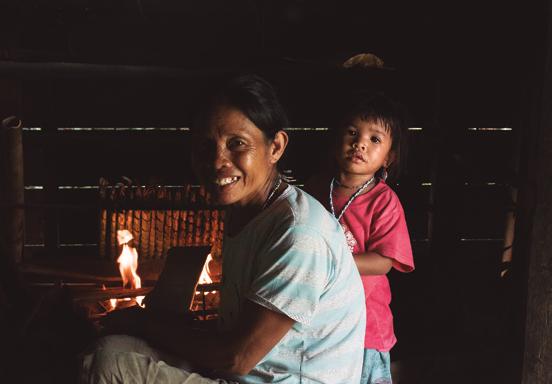
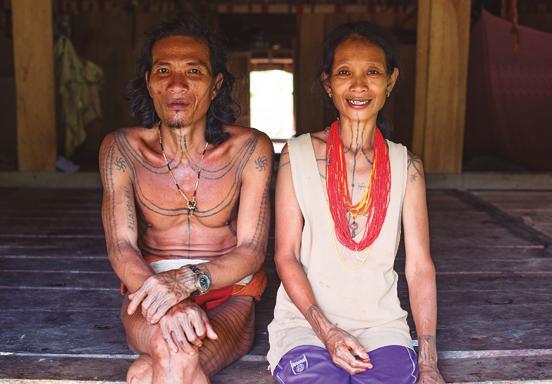
48 OTWO 32 / MARCH 2022 OTWO 32 / MARCH 2022 49
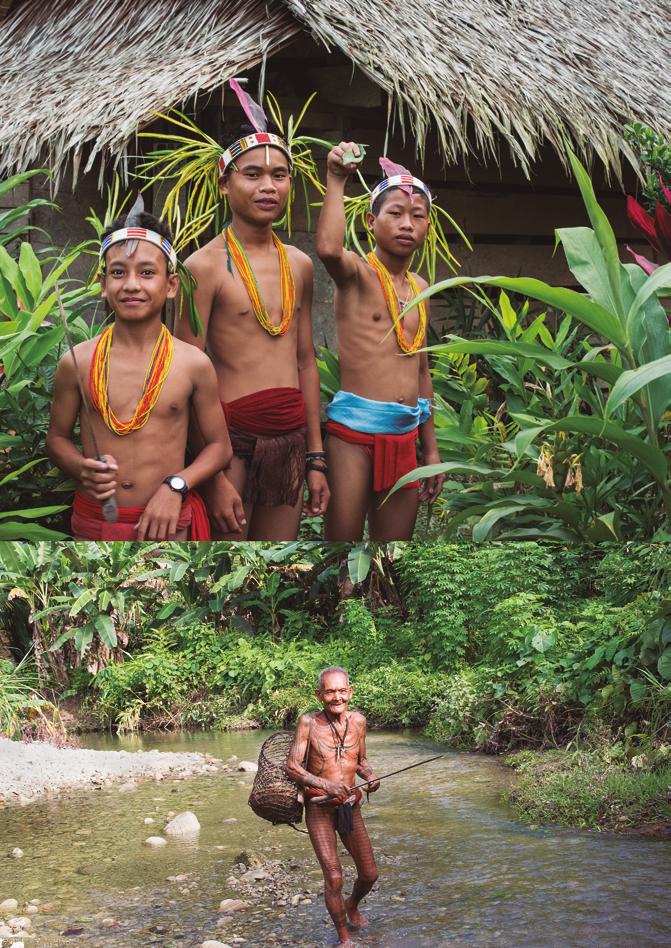

OTWO 32 / MARCH 2022 51 50 OTWO 32 / MARCH 2022

sier. They are receptive and assume that any change will always be for the better. If you bring tobacco you are welcome, if you also bring sugar you can become friends, for some new clothes they share your religion and give up their land in exchange for a motorcycle or a gasoline generator. In addition, that’s it, the process has been successfully completed, they need fuel and they no longer have land where they can get food; from now on they have to buy and for that they need to work. They now belong to the system.
The first source of income will be from the logging and sale as timber of the primary forests that make up their territory in western Indonesia. After the ecological disaster, palm crops will form the landscape and economic base. The food, of low nutritional quality, pre-cooked, highly seasoned and packaged in plastic, will be shipped from Sumatra. Plastic waste, glass, cans, chemicals, etc. will be burned or dumped into the sea.
I wonder if they would be so open to change if they knew they would go from being considered an underdeveloped ancestral society to joining the long list of poor communities on the planet. Perhaps our job is to provide them with the information, to help them understand what globalization means in its full dimension and to allow them as a community to decide on their future. However, it seems too late for that too, women who grew up bare-chested, in full contact with nature, are beginning to cover themselves with men’s clothes, losing part of their femininity and even hiding under a hijab. Men who traditionally mimicked the environment, dressed only in their kabit and tattoos, showing themselves for what they are, owners and lords of their land, now appear in dirty and torn clothes like homeless beggars.
Roofs that, until not so long ago, they were able to build more than four meters high in their wide Umas scattered along the river, where families of up to 30 people were sheltered. Nowadays they are relocated in shacks one after the other along a road planned to join points that until now were only connected on foot, but which, instead, seems to be serving the task of dismembering the community according to their religion; on one side those who remain in the old one, on the other side those who open themselves to the new one. As a wise strategist once said: “divide and conquer”.
y que ha participado en documentales e incluso programas de televisión, el proceso de cambio es mucho más sencillo. Se muestran receptivos y presuponen que cualquier cambio siempre será para bien. Si traes tabaco eres bien recibido, si además traes azúcar puedes llegar a ser amigo, por algo de ropa nueva comparten tu religión y ceden sus tierras a cambio de una moto o un generador de gasolina. Y ya está, el proceso ha concluido con éxito, necesitan combustible y ya no disponen de tierra donde conseguir el alimento; a partir de ahora tienen que comprar y para ello necesitan trabajar.
Ya pertenecen al sistema.
La primera fuente de ingresos será a partir de la tala y venta como madera de los bosques primarios que conforman su territorio en el oeste indonesio. Tras el desastre ecológico, los cultivos de palma constituirán el paisaje y serán la base económica. Los alimentos, de baja calidad nutritiva, precocinados, altamente condimentados y envasados en plástico serán enviados desde Sumatra. Los residuos plásticos, vidrios, latas, químicos, etc. serán quemados o vertidos al mar.
Me pregunto si estarían tan abiertos al cambio si supieran que pasarán de ser considerados una sociedad ancestral subdesarrollada a engrosar la larga lista de comunidades pobres del planeta. Quizá nuestra labor esté en ofrecerles la información, ayudarles a entender qué significa la globalización en toda su dimensión y permitir que sean ellos como comunidad los que puedan decidir sobre su futuro. Sin embargo, ya parece tarde también para eso, mujeres que crecieron con el torso descubierto, en pleno contacto con la naturaleza, comienzan a cubrirse con ropas de hombre perdiendo parte de su feminidad e incluso escondiéndose bajo un hijab. Hombres tradicionalmente mimetizados con el medio vestidos únicamente con su kabit y sus tatuajes, mostrándose como lo que son, dueños y señores de su tierra, aparecen ahora con ropas sucias y rotas como pordioseros sintecho.
Techos que, hasta hace no tanto tiempo, eran capaces de construir de más de cuatro metros de altura en sus amplias Umas diseminadas a la vera del río, donde se acogía a familias de hasta 30 personas. Actualmente son reubicados en casuchas unas tras otras a lo largo de un camino proyectado para
OTWO 32 / MARCH 2022 53 52 OTWO 32 / MARCH 2022
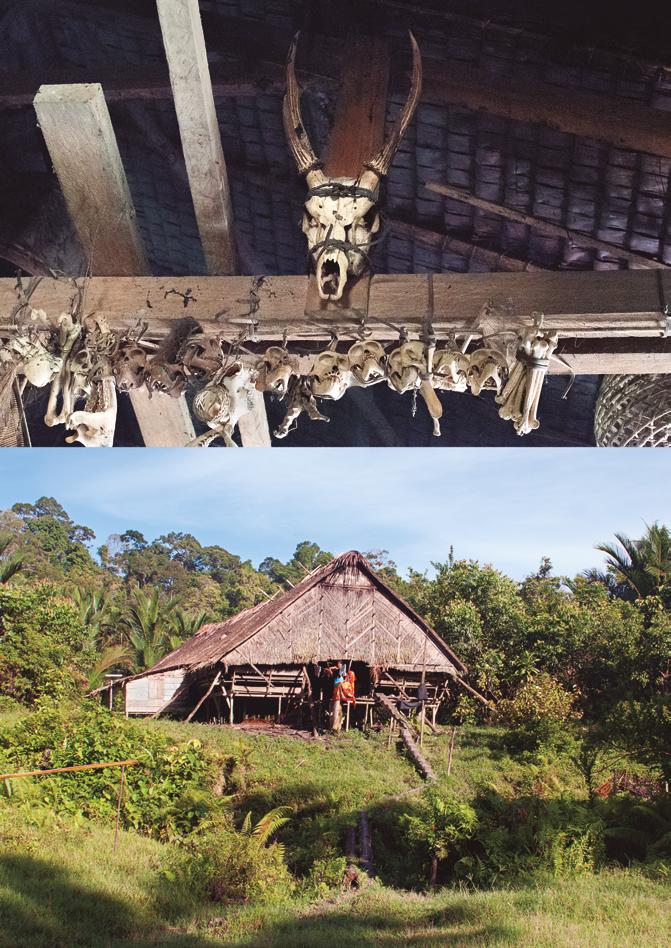

OTWO 32 / MARCH 2022 55 54 OTWO 32 / MARCH 2022
It is easy to come and tell others that they have to change, to tell them what they have to do and what they can no longer do, what is better for them, what they are doing wrong...
Is it so difficult to recognize the other person as he is? To value him, to make sure that he also knows and recognizes himself, to give him security, support and self-affirmation? Is it so difficult to help him maintain his customs, his ideas, and his beliefs?
Would it be possible to learn the keys to success for an eco-healthy Human-Earth bond before the last community to practice it disappears?
Mutual learning.
Respectful teaching.
Sharing.
Preserving.
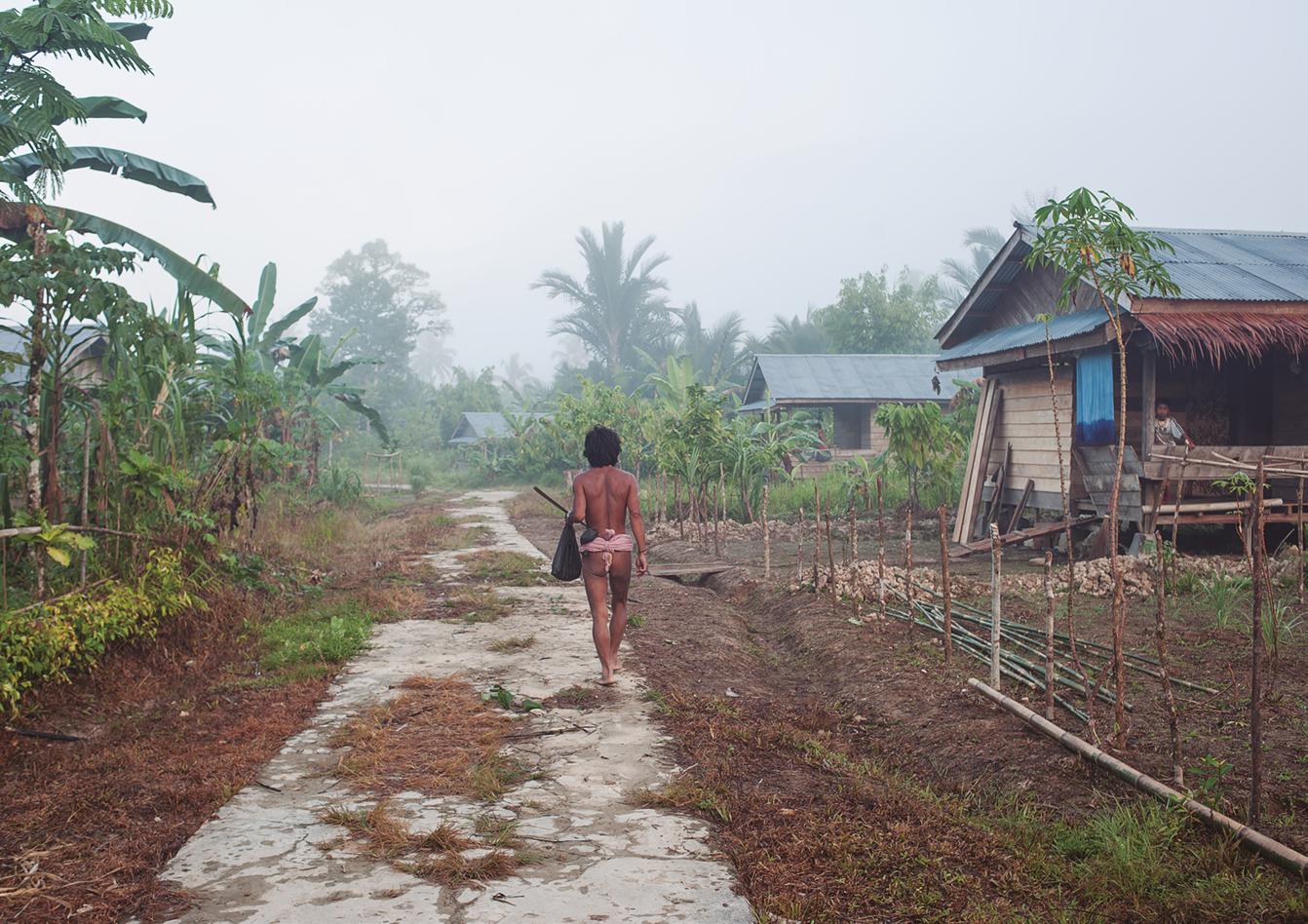
unir puntos que hasta el momento sólo se unían a pie, pero que en lugar de eso, más parece que está sirviendo a la labor de desmembrar a la comunidad según su religión; a un lado los que permanezcan en la antigua, a otro lado los que se abran a la nueva. Ya lo dijo algún sabio estratega: “divide y vencerás”.
Es fácil llegar y decirle a otros que tienen que cambiar, decirles lo que tienen que hacer y lo que ya no pueden hacer, lo que es mejor para ellos, lo que están haciendo mal...
¿Tan difícil es reconocer al otro tal y como es? Valorarlo, asegurarse de que él también lo sepa y se reconozca a sí mismo, conferirle seguridad, apoyo y autoafirmación. ¿Tan difícil es ayudarle a mantener sus costumbres, sus ideas, sus creencias?
¿Sería posible aprender las claves del éxito para un vínculo Humano-Tierra ecosaludable antes de que desaparezca la última comunidad que lo practica?
Aprendizaje mutuo.
Enseñanza respetuosa. Compartir. Conservar.
OTWO 32 / MARCH 2022 57 56 OTWO 32 / MARCH 2022
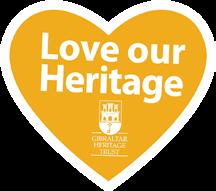

“Gibraltar’s rich heritage is one of its greatest assets and it is imperative that it is preserved and managed in a sustainable way to continue to benefit future generations”

The Gibraltar Heritage Trust
The Gibraltar Heritage Trust is an independent statutory body entrusted with the preservation of Gibraltar’s heritage. It aims to work in partnership with all like-minded bodies, both locally and internationally. The Trust is responsible to the people of Gibraltar for the preservation and enhancements of all aspects of Gibraltar’s heritage, which includes promotion culturally, educationally and in terms of tourism both for our local population and internationally. It works closely with the Government of Gibraltar and the private sector in fulfilling its aims. Operating on a not for profit basis all funding for Trust projects are raised through our annual membership drive, our commercial activities or through specific project targeted fundraising. All funds generated are applied to achieving the aims and objectives of the Trust.

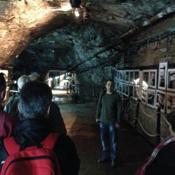
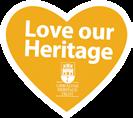
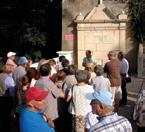
“The events that the Trust organises allow me and my partner to explore places that we simply would not have seen without the help and knowledge of the Trust”
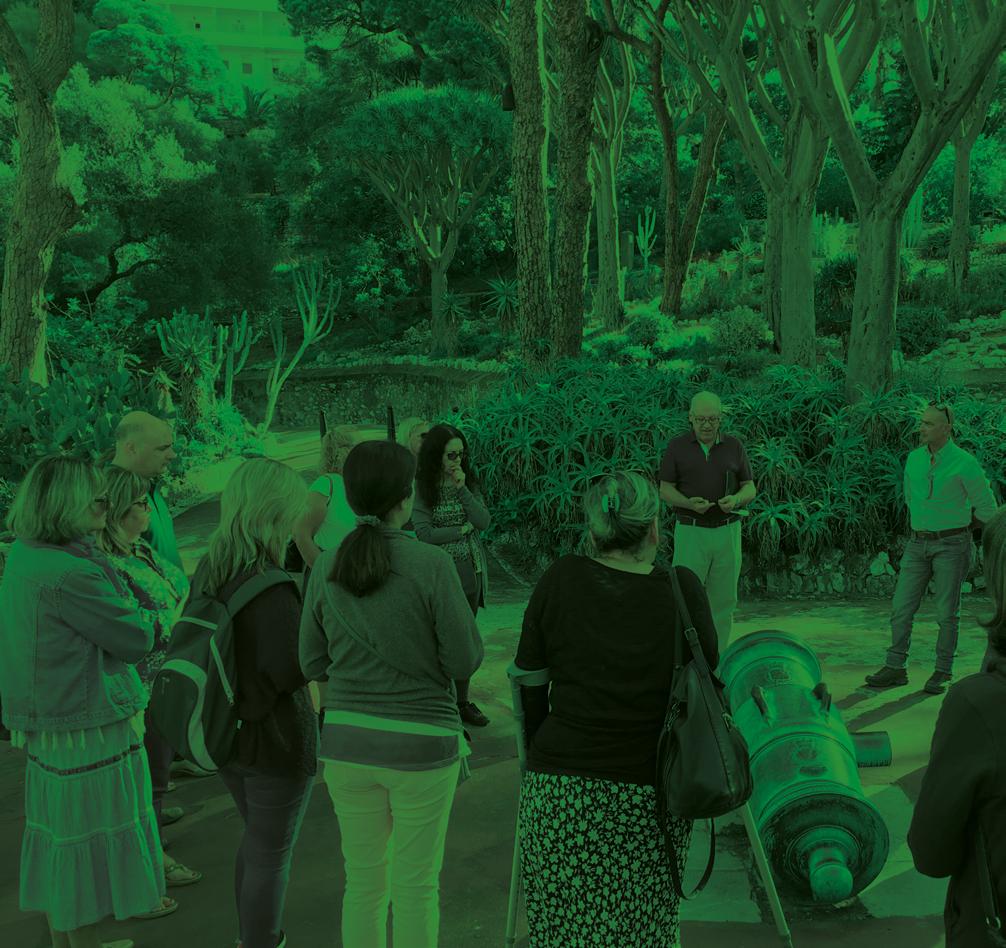
The Trust has a number of statutory and strategic functions to:
1.- Safeguard and enhance the quality and condition of Gibraltar’s historic environment.
2.- Promote wider understanding, enjoyment and appreciation of Gibraltar’s historic environment.
3.- Enhance Gibraltar’s Sense of Place.
4.- Encourage relevant bodies to make Gibraltar’s historic areas better places to live, visit and to invest in.
5.- Work with others to amplify the impact of the wider initiatives to improve the city and make Gibraltar a better place to live, visit and invest in.
6.- Work towards the implementation and enforcement of new heritage legislation, policies and guidelines.
7.- Be open, responsive, transparent, effective and efficient in our work.
By investing in the Trust you are investing in Gibraltar’s past, its present and its future.
With your annual membership, you support Gibraltar and the work that the Trust does to protect and enhance it, however, your membership also entitles you to:
• Access to the Trust’s monthly programme of events, including trips and organised excursions.
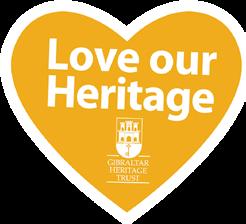
• Access, by appointment, to the Trust’s reference library of books related to Gibraltar and its past. (The Trust is accepting donations of books on Gibraltar to add to this resource).
• Free entry to the Gibraltar Museum.
• Free entry to the Upper Rock Nature Reserve, St Michael’s Cave, Great Siege Tunnels, Military Heritage Centre, Tower of Homage, Ape’s Den, Windsor Suspension Bridge and WWII Tunnels.
• Annual report, our regular e-newsletter direct to your inbox, updates and information on what’s happening on the Gibraltar heritage scene.
• Discounts and deals from local businesses added throughout the year.
• Discounts on all Gibraltar Heritage Trust Publications in our shop.

Gibraltar Heritage Trust
The Main Guard
13 John Mackintosh Square PO Box 683, Gibraltar t. (+350) 200 42844 admin@gibraltarheritagetrust.org.gi www.gibraltarheritagetrust.org.gi
JOIN US NOW VIA OUR WEBSITE OR POP INTO OUR SHOP
In Greek mythology, Gaia or Gaea is the primordial goddess who personifies the Earth, mother Earth, fertile progenitor and common ancestor of all gods, human beings and other living beings.
It is also the name that, at the suggestion of the novelist William Golding, received the theory conceived by James Lovelock and developed together with Lynn Margulies in the 60s of the last century. Invited by NASA to study how to detect possible life on Mars, Lovelock came to the conclusion that the conditions of planet Earth, suitable for life, are self-regulating due to the presence of life, unlike the theory until then most commonly accepted, that,

Environmental health and the One Health approach
Salud ambiental y el enfoque One Health
Virginia Ballesteros Arjona.

Environmentalist. Master in Public Health.
En la mitología griega, Gaia o Gea es la diosa primigenia que personifica la Tierra, la madre Tierra, progenitora fecunda y antepasada común de todos los dioses, seres humanos y demás seres vivos.
Es también el nombre que, a sugerencia del novelista William Golding, recibió la Teoría concebida por James Lovelock y desarrollada junto a Lynn Margulies en los años 60 del pasado siglo. Invitado por la NASA para estudiar cómo detectar posible vida en Marte, Lovelock llegó a la conclusión de que las condiciones del planeta Tierra, adecuadas para la vida, se autorregulan debido a la presencia de esta, a diferencia de la teoría hasta entonces más común-
61
OTWO 32 / MARCH 2022 ILLUSTRATION: JUANJO TRUJILLO

thanks to pre-existing conditions suitable for life, it had emerged and adapted to the changes that were occurring. According to Gaia’s theory, it is the living organisms that have been modifying the initial conditions suitable for their emergence, and the current conditions of temperature, atmospheric composition and ocean salinity are not only due to the presence of life on Earth, but are maintained in equilibrium thanks to her.
Perhaps because of its Greek goddess name, perhaps because of the time in which it was developed and its adoption by mystical or new age currents, or because Gaia, the Earth system, has been identified as a living superorganism, it is a theory that has received much criticism.
It is not the purpose of this article to deepen or make a critical analysis of the Gaia Theory, but to use it as a starting point. Regardless of the adequacy of the hypothesis, it presents in a very graphic way the planet as a complex system in which interrelationships are established between its physical and chemical conditions and characteristics and the living organisms that inhabit it.
Now, with this image in mind, we introduce another concept, in this case from the field of health: the One Health concept. “One Health” or One Health is a term used to describe a principle that recognizes that human and animal health are interconnected, that diseases are transmitted from humans to animals and vice versa and, therefore, must be addressed in both. The One Health approach also encompasses the environment, another link between humans and animals.
This term is globally recognized, having been widely used in European Union plans, United Nations policy statements, national documents and policies, etc.
Its importance lies in the fact that it is an entirely necessary approach to prevent, detect and respond effectively to the health challenges arising from the relationship between humans, animals and the environment.
It implies a paradigm shift that recognizes the interrelationship between humans, animals and the environment: our health depends on the health of animals and on the health of the environment, these three being interconnected. Food security is based
mente aceptada, de que gracias a unas condiciones preexistentes adecuadas para la vida, ésta había surgido y adaptado a los cambios que se iban produciendo. Según la teoría de Gaia, son los organismos vivos los que han ido modificando las condiciones iniciales adecuadas para su surgimiento, y las condiciones actuales de temperatura, composición atmosférica y salinidad oceánica, no sólo son debidas a la presencia de vida en la Tierra sino que se mantienen en equilibrio gracias a ella.
Quizás debido a su nombre de diosa griega, quizás por la época en que fue desarrollada y su adopción por corrientes místicas o new age, o por el hecho de que se ha identificado a Gaia, el sistema Tierra, como un superorganismo vivo, es una teoría que ha recibido muchas críticas.
No es el propósito de este artículo profundizar ni hacer un análisis crítico de la Teoría de Gaia, sino usarla como punto de partida. Independientemente de lo adecuado de la hipótesis, presenta de forma muy gráfica el planeta como un sistema complejo en el que se establecen interrelaciones entre sus condiciones y características físicas y químicas y los organismos vivos que lo habitan.
Y ahora, con esta imagen en mente, introducimos otro concepto, en este caso del campo de la salud: el concepto One Health. «Una sola salud» o One Health es un término que se usa para describir un principio que reconoce que la salud humana y animal están interconectadas, que las enfermedades se transmiten de humanos a animales y viceversa y, por lo tanto, deben abordarse en ambos. El enfoque de One Health también abarca el medio ambiente, otro vínculo entre humanos y animales.
Este término es mundialmente reconocido, habiendo sido ampliamente utilizado en planes de la Unión Europea, en declaraciones políticas de Naciones Unidas, documentos y políticas nacionales, etc.
Su importancia radica en que es un enfoque totalmente necesario para prevenir, detectar y responder eficazmente a los desafíos de salud que surgen de la relación entre seres humanos, animales y medio ambiente.
Supone un cambio de paradigma que reconoce la interrelación seres humanos, animales y medio ambiente: nuestra salud depende de la salud de los animales y también de la del medio ambiente, estando
OTWO 32 / MARCH 2022 63 62 OTWO 32 / MARCH 2022

on the health of the animals from which the food consumed by a large part of the population is derived. Our health also depends on the health of our environment and the interactions we establish with it.
However, this approach may seem foreign to someone living in an urban environment. The health of animals may seem more or less distant, since; after all, food arrives already pre-processed to a large extent in supermarkets. It seems that this is a matter for the authorities who have the power to supervise these foods before they reach the store. As for the health of the environment, it may also seem a long way off. Let’s not forget that a large part of the population lives in totally urbanized environments. Perhaps the most natural things they see in their day-to-day lives are trees in tree pits, parks, if they are lucky enough to have one nearby, and sparrows, pigeons and pets out for a walk with their owners. “Where is the air pollution, let’s see, that I can see it?”, as the old man used to say.
And even if we do not see these relationships, they are there. Landslides due to inadequate management of the natural environment, overexploitation of forest resources or erosion, flooding of inadequately constructed areas, vector-borne diseases that can become pandemics, global warming and its consequences.
As humanity we are just one more piece in the incredible gear of planetary life. An uncomfortable and noisy part that consumes resources non-stop, emits pollutants, pollutes the sky and water, disturbs ecosystems and planetary cycles. And it also suffers the consequences of these disturbances. We are not a separate instance of animals or the environment, we are part of a whole. Just as an individual living being is not a set of organs or systems, but a whole that goes beyond that set of functioning and interrelated organs.
One Health is a great step forward and undoubtedly marks the path on which we must continue to work in the field of public health. It is a first step that must be followed by many more: human health not only depends on the health of the environment, but is part of it.
estas tres instancias interconectadas. La seguridad alimentaria está basada en la salud de los animales de los que proceden los alimentos que consume una gran parte de la población. Nuestra salud también depende de la salud de nuestro medio, y de las interacciones que establecemos con él.
Sin embargo, este enfoque le puede parecer ajeno a alguien que resida en un entorno urbano. La salud de los animales puede parecerle más o menos lejana, ya que al fin y al cabo los alimentos llegan ya pre-procesados en gran medida a los supermercados. Parece que es algo que competa a las autoridades que tienen la potestad de supervisar esos alimentos antes de que lleguen a la tienda. En cuanto a la salud del medio, también puede parecer algo lejano. No olvidemos que una gran parte de la población viven en entornos totalmente urbanizados. Quizás lo más natural que vean en su día a día sean árboles en alcorques, parques, si tienen la suerte de tener uno cerca, y gorriones, palomas y mascotas de paseo con sus dueños. «¿Dónde está la contaminación del aire, a ver, que yo la vea?», como decía aquel.
Y aunque no veamos estas relaciones, están ahí. Los deslizamientos de tierra debidos a una inadecuada gestión del medio natural, la sobreexplotación de recursos forestales o la erosión, las inundaciones de zonas inadecuadamente construidas, las enfermedades transmitidas por vectores que pueden llegar a convertirse en pandemias, el calentamiento global y sus consecuencias.
Como humanidad sólo somos un pieza más en el increíble engranaje de la vida planetaria. Una pieza incómoda y ruidosa, que consume recursos sin parar, emite contaminantes, ensucia cielo y agua, perturba ecosistemas y ciclos planetarios. Y sufre también las consecuencias de estas perturbaciones. No somos una instancia separada de animales o del medio ambiente, somos parte de un todo. Al igual que un ser vivo individual no es un conjunto de órganos o sistemas, sino un todo que va más allá de ese conjunto de órganos en funcionamiento e interrelación. One Health supone un gran avance y marca sin duda el camino en que debemos seguir trabajando en el ámbito de la salud pública. Es un primer paso al que deben seguir muchos más: la salud humana no sólo depende de la salud del medio ambiente sino que forma parte de ella.
OTWO 32 / MARCH 2022 65 64 OTWO 32 / MARCH 2022
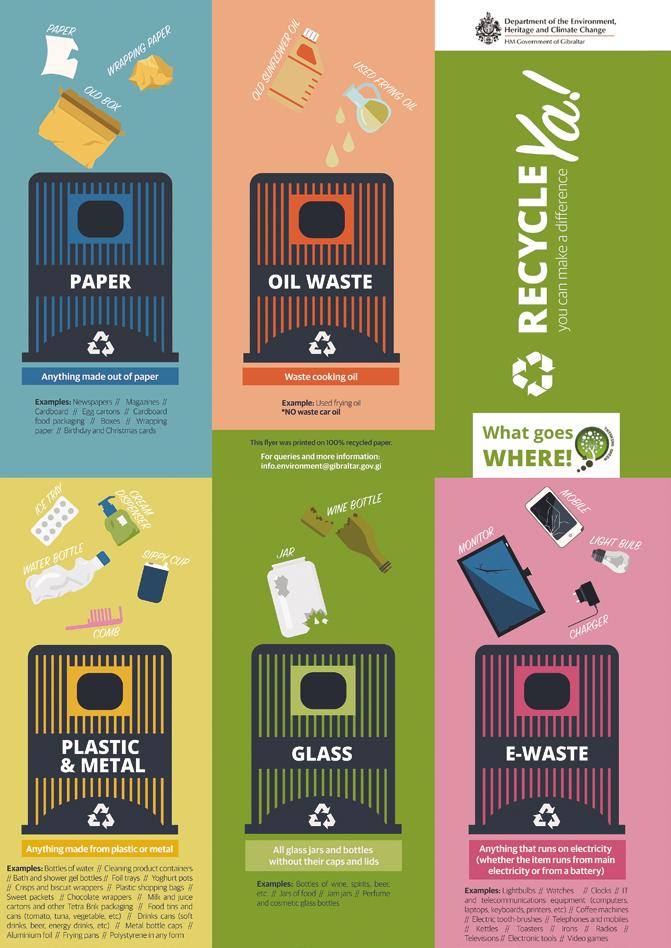

RIBADESELLA SANTANDER
SANTIAGO DE COMPOSTELA
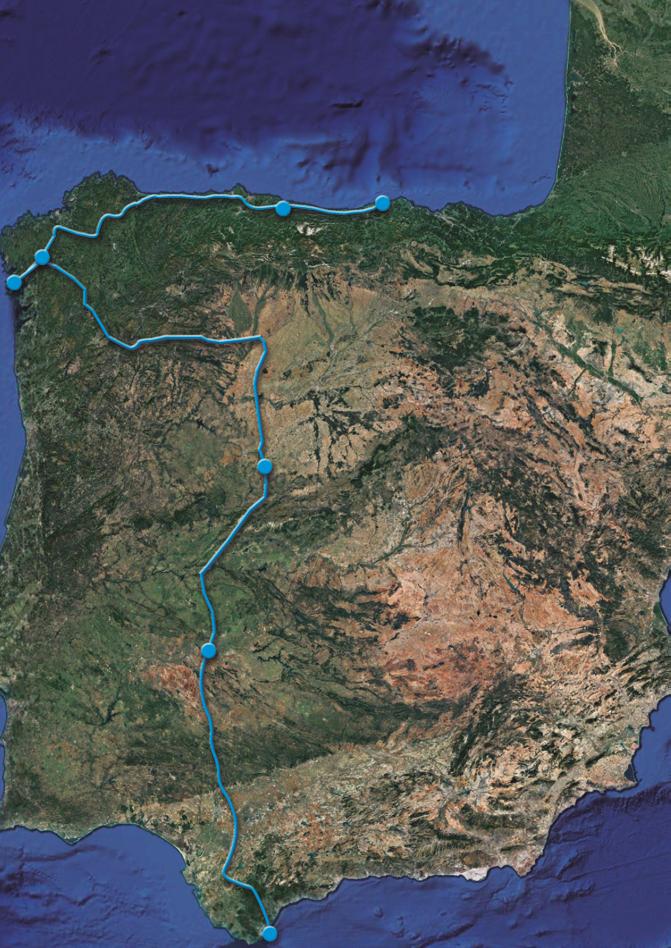
One week had elapsed since we started our road-trip of Spain and France, which took us to the French city of Bordeaux, our route’s northernmost point. Before entering France, our itinerary included a stop at Santander.
The Ribadesella to Santander stretch is relatively short, a mere 120 Kilometres separates the two boroughs. We rolled out of town just gone eleven o’clock in the morning, after a relaxed breakfast at Grand Hotel de Sella where we had spent the night.
7
SALAMANCA
MÉRIDA
STRETCH
Santander

Driving conditions were not optimal. Menacing grey clouds that threatened rain hung overhead, and a hazy obscuration hindered visibility. We observed the distant peaks shrouded in mist, and feared the worst—fog, which soon made its unwelcome appearance. The action of the automatic car wipers alerted us to rain, which coupled with the fog, decreased visibility even further. Rain and fog combinations typifies the region’s meteorology.
The climate corresponding to the province of Santander, in the autonomous community of Cantabria, is cool and damp on the coast because of the influence of the Atlantic Ocean. Inland areas become colder, especially so with increasing altitude. Fog is common, it can materialise year-round, when the wind does not blow, especially along the coast and within the valleys. The A8 to Santander we were traversing was no exception, running very close to the ocean, year-round fog is a common occurrence. About half an hour out of Ribadesella, we drove past Presa de Llames de Pria, the westernmost
Había transcurrido una semana desde que iniciamos nuestro viaje por carretera por España y Francia, que nos llevó a la ciudad francesa de Burdeos, el punto más septentrional de nuestra ruta. Antes de entrar en Francia, nuestro itinerario incluía una parada en Santander. El tramo de Ribadesella a Santander es relativamente corto, apenas 120 kilómetros separan ambas localidades. Salimos de la ciudad pasadas las once de la mañana, tras un relajado desayuno en el Gran Hotel de Sella, donde habíamos pasado la noche.
Las condiciones de conducción no eran óptimas. Unas amenazantes nubes grises que amenazaban con llover se cernían sobre nosotros, y un brumoso oscurecimiento dificultaba la visibilidad. Observamos los picos lejanos envueltos en la niebla y nos temimos lo peor: la niebla, que pronto hizo su inoportuna aparición. La acción de los limpiaparabrisas automáticos del coche nos alertó de la lluvia, que unida a la niebla, disminuyó aún más la visibilidad. La combinación de lluvia y niebla tipifica la meteorología de la región.
El clima correspondiente a la provincia de Santander, en la comunidad autónoma de Cantabria, es fresco y húmedo en la costa por la influencia del océano Atlántico. Las zonas del interior se vuelven más frías, especialmente con el aumento de la altitud. La niebla es habitual, puede materializarse durante todo el año, cuando no sopla el viento, especialmente en la costa y en el interior de los valles. La A8 a Santander que atravesábamos no era una excepción, ya que discurre muy
68 GIBRALTAR
69
FINISTERRE OTWO 32 / MARCH 2022
parish in the autonomous Principality of Asturias. Continuing northeast we passed the Cuevas del Mar beach at the mouth of the Cuevas River. Dotted with large rock formations perforated by the ocean, Cuevas del Mar beach reveals an interesting collection of underground drainage systems with sinkholes, sea caves and tunnels—a Karst landscape (formed from the dissolution of soluble rock such as limestone) of great beauty.
Nearing Santander, the road led us past Parque Natural de Oyambre on Cantabria’s western coast. Oyambre is a protected region which includes the estuaries of the river San Vicente and the Ria de la Rabia. A few minutes from our destination our drive saw us pass the curiously named playa De los Locos, part of Parque Natural de las Dunas de Liencres.
Located at the mouth of the river Pas, in the central area of the Cantabrian coast, Las Dunas de Liencres two most prominent beaches are Valearenas and Canallave. Wind driven sand dunes in the form of mounds, ridges, and hills, cover most of the area behind the beaches. This dune complex is considered the most important of Northern Spain. The dunes’ geomorphology (physical features of the surface of the earth and their relation to geological structures) makes the area unique, presenting a singular landscape and ecology.
We arrived at Hotel Hoyuela in Santander, our refuge for the next two nights, around one thirty in the afternoon. Hoyuela is a seafront hotel on El Sardinero Beach, featuring elegant rooms with views of the Cantabrian Sea, and the famous Gran Casino Sardinero. Unfortunately, not what we saw from our guest-room window.
Santander’s origin dates from the Roman era. The Portus Victoriae was transformed into the Portus Sancti Emeteri when the severed heads of San Emeterio and San Celedonio (Roman soldiers) who would become the patrons of Santander, were brought to the city. Shortly after the Arab invasion of the year 711 CE, the heads of the two saints martyred around 300 CE, were brought to a place later to be called Santander. The revered heads came from the city of Calahorra in the province of La Rioja in northern Spain, area renowned for the wine industry. The silver reliquaries in which the heads are preserved are of Renaissance and Baroque chronology. They are
cerca del océano; la niebla durante todo el año es algo habitual.
A una media hora de Ribadesella, pasamos por la Presa de Llames de Pría, la parroquia más occidental del Principado de Asturias. Siguiendo hacia el noreste, pasamos por la playa de Cuevas del Mar, en la desembocadura del río Cuevas. Salpicada de grandes formaciones rocosas perforadas por el océano, la playa de Cuevas del Mar revela un interesante conjunto de sistemas de drenaje subterráneo con sumideros, cuevas marinas y túneles, un paisaje kárstico (formado por la disolución de rocas solubles como la caliza) de gran belleza.
Cerca de Santander, la carretera nos llevó a pasar por el Parque Natural de Oyambre, en la costa occidental de Cantabria. Oyambre es una comarca protegida que incluye los estuarios del río San Vicente y la Ría de la Rabia. A pocos minutos de nuestro destino, pasamos por la curiosamente llamada playa de los Locos, que forma parte del Parque Natural de las Dunas de Liencres.
Situadas en la desembocadura del río Pas, en la zona central de la costa cantábrica, las dos playas más destacadas de Las Dunas de Liencres son Valearenas y Canallave. Las dunas, impulsadas por el viento, en forma de montículos, crestas y colinas, cubren la mayor parte del área detrás de las playas. Este complejo dunar se considera el más importante del norte de España. La geomorfología de las dunas (características físicas de la superficie de la tierra y su relación con las estructuras geológicas) hace que la zona sea única, presentando un paisaje y una ecología singulares.
Llegamos al Hotel Hoyuela de Santander, nuestro refugio para las dos próximas noches, sobre la una y media de la tarde. El Hoyuela es un hotel situado en primera línea de mar, en la playa del Sardinero, con elegantes habitaciones con vistas al mar Cantábrico, y el famoso Gran Casino Sardinero. Por desgracia, no es lo que vimos desde la ventana de nuestra habitación. El origen de Santander se remonta a la época romana. El Portus Victoriae se transformó en el Portus Sancti Emeteri cuando se trajeron a la ciudad las cabezas cortadas de San Emeterio y San Celedonio (soldados romanos) que se convertirían en los patrones de Santander. Poco después de la invasión árabe del año 711, las cabezas de los dos santos martiri-
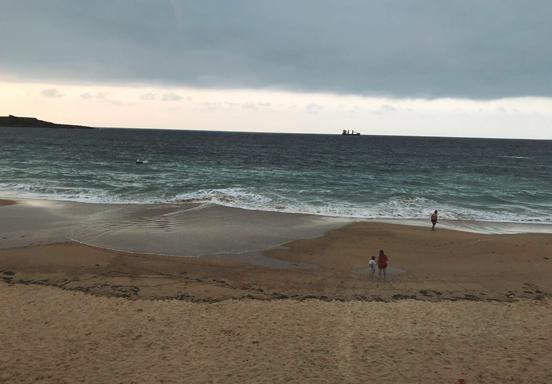

70 OTWO 32 / MARCH 2022 OTWO 32 / MARCH 2022 71

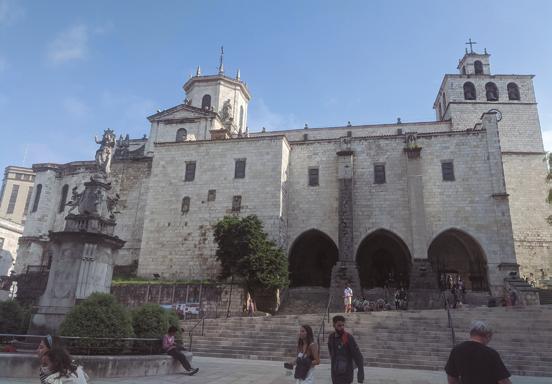
kept at the church of the Santisimo Cristo in the city centre. Other relics preserved here correspond to the arm of San Germain, dating from the end of the 16th century, and a fragment of the Lignum Crucis.
Alfonso VIII granted the city jurisdiction in 1187. This spurred an important economic and social expansion. In 1248, Cantabrian sailors participated in the conquest of Seville, fact reflected in the Santander coat of arms that sports the Torre del Oro, the ship, and the chains. During the 18th and 19th centuries, Santander became an important commercial port between Castilla and the American colonies.
In 1847, the first newspaper advertisements for the Baños de Ola (sea baths, also called wave baths or swell baths) appeared. From then on, and especially so between 1913 and 1930, Santander became the favourite summer destination for the Spanish Royal Family and aristocracy. Unfortunately, 1941, saw the great fire of Santander, a catastrophe that swallowed up the entire city centre. Most of its historic old buildings disappeared under flames forever.
The city opens towards the Cantabria Sea, part of the Bay of Biscay’s southern area. The Bay of Santander is the most outstanding natural feature the city has to offer, a body of water partially surrounded by land, considered one of the most beautiful in the world. The coastline enjoys a succession of splendid beaches made up of fine white sands, 13 in total. Three face the Bay: Los Peligros, La Magdalena and Bikini, while all the others face the open sea. The best known and most popular is El Sardinero.
One of the main sites Santander has to offer is the Magdalena Palace, about thirty minutes’ walk from our hotel, along the impressive bay area, in the city centre’s general direction. There is a footpath were the pavement turns to sand, that leads to the palace. It follows the battered coastline of the Magdalena Peninsula, among clusters of long-lived, hardworking trees, that guard against erosion. One of the most beautiful places in Santander, the Magdalena Peninsula offers contemplative views and panoramas of the city and the Cantabrian Sea. The Palace is the most emblematic building in the city, located at the highest point of the Magdalena peninsula. In 1908, the Santander Municipal Corporation, unanimously agreed to offer King Alfonso XII, and his Queen, Victoria Eugenia, a palace in the city as a
zados en torno al año 300, fueron traídas al lugar que más tarde se llamaría Santander. Las veneradas cabezas procedían de la ciudad de Calahorra, en la provincia de La Rioja, en el norte de España, zona famosa por la industria del vino. Los relicarios de plata en los que se conservan las cabezas son de cronología renacentista y barroca. Se conservan en la iglesia del Santísimo Cristo, en el centro de la ciudad. Otras reliquias conservadas aquí corresponden al brazo de San Germán, de finales del siglo XVI, y a un fragmento del Lignum Crucis.
Alfonso VIII concedió a la ciudad la jurisdicción en 1187. Esto impulsó una importante expansión económica y social. En 1248, marineros cántabros participaron en la conquista de Sevilla, hecho que se refleja en el escudo de Santander que luce la Torre del Oro, el barco y las cadenas. Durante los siglos XVIII y XIX, Santander se convirtió en un importante puerto comercial entre Castilla y las colonias americanas. En 1847 aparecen los primeros anuncios en los periódicos de los Baños de Ola. A partir de entonces, y especialmente entre 1913 y 1930, Santander se convirtió en el destino veraniego favorito de la Familia Real y la aristocracia española. Desgraciadamente, en 1941 se produjo el gran incendio de Santander, una catástrofe que se tragó todo el centro de la ciudad. La mayoría de sus edificios históricos desaparecieron bajo las llamas para siempre. La ciudad se abre hacia el mar de Cantabria, que forma parte de la zona sur del Golfo de Vizcaya. La Bahía de Santander es el elemento natural más destacado de la ciudad, una masa de agua parcialmente rodeada de tierra, considerada una de las más bellas del mundo. El litoral goza de una sucesión de espléndidas playas de fina arena blanca, 13 en total. Tres de ellas se asoman a la bahía: Los Peligros, La Magdalena y Bikini, mientras que todas las demás dan al mar abierto. La más conocida y popular es El Sardinero.
Uno de los principales lugares que ofrece Santander es el Palacio de la Magdalena; a unos treinta minutos a pie de nuestro hotel, por la impresionante zona de la bahía, en dirección al centro de la ciudad. Hay un sendero, cuando el pavimento se convierte en arena, que conduce al palacio. Sigue el maltrecho litoral de la península de la Magdalena, entre grupos de árboles longevos y laboriosos, que protegen de
72 OTWO 32 / MARCH 2022 OTWO 32 / MARCH 2022 73
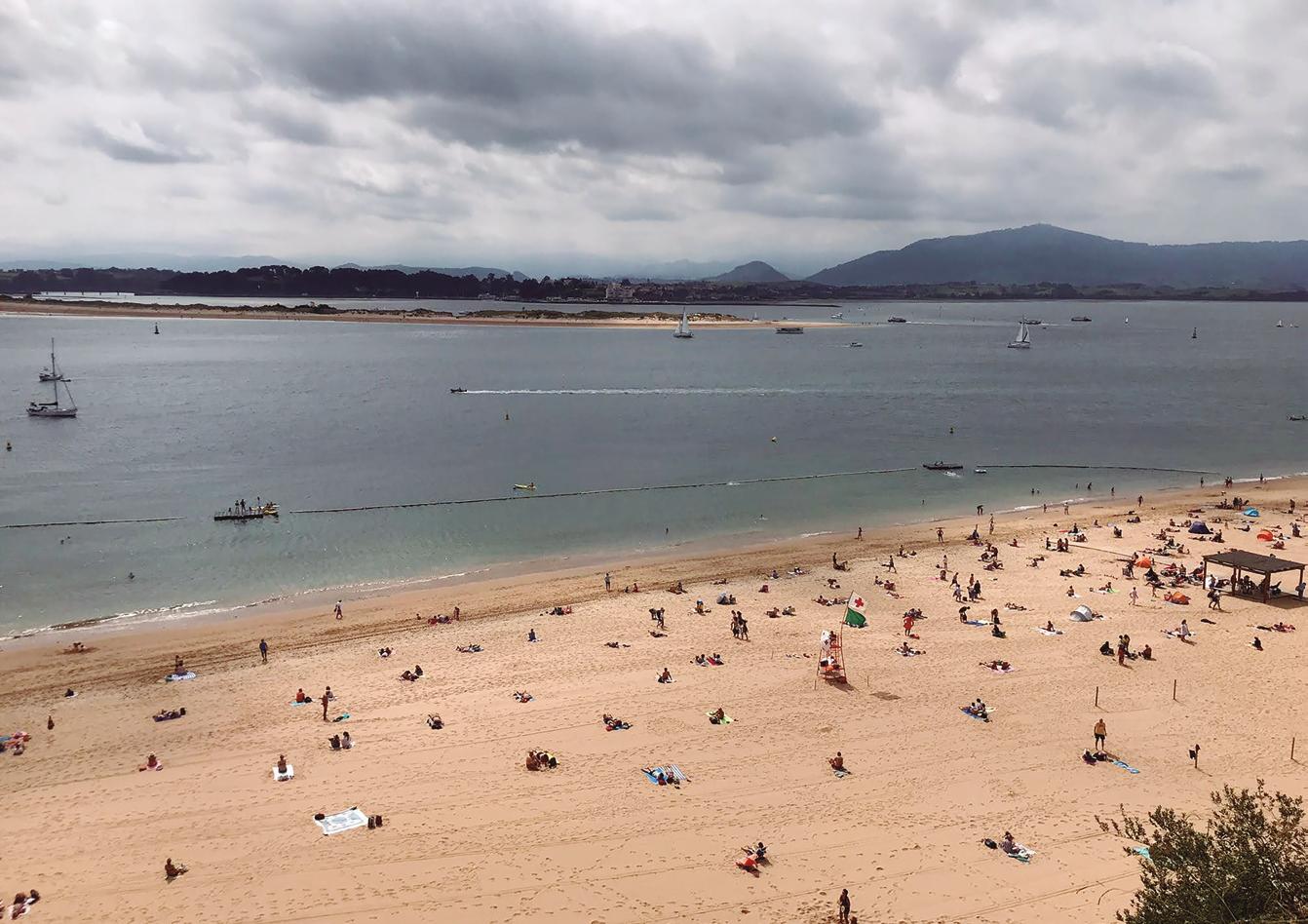
OTWO 32 / MARCH 2022 75 74 OTWO 32 / MARCH 2022
summer residence. Funded by popular subscription, Magdalena Palace construction work began in 1909, officially handed over to the royal family in 1912. In 1931, with the proclamation of the Second Republic, the royal family fled into exile.
The palace remained empty until 1933, when the International Summer University, born a year earlier, declared Magdalena its headquarters. Following the end of General Franco’s fascist regime, the Santander City Council appropriated the Magdalena Palace and Peninsula, with all its assets, and opened it to the public on December 4, 1977. In 1982, the Palace was declared a monument of historical and artistic value. Today it is a museum, and conference venue.
Following the path along the coast past the palace, we found the Cerda lighthouse, designed by engineer Peñarredonda in 1867. Cerda marks Santander’s eastern estuary entrance. Very near the lighthouse we came across El Hombre y La Mar, an open-air exhibit that brings together elements in honour of the new expeditions carried out between 1966 and 1992, by the Santander sailor Vital Alsar Ramirez. The site offers an interesting open-air museum. One of the exhibits presents a group of small galleons that evoke the Caravels (small highly manoeuvrable sailing ship developed in the 15th century by the Portuguese) Pinta, Niña and Santa María, used by Christopher Columbus in his first transatlantic voyage of 1492. A photogenic bronze statue of a mermaid looking out to sea by the sculptor Enrique Jolly, precedes the ships. The galleons together with a few other boat exhibits have been here at the old Magdalena de Santander firing range since 1995. A curiosity worth mentioning is a wooden log raft, used to cross the Pacific Ocean. A flat structure of timbers fastened together, used as a floating platform resembling something out of Daniel Defoe’s Robinson Crusoe. After the successful ocean crossing, the raft was donated to the city and exhibited here. Another conversation piece is a weird kind of Lego UFO craft. An experimental rescue bubble in which researchers travelled 267 days to test its survival capabilities and its potential use for the rescue of castaways.
We continued towards the city centre. Partially suspended over the sea on the waterfront, we cau-
la erosión. La Península de la Magdalena, uno de los lugares más bellos de Santander, ofrece vistas contemplativas y panorámicas de la ciudad y del mar Cantábrico. El Palacio es el edificio más emblemático de la ciudad, situado en el punto más alto de la península de la Magdalena. En 1908, la Corporación Municipal de Santander acordó por unanimidad ofrecer al rey Alfonso XII, y a su reina, Victoria Eugenia, un palacio en la ciudad como residencia de verano. Financiadas por suscripción popular, las obras del Palacio de la Magdalena se iniciaron en 1909, entregándose oficialmente a la familia real en 1912. En 1931, con la proclamación de la Segunda República, la familia real huyó al exilio.
El palacio permaneció vacío hasta 1933, cuando la Universidad Internacional de Verano, nacida un año antes, declaró a Magdalena su sede. Tras el fin del régimen fascista del general Franco, el Ayuntamiento de Santander se apropió del Palacio y la Península de la Magdalena, con todos sus bienes, y lo abrió al público el 4 de diciembre de 1977. En 1982, el Palacio fue declarado monumento de valor histórico-artístico. Hoy en día es un museo y sede de conferencias.
Siguiendo el camino de la costa más allá del palacio, encontramos el faro de Cerda, diseñado por el ingeniero Peñarredonda en 1867. Cerda marca la entrada de la ría oriental de Santander. Muy cerca del faro nos encontramos con El Hombre y La Mar, una exposición al aire libre que reúne elementos en honor a las nuevas expediciones realizadas entre 1966 y 1992, por el marino santanderino Vital Alsar Ramírez. El lugar ofrece un interesante museo al aire libre. Una de las exposiciones presenta un grupo de pequeños galeones que evocan las carabelas (pequeño velero de gran maniobrabilidad desarrollado en el siglo XV por los portugueses) Pinta, Niña y Santa María, utilizadas por Cristóbal Colón en su primer viaje transatlántico de 1492. Una fotogénica estatua de bronce de una sirena mirando al mar, obra del escultor Enrique Jolly, precede a los barcos. Los galeones, junto con algunas otras embarcaciones expuestas, se encuentran aquí, en el antiguo campo de tiro de la Magdalena de Santander, desde 1995. Una curiosidad digna de mención es una balsa de troncos de madera, utilizada para cruzar el Océano Pacífico. Se trata de una estructura plana de maderos sujetos
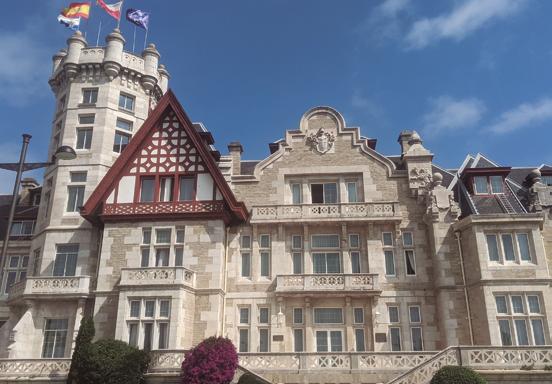

76 OTWO 32 / MARCH 2022 OTWO 32 / MARCH 2022 77

OTWO 32 / MARCH 2022 79 78 OTWO 32 / MARCH 2022


ght glimpse of another of Santander’s important sites, the Botín Center. Designed by Pritzker Prize winner architect Renzo Piano, in collaboration with Luis Vidal and Architects, the Botín Center is a cultural institution, a living space and a unique meeting place where research, training and creativity come together through the arts. Located in a privileged part of Santander, the Botín Center integrates the modern city centre and the historic Pereda Gardens with the Bay. During our stay in Santander, the Botín Center was hosting the Picasso Ibero Exhibition, in collaboration with the Musée National Picasso-Paris. Without hesitation we purchased tickets for an exhibition that presented the influences of Ibero art on the work of Picasso, through more than 200 pieces. An important selection of archaeological works from the Musée du Louvre, and the main Spanish museums revealed the diversity of Ibero art, its culture, and rituals, through sculptures in stone, bronze, and polychrome ceramics. An original confrontational combination, that opens reflective possibilities that question how the discovery of an indigenous and primitive art, contributed to the formation of the identity, and artistic language, of one of the greatest artists of the 20th century. Highly enjoyable!
Our time in Santander, with its green mountains and white sandy beaches, sophisticated stately homes, avant-garde palatial architecture, Belle Époque buildings, and distinct echo of the sea, had sadly come to an end.
Our next destination would be Bordeaux, a port city on the river Garonne, in the Gironde department, Southwestern France, 430 Kilometres North.
entre sí, que se utilizaba como plataforma flotante y que se asemejaba a algo salido del Robinson Crusoe de Daniel Defoe. Tras la exitosa travesía del océano, la balsa fue donada a la ciudad y expuesta aquí. Otra pieza de conversación es una extraña especie de nave OVNI de Lego. Una burbuja de rescate experimental en la que los investigadores viajaron 267 días para probar su capacidad de supervivencia y su posible uso para el rescate de náufragos. Continuamos hacia El Centro de la ciudad. Parcialmente suspendidos sobre el mar en el paseo marítimo, vislumbramos otro de los lugares importantes de Santander, el Centro Botín. Diseñado por el arquitecto Renzo Piano, ganador del Premio Pritzker, en colaboración con Luis Vidal y Arquitectos, el Centro Botín es una institución cultural, un espacio vivo y un lugar de encuentro único donde la investigación, la formación y la creatividad se unen a través de las artes. Situado en una zona privilegiada de Santander, el Centro Botín integra el moderno centro de la ciudad y los históricos Jardines de Pereda con la Bahía. Durante nuestra estancia en Santander, el Centro Botín acogía la exposición Picasso Ibero, en colaboración con el Musée National Picasso-Paris. Sin dudarlo, compramos las entradas para una exposición que presentaba las influencias del arte ibérico en la obra de Picasso, a través de más de 200 piezas. Una importante selección de obras arqueológicas procedentes del Museo del Louvre y de los principales museos españoles revelaba la diversidad del arte ibérico, su cultura y sus rituales, a través de esculturas en piedra, bronce y cerámica policromada. Una original combinación confrontativa, que abre posibilidades reflexivas que cuestionan cómo el descubrimiento de un arte indígena y primitivo, contribuyó a la formación de la identidad, y el lenguaje artístico, de uno de los más grandes artistas del siglo XX. ¡Muy agradable!
Nuestra estancia en Santander, con sus verdes montañas y sus playas de arena blanca, sus sofisticadas casas señoriales, su arquitectura palaciega de vanguardia, sus edificios de la Belle Époque y su inconfundible eco del mar, había concluido tristemente. Nuestro siguiente destino sería Burdeos, una ciudad portuaria a orillas del río Garona, en el departamento de la Gironda, al suroeste de Francia, a 430 kilómetros al norte.
81 OTWO 32 / MARCH 2022

VOLUME 2 / VOLUMEN 2
The legend of Hercules and the princess
La leyenda de Hércules y la princesa
Juanlu González
Article and images



OTWO 32 / MARCH 2022 85 84
It is commonly known that the Pillars of Hercules correspond to two geographical features that delimit the Strait of Hercules, today better known as the Strait of Gibraltar. Most authors agree that these pillars are the Jbel Tarik to the south of the Iberian Peninsula and the Jbel Musa to the north of Morocco, although there are also those who place the latter on Mount Hacho in Ceuta, a prominent peninsula very similar to the Rock, although of much lower altitude.
However, the question arises as to whether, in addition to these metaphorical columns, there was some kind of physical monumental column related to the aforementioned hero, god or king. To date there is no evidence of any archaeological remains that can attest it reliably, but it is possible to turn to bibliographic sources that are full of references to several “Pillars of Hercules” scattered along the peninsular coasts, conceived as a support for navigation during the day, a kind of daytime lighthouse formed by a large column or beacon on which was placed a bronze statue of Hercules, whose brightness by reflecting the sun’s rays, helped sailors to be located by all known seas. They were called the Heracles and each one had a meaning according to the gesture with which the god was represented.
A more complete description is available for some of them. For its majesty, relevance or for the time they remained standing. For example, the words of Abu Hamid el Garnati, from Granada, in his work Tuhfat al-Albab (although he had no knowledge of iconography to know that he was really talking about Hercules):
“In Al-Andalus there is an island at the point where the Black Ocean meets the Sea of Riim on which a black stone beacon was built, without using iron at all. It is 100 cubits high or maybe more (we are talking about more than 60 meters, N. of A.), it is square at its base and round at the top and lacks a door because it is completely solid. On its summit there is a figure of a black individual, like a zinyí (black), wrapped in a golden tunic, who dresses in a strange and singular way. His right shoulder is uncovered and his arm and hand are extended, with his index finger pointing in the direction of al-Magrib (West), in the Black Ocean, in a gesture of grasping some keys (...)” Its grandeur must have been such that it was compared to the Lighthouse of Alexandria, to the point
Es comúnmente sabido que las columnas de Hércules se corresponden con dos accidentes geográficos que delimitan el Estrecho del mismo nombre, hoy más conocido como Estrecho de Gibraltar. La mayoría de autores coinciden que esos pilares son el Jbel Tarik al sur de la Península Ibérica y el Jbel Musa al norte de Marruecos, aunque no faltan también quienes sitúan a este último en el monte Hacho en Ceuta, una prominente península muy parecida al Peñón, aunque de mucha menor altitud.
Sin embargo, surge la duda de si, además de esas columnas metafóricas, existió algún tipo de columna física monumental relacionada con el mencionado héroe, dios o rey. Hasta la fecha no se tiene constancia de ningún resto arqueológico que pueda atestiguarlo fehacientemente, pero sí que es posible acudir a fuentes bibliográficas que están plagadas de referencias a varias «Columnas de Hércules» repartidas por las costas peninsulares, concebidas como apoyo a la navegación durante el día, una especie de faros diurnos formados por una gran columna o almenara sobre la que se colocaba una estatua de Hércules en bronce, cuyo brillo al reflejar los rayos de sol, ayudara a los navegantes a situarse por todos los mares conocidos. Las llamaban las Herácleas y cada una tenía un significado según el ademán con el que el dios estuviese representado.
De alguna de ellas sí que se dispone de una descripción más completa. Por su majestuosidad, relevancia o por el tiempo que permanecieron en pie. Sirvan como ejemplo las palabras de Abu Hamid el Garnati, el granadino, en su obra Tuhfat al-Albab (aunque no tenía conocimientos de iconografía como para saber que en realidad hablaba de Hércules): «En Al-Andalus hay una isla en el punto en que confluye el Océano Negro con el Mar de Riim en la cual se edificó una almenara de piedra negra, sin usar hierro para nada. Tiene 100 codos de altura o quizá más (hablamos de más de 60 metros, N. del A.), es cuadrada en su base y redonda en su parte superior y carece de puerta por ser totalmente maciza. En su cumbre hay una figura de un individuo negro, como un zinyí (negro), envuelto en una túnica de oro, que viste de manera extraña y singular. Tiene descubierto el hombro derecho y el brazo y la mano extendidos, con el dedo índice señalando en dirección al-Magrib (Occidente), en el Océano Negro, en ademán de asir unas llaves (…)”
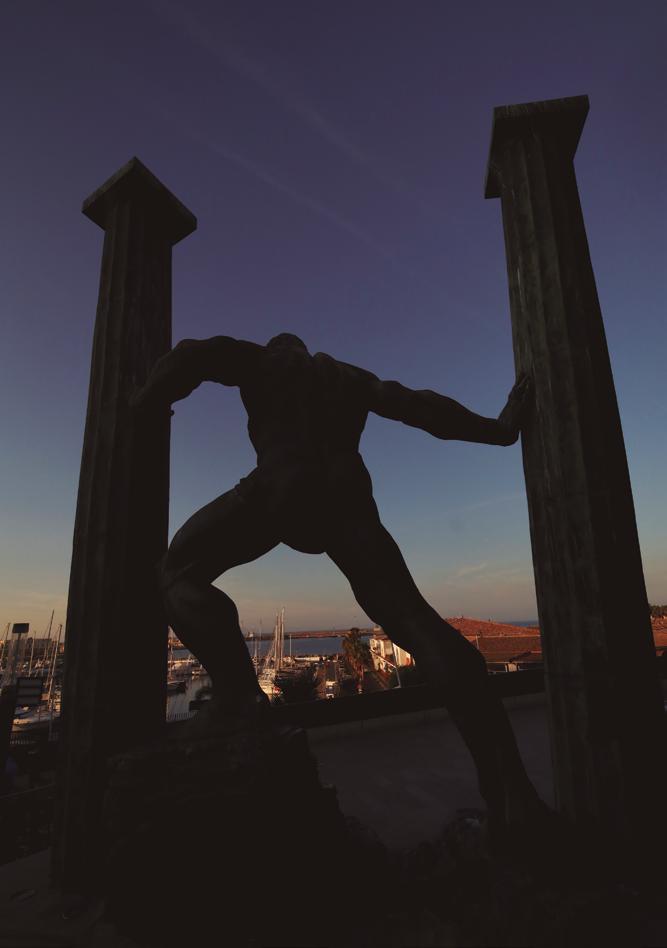

OTWO 32 / MARCH 2022 87 86 OTWO 32 / MARCH 2022

that it was considered one of the great wonders of the ancient world.
The date of its demolition of the statue is well known, it occurred between 1145 and 1146, by Ali Isa Ben Maymun, when he took up arms in Cadiz. He thought that the statue was made of gold and that he could sell it to defray his expenses. However, to his misfortune, it was only made of bronze and plated with a thin layer of gold, although, given the size of the figure, it brought him the not inconsiderable sum of twelve thousand gold dinars.
To the strange and powerful monument were dedicated praises, poems and legends were told to explain its uncertain origin. The most beautiful of them all, collected by the historian Al Maqqari, born in Algeria in 1578, goes like this:
“There was in the west of Al Andalus a Greek king who reigned over the islands of Cadiz. This king had a daughter of incomparable beauty, whom the other kings of the region - for that country was ruled by seven kings, each with estates extending over no more than one or two cities - sought in marriage. Each of these kings sent his messengers to Cadiz, to ask for the hand of the princess. Her father, however, unwilling to choose among so many suitors, lest by favoring one he should offend the others, was much perplexed, and sent for his daughter to acquaint her with his problem. It so happened that the daughter of this king possessed much wisdom as well as beauty, for among the Greeks, both men and women were born with a natural instinct for science; this led to that common saying, “science descended from heaven and lodged in three different parts of man’s body; in the brain of the Greeks, in the hands of the Chinese, and in the tongue of the Arabs”
The princess, then, having heard the whole case, said to her father:
-Just do as I tell you, and you will trouble yourself no more about this matter.
-What is your advice then? -replied the king.
-To answer those who ask for my hand, I will give preference to the one who proves to be a wise king. Her father sent messengers to the neighboring kingdoms to inform the royal suitors of his daughter’s determination. When the lovers read the letters containing the princess’s intentions, many who could not claim wisdom immediately desisted from their
Su grandeza debió ser tal, que se comparaba con el Faro de Alejandría, hasta el punto de que se le considerada como una de las grandes maravillas del mundo antiguo.
La fecha de su demolición de la estatua es bien conocida, se produjo entre 1145 y 1146, a cargo de Ali Isa Ben Maymun, cuando se alzó en armas en Cádiz. Él pensó que la estatua era de oro y que podría venderla para sufragar sus gastos. Sin embargo, para su desgracia, sólo estaba realizada en bronce y chapada por una fina capa de oro aunque, dado el tamaño de la figura, le proporcionó la nada despreciable suma de doce mil dinares de oro.
Al extraño y poderoso monumento se le dedicaron loas, poemas y se contaban leyendas para explicar su incierto origen. La más bella de todas ellas, recogida por el historiador Al Maqqari, nacido en Argelia en 1578, dice así:
«Había en el oeste de Al Andalus un rey griego que reinó sobre las islas de Cádiz. Este rey tenía una hija de incomparable belleza, a quien los otros reyes de la región —porque ese país estaba gobernado por siete reyes, cada uno de ellos con propiedades que no se extendían por más de una o dos ciudades— buscaban en matrimonio. Cada uno de estos reyes envió a sus mensajeros a Cádiz, a pedir la mano de la princesa. Su padre, sin embargo, no dispuesto a elegir entre tantos pretendientes, para que al favorecer a uno ofendiera a los demás, estaba muy perplejo y envió a buscar a su hija para familiarizarla con su problema. Sucedió que la hija de este rey poseía mucha sabiduría además de belleza, porque entre los griegos, tanto los hombres como las mujeres nacían con un instinto natural para la ciencia; esto llevó a ese dicho común: «la ciencia descendió del cielo y se alojó en tres partes diferentes del cuerpo del hombre; en el cerebro de los griegos, en las manos de los chinos y en la lengua de los árabes».
La princesa, entonces, habiendo oído todo el caso, dijo a su padre:
—Sólo haz lo que te diga y no te molestarás más por este asunto.
—¿Cuál es tu consejo entonces? —replicó el rey.
—Para que respondas a los que solicitan mi mano, daré preferencia a aquel que demuestre ser un rey sabio.
Su padre envió mensajeros a los reinos vecinos

OTWO 32 / MARCH 2022 89 88 OTWO 32 / MARCH 2022
courtship. Only two kings who considered themselves scholars were found among her many admirers and they immediately responded to her letters, each saying of himself, “I am a wise king.”
When the father received these letters, he called for his daughter and, informing her of their contents, said:
-Look, we are still in the same difficulty as before, for here are two kings who both call themselves wise, and, if I choose one, I shall make an enemy of the other. What do you propose to do in such a difficulty? -said the king.
-I will impose a task on both kings, and the one who executes it best will be my husband. We need in this city water to drink and a waterwheel to distribute the water; I will ask one of them to make me a wheel to be moved by the fresh running water coming from those shores; and I will entrust to the other the construction of a talisman or a spell to preserve this island from the invasions of the Berbers,” replied the princess.
The king was delighted with the plan suggested by his daughter, and, without bestowing further consideration on the subject, wrote to both princes, acquainting them with his daughter’s final determination, and, each having agreed to submit to the intended test, they set to work as soon as possible.
The king to whose fate it had fallen to construct the hydraulic machine erected an immense edifice, with large stones placed one above the other, in that part of the salty sea which separates the island of Andalus from the mainland, and at the place known by the name of the Straits of Ceuta. This arched building, which was built entirely of free stone, the interstices of which were filled by the architect with some cement of his own composition, connected the island of Cadiz with the North African coast. Traces of this work are still to be seen in that part of the sea which divides Ceuta from Algeciras,” but most of the inhabitants of Andalus assign to it another origin, as I have elsewhere explained; they suppose it to be the remains of a bridge which Alexander the Great ordered to be built between Ceuta and Algeciras: but God only knows which of the two reports is true, though I find that the latter of the two is generally believed.
When the architect had finished his stonemasonry work, he conducted fresh water from the top of a
para comunicar a los pretendientes reales la determinación de su hija. Cuando los amantes leyeron las cartas que contenían las intenciones de la princesa, muchos que no podían reclamar sabiduría, inmediatamente desistieron de su noviazgo. Sólo dos reyes que se consideraban eruditos se encontraron entre sus numerosos admiradores y respondieron inmediatamente a sus cartas, cada uno diciendo de sí mismo: “Soy un rey sabio”.
Cuando el padre recibió estas cartas, llamó a buscar a su hija e, informándole de su contenido, dijo: —Mira, todavía estamos en la misma dificultad que antes, porque aquí hay dos reyes que ambos se llaman sabios y, si elijo uno, me haré enemigo del otro. ¿Qué te propones hacer en tal dificultad? —dijo el rey.
—Impondré una tarea a ambos reyes y el que la ejecute mejor, será mi marido. Necesitamos en esta ciudad agua para beber y una noria para distribuir el agua; le pediré a uno de ellos que me haga una rueda que sea movida por el agua corriente fresca procedente de aquellas costas; y confiaré al otro la construcción de un talismán o un hechizo para preservar esta isla de las invasiones de los bereberes
—respondió la princesa.
El rey estaba encantado con el plan sugerido por su hija y, sin otorgar más consideración sobre el tema, escribió a ambos príncipes, familiarizándolos con la determinación final de su hija y, habiendo acordado cada uno someterse a la prueba prevista, se pusieron a trabajar lo antes posible.
El rey a cuya suerte había caído para construir la máquina hidráulica erigió un inmenso edificio, con grandes piedras colocadas una encima de otra, en esa parte del mar salado que separa la isla de Andalus del continente, y en el lugar conocido con el nombre de Estrecho de Ceuta. Este edificio arqueado, que fue construido completamente de piedra libre, cuyos intersticios fueron llenados por el arquitecto con algo de cemento de su propia composición, conectaba la isla de Cádiz con la costa norteafricana. Todavía se ven rastros de esta obra en esa parte del mar que divide Ceuta de Algeciras”, pero la mayor parte de los habitantes de Andalus le asignan otro origen, como ya he explicado en otros lugares; suponen que son los restos de un puente que Alejandro Magno ordenó que se construyera entre Ceuta y Algeciras: pero
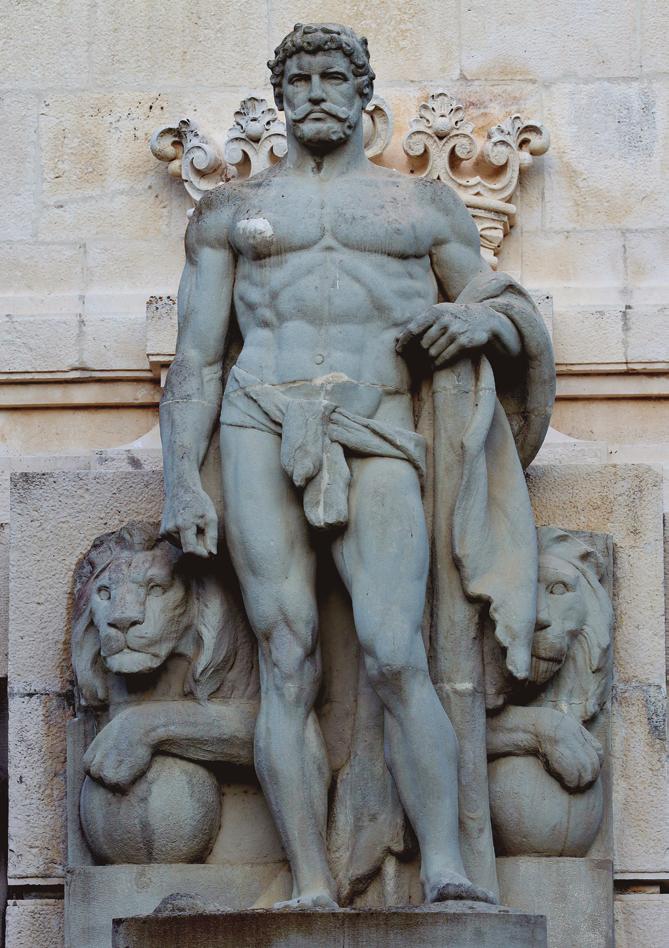

OTWO 32 / MARCH 2022 91 90 OTWO 32 / MARCH 2022
high mountain on the African continent to the island of Cadiz, poured it afterwards into a pool, and caused it to rise again by means of the waterwheel.
As for the other king, whose task was the construction of the magic spell, he first consulted the heavens in search of the right time to begin its manufacture and, when he discovered it, he began to construct a square building. The materials were of white stone and the site chosen for its construction was a sandy desert by the sea. To give sufficient solidity to the building, the architect sunk the foundations as deep into the earth as the building itself rose above the surface, and, when completed, placed on the top a statue of molten copper and iron, mixed by dint of his science, to which he also gave the appearance of a Berber, with a long beard and hair. “His clothing consisted of a tunic, the ends of which he held up with his left arm; he wore sandals on his feet, and the most extraordinary thing about him was that, although the dimensions of the figure were excessive, and he rose in the air at a distance of more than sixty or seventy cubits, no other support was visible than the natural one at his feet, which were at most one cubit in circumference. His right arm was outstretched, and in his hand were seen some padlocked keys; with his right hand he was pointing towards the sea, as if he were saying, “No one must pass this way.” In addition, such was the magical virtue contained in this figure, that as long as he kept his place and held the keys in his hand, no Barbary ship could cross the Straits. Each of the kings worked at an unusual activity in his usual occupation, but in the hope that whoever achieved his goal first would have the opportunity to win the heart of the princess. The builder of the aqueduct was the first to finish his, but he managed to keep it secret in the hope that, if he did his work first, the talisman would not be completed, although the victory would remain for him. And so it happened, for he measured his time so well, that on the very day when his rival’s work was to be completed, the water began to run on the island, and the wheel moved; and when the news of his success reached his competitor, who was then at the top of the monument giving the last polish to the face of the statue, which was golden, he took it so seriously that he dropped down and died at the foot of the tower;

Dios solo sabe cuál de los dos informes es el verdadero, aunque encuentro que el último de los dos se cree en general.
Cuando el arquitecto terminó su trabajo de cantería, condujo agua dulce desde la cima de una alta montaña en el continente africano hasta la isla de Cádiz, la vertió después en un estanque e hizo que se elevara de nuevo por medio de la noria. En cuanto al otro rey, cuya tarea era la construcción del hechizo mágico, primero consultó los cielos en busca del momento adecuado para iniciar su fabricación y, cuando lo descubrió, comenzó a construir un edificio cuadrado. Los materiales eran de piedra blanca y el lugar elegido para su construcción era un desierto arenoso a orillas del mar. Para dar suficiente solidez al edificio, el arquitecto hundió los cimientos tan profundamente en la tierra como el propio edificio se elevaba por encima de la superficie y, cuando lo completó, colocó en la parte superior una estatua de cobre fundido y hierro, mezclada a fuerza de su ciencia, a la que además le dio la apariencia de un bereber, con una barba y cabello largos. “Su ropa consistía en una túnica, cuyos extremos sostenía con el brazo izquierdo; llevaba sandalias en los pies, y lo más extraordinario de él era que, aunque las dimensiones de la figura eran excesivas, y se levantaba en el aire a una distancia de más de sesenta o setenta codos, no se veía otro soporte que el natural a sus pies, que tenían como máximo un codo de circunferencia. Tenía el brazo derecho extendido, y en su mano se veían algunas llaves con candado; con su mano derecha apuntaba hacia el mar, como si estuviera diciendo: «nadie debe pasar por este camino». Y tal era la virtud mágica contenida en esta figura, que mientras mantuviera su lugar y tuviera las llaves en su mano, ningún barco de Berbería podría cruzar el Estrecho.
Cada uno de los reyes trabajó en una actividad poco común en su quehacer habitual, pero con la esperanza de que, quien lograra antes su objetivo, tendría la oportunidad de ganarse el corazón de la princesa. El constructor del acueducto fue el primero en terminar el suyo, pero se las arregló para mantenerlo en secreto con la esperanza de que, si hacía su trabajo primero, el talismán no se completaría aunque la victoria quedaría para él. Y así sucedió, porque midió su tiempo tan bien, que el mismo día en que se
OTWO 32 / MARCH 2022 93 92 OTWO 32 / MARCH 2022
whereupon the other prince, freed from his rival, became the master of the lady, of the wheel, and of the protecting charm. “
Both consorts probably formed a wise, astute and calculating couple.
The oldest references to the importance of the statue come from the Mozarabic Chronicle of the year 754, where the entry of the Muslims into the Iberian Peninsula is narrated. This document only records the classic function of the Pillars of Hercules, which was only to warn of the Non (terrae) Plus Ultra, so that Mediterranean sailors would not enter the dangerous and unknown ocean. However, little by little, in the following centuries, the idea of the magical attributes of the Heracles or, at least,
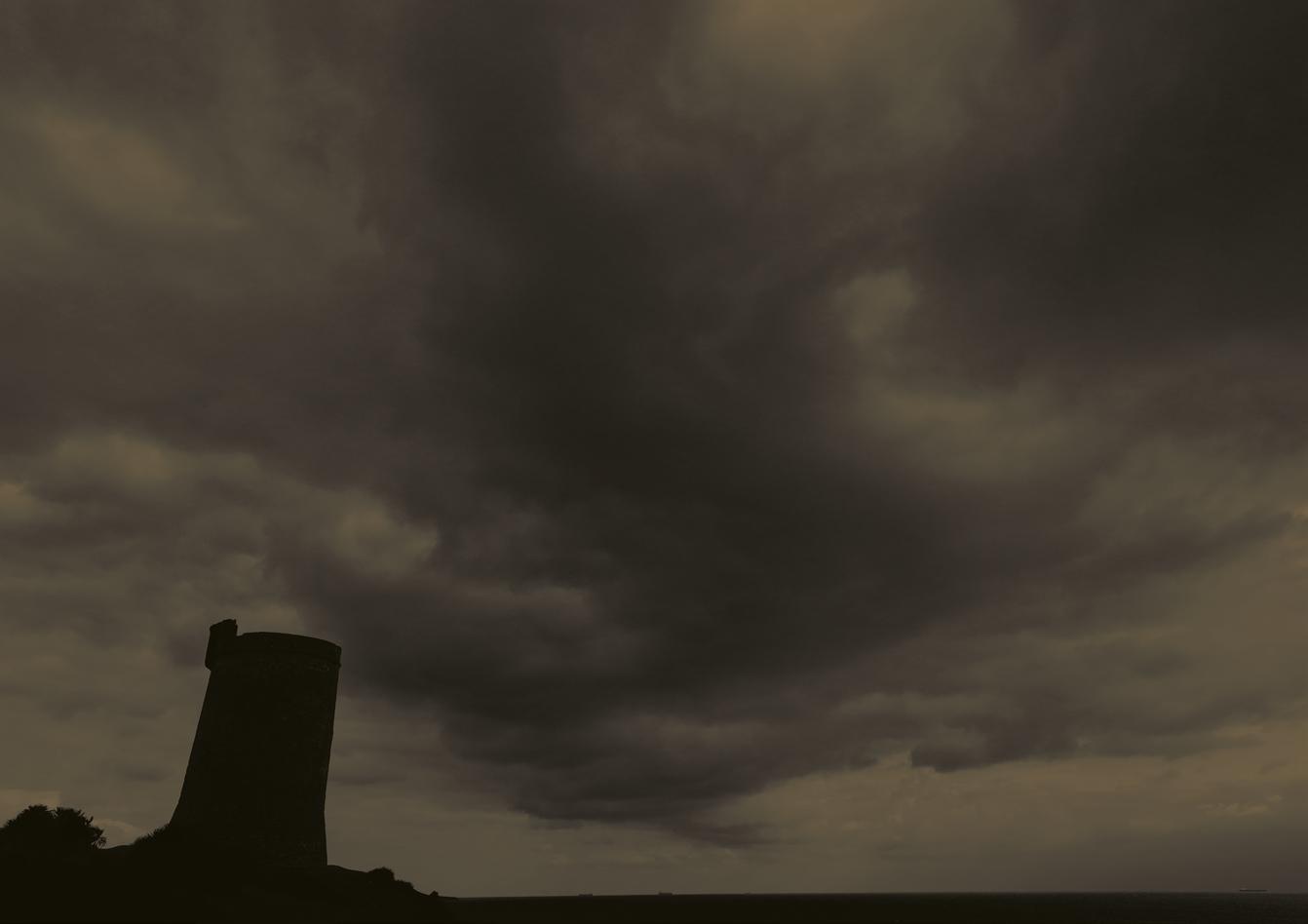
iba a completar el trabajo de su rival, el agua comenzó a correr en la isla, y la rueda se movió; y cuando la noticia de su éxito llegó a su competidor, que entonces estaba en la cima del monumento dando el último pulido a la cara de la estatua, que era dorada, se lo tomó tan en serio que se dejó caer y murió al pie de la torre; por lo que el otro príncipe, liberado de su rival, se convirtió en el maestro de la dama, de la rueda y del encanto protector.»
Ambos consortes probablemente conformaran una bien avenida pareja sabia, astuta y calculadora.
Las referencias más antiguas sobre la trascendencia de la estatua provienen de la Crónica Mozárabe del año 754, donde se narra la entrada de los musulmanes en la Península Ibérica. Este documento
of the statue of the island of Cádiz, took shape. The idea that underlies all interpretations is that the hero possessed the keys of the Strait and as long as he kept them in his hands, the winds would prevent Berber fleets from attacking the Iberian shore. The spell was also functional to the Andalusians. They believed that, if the keys fell once, there would be great unrest in the country and if they fell a second time, Al Andalus would be conquered by the northern kingdoms. In fact, the demolition of the Cadiz statue was popularly blamed for the fall of Cordoba to the Christian invaders.
solo recoge la función clásica de las columnas de Hércules, que era únicamente avisar de aquel Non (terrae) Plus Ultra, para que los navegantes mediterráneos no se internaran en el peligroso y desconocido océano. Sin embargo, poco a poco, en los siglos siguientes, va tomando cuerpo la idea de los atributos mágicos de las Herácleas o, al menos, de la estatua de la isla gaditana. La idea que subyace en todas las interpretaciones es que el héroe poseía las llaves del Estrecho y mientras las conservase sobre sus manos, los vientos impedirían que flotas berberiscas atacasen la orilla ibérica. El hechizo también era funcional a los andalusíes. Creían que si las llaves se caían una vez, habría grandes disturbios en el país y si se caían una segunda vez, Al Andalus sería conquistada por los reinos del norte. De hecho, popularmente se culpaba a la demolición de la estatua gaditana de la caída de Córdoba en manos de los invasores cristianos.
OTWO 32 / MARCH 2022 95 94 OTWO 32 / MARCH 2022
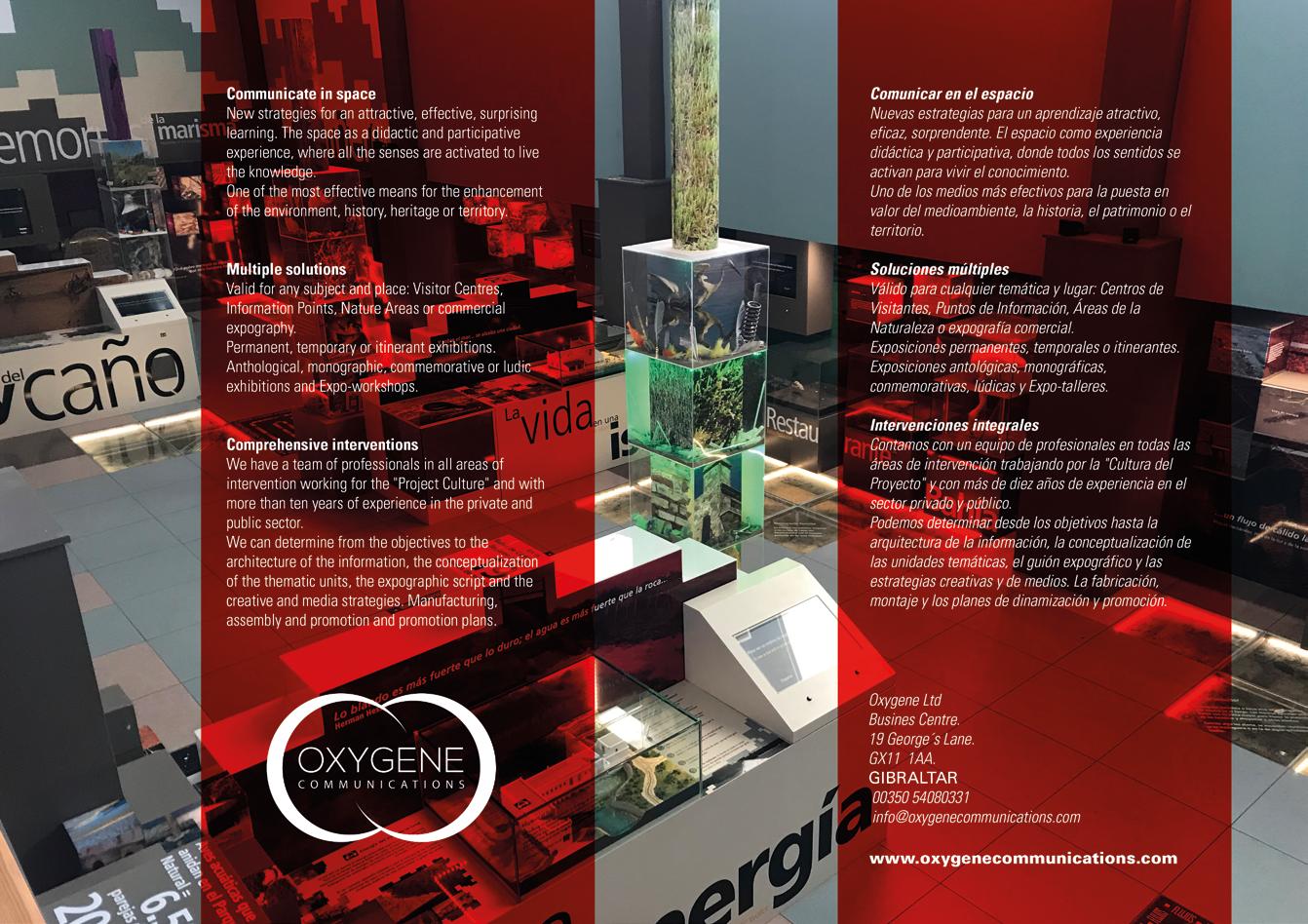
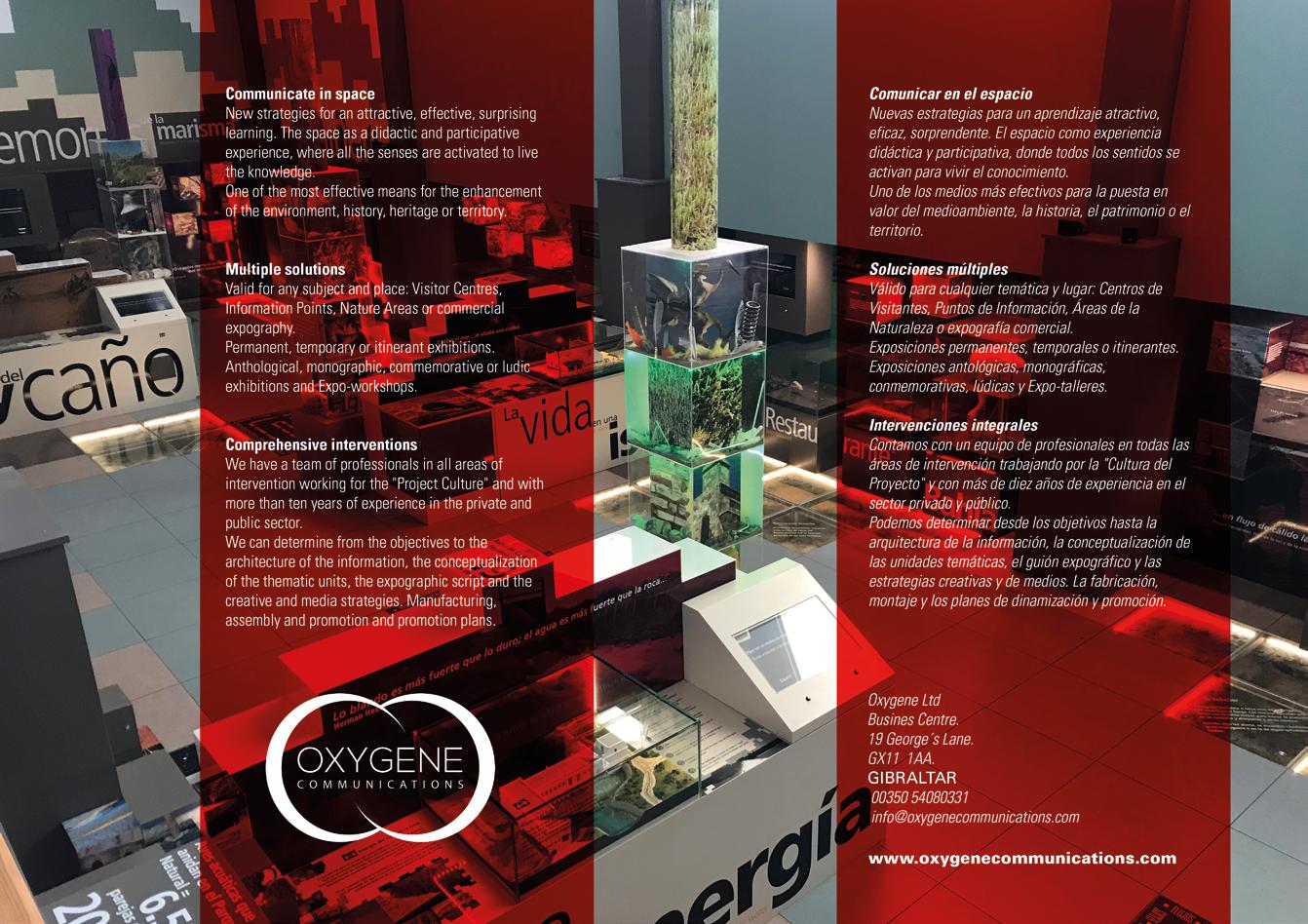

March is Self-Harm Awareness Month
Marzo es el mes de la concienciación sobre las autolesiones

“Self-Harm”. A word that makes people feel very uncomfortable, but we must talk about it. There are many misconceptions about it, and it’s time that we quash all those myths on this very serious topic.
A common myth is that people assume that people who self-harm are trying to seek attention for the sake of being talked about. However, they usually don’t tell close family members and friends. Often, they tend to solemnly admit that they are damaging themselves when their habit has gone too far only because they are asking for help. A person who self-harms tries to hide any scars left on the body such as wearing bandages or long clothing.
Another common myth is that only people who have depression do it. It is true that people who suffer from any mental illness are more likely to self-harm, but it’s also common for people with any form of Autism who are also at risk. It is a coping mechanism for when they become stressed. Even if you don’t have any of these disorders or don’t suffer from any mental health problems, it can still happen to you. Ever picked at a scab? You may stop when you start to feel pain or when you start to bleed which is a perfectly normal response, and your body will heal on its own. Some people just can’t stop the tempting urge to keep doing it for days, weeks or even months.
People who self-harm suffer a lot as they can’t control themselves and their wounds heal much slower. If they have been continuously self-harming or have really hurt themselves, they must seek advice via a local GP.
Experts say that Covid-19 has had a huge impact on everyone’s mental health, especially on young people. More young people are self-harming in the U.K. According to official statistics, the rate has double over the last six years. The number of children aged nine to 12 admitted to hospital having hurt themselves, intentionally rose from 221 in 2013-14 to 508 in 2019-20. Gibraltar as a whole needs to work together so that we can give those who self-harm the professional help that they deservingly need.
«Autolesión». Una palabra que hace que la gente se sienta muy incómoda, pero debemos hablar de ella. Hay muchas ideas erróneas al respecto, y es hora de que acabemos con todos esos mitos sobre este tema tan serio.
Un mito común es que la gente asume que las personas que se autolesionan tratan de buscar atención para que se hable de ellas. Sin embargo, normalmente no se lo cuentan a los familiares y amigos cercanos. A menudo, tienden a admitir solemnemente que se están dañando a sí mismos cuando su hábito ha ido demasiado lejos sólo porque están pidiendo ayuda. La persona que se autolesiona intenta ocultar las cicatrices que le quedan en el cuerpo, por ejemplo, usando vendas o ropa larga.
Otro mito común es que sólo lo hacen las personas que tienen depresión. Es cierto que las personas que padecen cualquier enfermedad mental son más propensas a autolesionarse, pero también es habitual en personas con cualquier tipo de autismo que también corren el riesgo de hacerlo. Es un mecanismo de afrontamiento para cuando se estresan. Aunque no tengas ninguno de estos trastornos o no sufras ningún problema de salud mental, puede ocurrirte. Si alguna vez te rascas una costra, puedes dejar de hacerlo cuando empieces a sentir dolor o cuando empieces a sangrar, lo cual es una respuesta perfectamente normal, y tu cuerpo se curará por sí solo. Algunas personas simplemente no pueden detener el tentador impulso de seguir haciéndolo durante días, semanas o incluso meses.
Las personas que se autolesionan sufren mucho porque no pueden controlarse y sus heridas se curan mucho más lentamente. Si se han autolesionado continuamente o se han hecho daño de verdad, deben pedir consejo a su médico de cabecera.
Los expertos afirman que Covid-19 ha tenido un gran impacto en la salud mental de todos, especialmente en los jóvenes. Cada vez hay más jóvenes que se autolesionan en el Reino Unido. Según las estadísticas oficiales, la tasa se ha duplicado en los últimos seis años. El número de niños de entre nueve y doce años ingresados en el hospital por haberse autolesionado, aumentó intencionadamente de 221 en 2013-14 a 508 en 2019-20. Gibraltar en su conjunto tiene que colaborar para que podamos dar a los que se autolesionan la ayuda profesional que merecen.
99 98
OTWO 32 / MARCH 2022 OTWO 32 / MARCH 2022
El camino de la naturaleza Nature’s
Dr.Owen Wiseman
Tree-mendous worth. The true value of our canopy. El valor de los árboles. El verdadero valor de nuestra copa.
Way

Continuing with the topic of climate change and the value of our ecosystem, today is focusing on how much a tree is truly worth. For those of us actively involved in protecting nature for future generations, the answer is ‘priceless’, but for policy- and decision-makers, they need a number.
A unique article, our study of the month actually gathered the input of multiple specialists and experts across the world regarding trees as nature-based solutions in the fight to save our planet. Opinions flowed through professors from Stanford University, Oxford and the University of British Columbia, but could all agree that a healthy canopy leads to healthy humans?
Did nature have its way?
Indeed! Trees enhance local biodiversity, clean and recycle our water, and stabilize soils and the climate. 500 trees can store enough carbon to offset the emissions released by a single vehicle in a year. By filtering pollution, it has been estimated that trees mitigate almost $7 billion in health costs per year by keeping humans healthier. Furthermore, a report by the World Resources Institute determined
that an investment of ~ $4.5 billion to restore 60 billion trees in the US over 20 years would help create 150,000 jobs. Not to mention the billions of dollars in savings by combatting natural disasters.
Convinced yet?
Join us next month to learn how architects are developing aesthetically pleasing nature-based solutions. In the meantime, follow Science & Nature for weekly research bites and to connect with our author.
“Trees as Nature-Based Solutions.” One Earth (2020): 387-389.
Siguiendo con el tema del cambio climático y el valor de nuestro ecosistema, hoy nos centramos en cuánto vale realmente un árbol. Para quienes participamos activamente en la protección de la naturaleza para las generaciones futuras, la respuesta es “incalculable”, pero para los responsables políticos y de la toma de decisiones, necesitan una cifra.
Nuestro estudio del mes, un artículo único en su género, reunió la opinión de múltiples especialistas y expertos de todo el mundo sobre los árboles como soluciones basadas en la naturaleza en la lucha por salvar nuestro planeta. Las opiniones fluyeron a través de profesores de la Universidad de Stanford, Oxford y la Universidad de la Columbia Británica, pero ¿podrían todos estar de acuerdo en que un dosel saludable conduce a seres humanos saludables?
¿La naturaleza se salió con la suya?
Sí, así es. Los árboles mejoran la biodiversidad local, limpian y reciclan nuestra agua y estabilizan los suelos y el clima. 500 árboles pueden almacenar suficiente carbono para compensar las emisiones liberadas por un solo vehículo en un año. Al filtrar la contaminación, se ha calculado que los árboles mitigan casi 7.000 millones de dólares en costes sanitarios al año al mantener a los seres humanos más sanos. Además, un informe del Instituto de Recursos Mundiales determinó que una inversión de unos 4.500 millones de dólares para restaurar 60.000 millones de árboles en EE.UU. durante 20 años ayudaría a crear 150.000 puestos de trabajo. Por no hablar de los miles de millones de dólares que se ahorrarían al combatir las catástrofes naturales.
¿Ya estás convencido?
Acompáñanos el mes que viene para saber cómo los arquitectos están desarrollando soluciones estéticas basadas en la naturaleza. Mientras tanto, siga a Ciencia y Naturaleza para conocer los avances semanales de la investigación y conectarse con nuestro autor.
“Los árboles como soluciones basadas en la naturaleza”. One Earth (2020): 387-389.
101 100 ???????
OTWO 32 / MARCH 2022 OTWO 32 / MARCH 2022

Lentil and falafel bake
Pastel de lentejas y falafel

DESCRIPTION
I came across this recipe a few weeks ago and loved it. So I thought I would share it with you. I did sprinkle with grated cheese to garnish along with the parsley although it’s not in the recipe. Enjoy!
INGREDIENTS
1 pack Falafels.
1 tbsp olive oil.
1 small onion, diced.
1 clove garlic, crushed.
1/2 yellow pepper, diced.
1/2 red pepper, diced.
1/2 green pepper, diced.
½ tsp ground cumin.
½ tsp ground coriander.
1/16th tsp (pinch) ground cinnamon.
1 small red chilli, diced.

400g tin cooked green lentils, drained.
150ml vegetable stock.
150ml tomato passata.
1 tbsp tomato puree.
2 tbsp sultanas.
Small bunch of parsley, chopped.
METHOD:
Preheat the oven to 180°C/350°F/Gas Mark 4.
Heat the oil in a pan and gently fry the onions, garlic and peppers for 4-5 minutes. Add the spices and cook for 1-2 minutes longer. Add the chilli, lentils, vegetable stock, tomato passata, tomato puree and sultanas and bring to the boil.
Carefully pour into an oven proof container, break each Falafel roughly into two and place on top of the bake to form a falafel topping. Bake for 20 minutes, remove from the oven and scatter the parsley over.
Serve with steamed or roasted Vegetables.

DESCRIPCIÓN
Encontré esta receta hace unas semanas y me encantó. Así que pensé en compartirla con vosotros.
Yo espolvoreé con queso rallado para decorar junto con el perejil, aunque no está en la receta.
¡Que lo disfrutes!
INGREDIENTES
1 paquete de Falafels.
1 cucharada de aceite de oliva.
1 cebolla pequeña, cortada en dados.
1 diente de ajo machacado.
1/2 pimiento amarillo, cortado en dados.
1/2 pimiento rojo, cortado en dados.
1/2 pimiento verde picado.
½ cucharadita de comino molido.
½ cucharadita de cilantro molido.
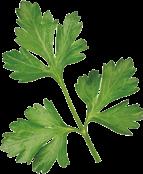
1/16 de cucharadita (pizca) de canela molida.
1 guindilla roja pequeña, cortada en dados.
400 g de lentejas verdes cocidas, escurridas.
150 ml de caldo de verduras.
150 ml de passata de tomate.
1 cucharada de puré de tomate.
2 cucharadas de pasas sultanas.
Pequeño manojo de perejil picado.
PREPARACIÓN:
Precalentar el horno a 180°C/350°F/Gas Mark 4.
Calentar el aceite en una sartén y sofreír la cebolla, el ajo y los pimientos durante 4-5 minutos. Añadir las especias y cocinar durante 1-2 minutos más.
Añadir la guindilla, las lentejas, el caldo de verduras, la passata de tomate, el puré de tomate y las pasas sultanas y llevar a ebullición.
Verter con cuidado en un recipiente apto para el horno, partir cada falafel en dos y colocarlo encima para formar una cobertura de falafel. Hornear durante 20 minutos, sacar del horno y esparcir el perejil por encima.
Servir con verduras al vapor o asadas.
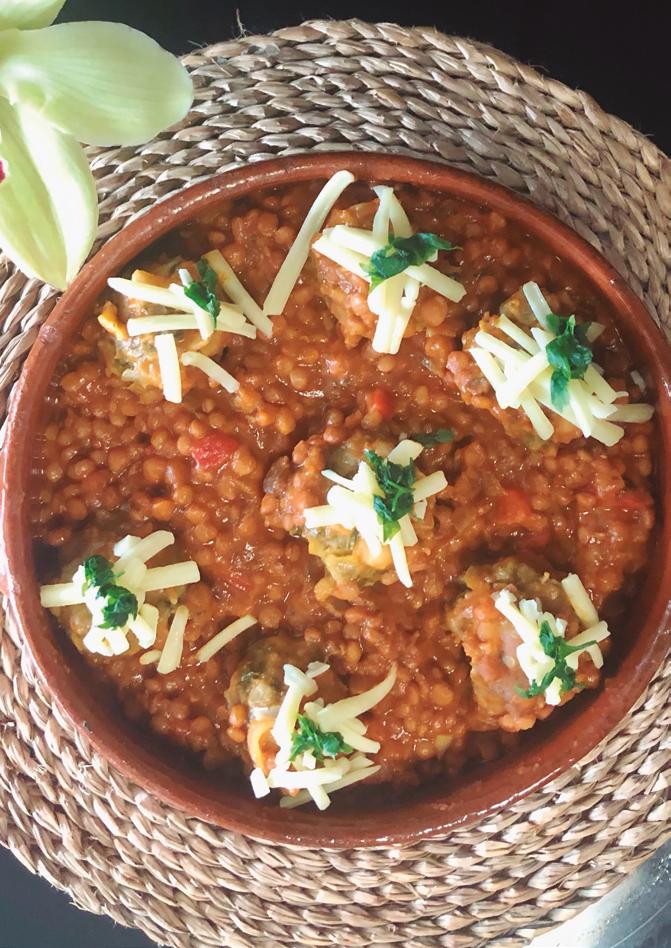
102 103 OTWO 32 / MARCH 2022 OTWO 32 / MARCH 2022
Guía rápida de: Noruega.

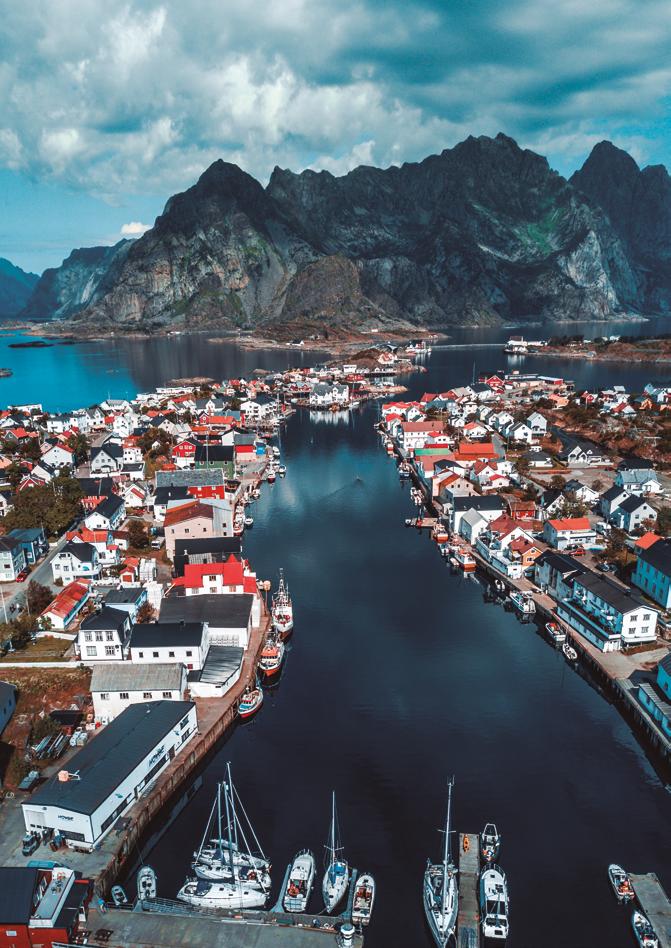
Language: Norwegian.
Currency: Norwegian Krone (NOK).
Capital: Oslo.
Famous for: Viking history & folklore. Fjords. Norwegian Salmon. Some top places: Enjoy top-notch art and culture in Oslo . Take the exceptional ferry journey along the Geirangerfjord. Discover more about the Sami culture in Karasjok. Wonder at the beautiful landscapes of the Lofoten Islands. Explore the beautiful city of Bergen. Experience the many hiking trails of Jotunheimen National Park. Hike up Preikestolen and wonder at the magnificent views. Spot polar bears, the northern lights and more in Svalbard..
Activities: History, hiking, camping, northern lights, wildlife, winter sports, gastronomy.
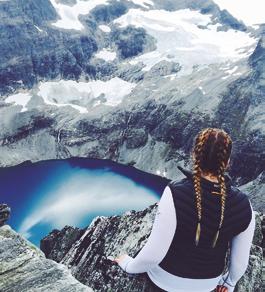
Weather:
High Season (Jun to Aug) Warmest weather, busy. Shoulder (May to Jun & Aug to Sep) Mild weather, not as busy.
Low Season (Oct to Apr) Cold weather, cheaper, few tourists.
Eco fact: Norway’s recycling scheme is so efficient, that the country manages to recycle 97% of all plastic bottles they use.
Eco resorts:
Budget: Basecamp Explorer from £100 per night (Svalbard). Mid: Thon Hotel Opera from £120 per night (Oslo). Luxury: The Juvet from £220 per night (Valldal Region).
Idioma: Noruego.
Moneda: Corona Noruega (NOK).
Capital: Oslo.
Famoso por: Historia vikinga y el folclore. Fiordos. Salmón Noruego.
Algunos de los mejores lugares: Disfruta del fantástico arte y cultura de Oslo. Viaja por la excepcional Geirangerfjord en barco. Descubre la cultura Sami en Karasjok. Admira los preciosos paisajes de las Islas Lofoten. Explora la bonita cuidad de Bergen. Camina por los senderos del Parque Nacional Jotunheimen. Escala Preikestolen y admira las magníficas vistas. Observa osos polares, la aurora boreal y mucho más en Svalbard..
Actividades: Historia, senderismo, camping, aurora boreal, fauna, deportes invernales, gastronomía.
Clima:
Temporada Alta (Jun a Ago) Clima cálido, mucho turismo.
Temporada Intermedia (May a Jun & Ago a Sep) Clima templado, no tanto turismo.
Temporada Baja (Oct a Abr) Clima frio, más económico, pocos turistas.
Hecho ecológico:
El sistema de reciclaje de Noruega es tan eficiente, que el país recicla el 97% de todas las botellas de plástico que usa.
Resorts ecológicos:
Económico: Basecamp Explorer desde £100 por noche (Svalbard).
Medio: Thon Hotel Opera desde £120 por noche (Oslo).
Lujo: The Juvet desde £220 por noche (Valldal Region).
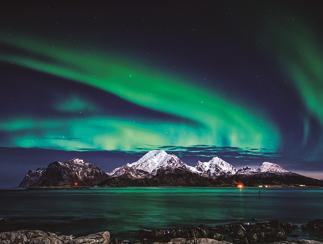
105 104
OTWO 32 / MARCH 2022 OTWO 32 / MARCH 2022
Norway






It’s been a long ol’ summer. But the end is nearly in sight – crispy leaves on the ground and a chill in the air signals the imminent return to school for kids.
And with that, a collective sigh of relief from parents across the country who’ve had to entertain their little tornadoes of terror for Six. Whole. Weeks. keep reading




OTWO 25 / AUGUST 2021 OTWO 24 / JULY 2021 Plastic Free • Carbon Footprint • Vegan & Cruelty Free Why Bamboo • Kind to Skin FOR MORE INFORMATION CLICK ON EACH SECTION PRODUCT RANGE
Roll, Kitchen Roll, Facial Tissue, Pocket Tissue, Baby Wipes, Anti-Bacterial Handy Wipes, Anti-Bacterial Surface Wipes, Make-Up Cleansing Wipes, Straws, Shaker Straws, Baby Nappies. www.bamboopanda.gi Shop via our new website now live! Discounted Products, Monthly Subscription Services and more! The Future is Cheeky
Toilet
Back to school sustainable tips & essentials
Catálogo de Experiencias PRIMAVERA 22 SPRING CATALOG 22 Organized by: OTWO Magazine Tel. +00350 22500799 info@otwomag.com Transport available for groups. Check with us for your requirements. OTWO is a facilitator on these packages. All activities are contracted directly between the respective centre operator and the client. Prices are for the month of March only, please contact us for other dates. Transporte disponible para grupos. Consultenos si estás interesado. OTWO es un mediador de estos paquetes. Todas las actividades se contratan directamente entre el operador y el cliente. Precios válidos solo para el mes de marzo, consulte para otras fechas. OTWO 32 / MARCH 2022 107
EBikes Group Tours Gibraltar

EBIKES GROUP TOURS
Gibraltar
Enjoy breath taking views across 3 countries and 2 continents, explore Gibraltar’s fascinating history and be introduced to our most famous inhabitants, the Barbary macaques – the only free roaming monkeys in Europe!
Price: £69 per person.
Highlights
Europa Point and Lighthouse. Upper Rock Nature Reserve.
Pillars of Hercules Monument.
Windsor Suspension Bridge. O’Hara’s Battery (top of Rock 424m). Skywalk.
Ape’s Den.
Great Siege Tunnels.
Moorish Castle. …And many more.
What’s included?
Premium e-bike by Riese&Müller. Cycle helmet.
Safety instructions.
Entrance fee into the Nature Reserve. An official tour guide. Bottled water.
DURATION:
3 hours. Suitable for everyone over 155 cm, over 12 years old and capable of riding a bicycle.
GROUP TOURS
Gibraltar
Disfrute de las impresionantes vistas de 3 países y 2 continentes, explore la fascinante historia de Gibraltar y conozca a nuestros habitantes más famosos, los macacos de Berbería, ¡los únicos monos que se desplazan libremente en Europa!
Precio: £69 por persona.
Puntos destacados
Punta de Europa y el Faro
Reserva Natural Upper Rock (Parte superior del peñon)
Monumento de las Columnas de Hércules
Puente colgante de Windsor
Bateria de O’Hara (parte superior del peñon - 424m).
El Skywalk
Guarida de los monos
Gran túneles de asedio
Castillo Arabé. …y muchos más
¿Qué está incluido?
Alta calidad E-bike de Riese&Müller. Casco de bicicleta
Instrucciónes de seguridad
Entrada a la reserva natural Guía oficial Agua embotellada.
DURACIÓN:
3 horas. Adecuadas para todos los que midan más de 155 cm, tengan más de 12 años de edad y puedan montar en bicicleta.
Organized by: OTWO Magazine
Tel. +00350 22500799
info@otwomag.com
Transport available for groups.Check with us for your requirements.
OTWO is a facilitator on these packages. All activities are contracted directly between the respective centre operator and the client.
Organized by: OTWO Magazine
Tel. +00350 22500799
info@otwomag.com
Transporte disponible para grupos.
Consultenos si estás interesado.
OTWO es un mediador de estos paquetes. Todas las actividades se contratan directamente entre el operador y el cliente.
109 108
OTWO 32 / MARCH 2022 OTWO 32 / MARCH 2022
COASTEERING IN GIBRALTAR
What is Coasteering?
The activity of coasteering involves making you way along the coastline usually along steep cliffs and rocky outcrops. We use a variety of techniques that may include other outdoor activities such as walking, scrambling, climbing, jumping, abseiling (rappelling), and swimming.
Where do we meet?
We meet at the IN2ADVENTURES Sandy Bay Activity centre where we can start our activity enjoying our beautiful beach. We like our clients to use public transport if possible, in order to reduce our carbon footprint. Please get in touch if you need some advice.
What kind of equipment do you provide?
We provide all the technical equipment you will need for this activity; this is routinely inspected and is UIAA approved (Union International de Associaciones Alpinistas). You will be given a wet suit, safety helmet and climbing harness. Before we start, we will give all participants a comprehensive safety brief and how to use the equipment correctly.
How fit do I need to be?
An average level of mobility will help you enjoy the day. But this activity is easily tailored to any fitness level.
What is the minimum age that can come coasteering?
We recommend that children should be 9 or over for this activity. Please let us know if any of the participants are weak or non-swimmers.
What should I bring?
Old trainers that will get wet. Change of clothes. Towel. Sun Cream. Water.
If you have long hair, please tie it up but remember that you will need to put a helmet on. Avoid loose or dangly bits.
Can I bring my own kit and equipment?
Yes, but it will be inspected by the instructor to make sure it is serviceable and correct.
The standard route is as follows:
Start at the activity center, receive equipment induction and safety briefs. Walk a few hundred meters to the north end of the beach and climb the steps to the old cable platform where the group will abseil into the shoreline.
Follow the shoreline north towards Black Strap cove by scrambling over rocks swimming between pools and generally making progress. Continue north past the cove to ‘Frieda’ (the jump) this is an optional jump for those brave enough to do it.
After jumping climb up to the Zip line launch point.
Zoom along our amazing 100m line and arrive at the south end of Black Strap Cove.
At this point we make our way back to the Activity Centre, depending on time left and prevailing conditions either by wild swimming or walking or a combination of both.
What if the weather is bad?
We can usually continue regardless of the weather, only a really wild storm will stop us! Don’t worry we will let you know if we can go ahead or not. Your safety is our primary concern.
Do sessions ever get cancelled?
Whilst every attempt is made to ensure that activities go ahead, we will notify the client of cancellation as soon as practicable where we believe on reasonable grounds that cancellation is necessary due to dangerous and/or unsuitable conditions for the activity. We reserve the right to cancel, reschedule or amend any activity/trip due to safety reasons such as adverse weather or operating conditions. If we cancel your activity you will receive a full refund of any payments made.
Our instructors reserve the right to ask clients to leave if they are compromising the safety or enjoyment of the group.
Can I Cancel?
Of course, but an advance non-refundable deposit is required to confirm your booking.
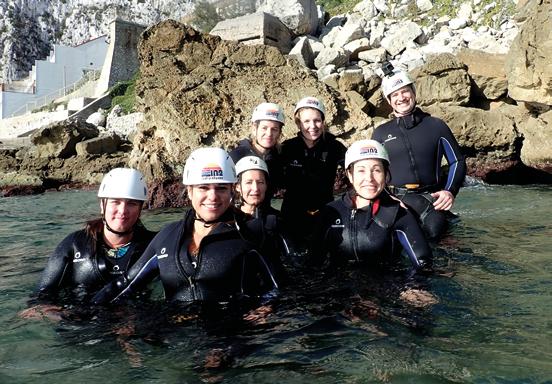

111 110 OTWO 32 / MARCH 2022 OTWO 32 / MARCH 2022
COASTEERING EN GIBRALTAR
¿Qué es Coastering?
La actividad deportiva de Coastering, conlleva aventurarse en un recorrido costero combinando acantilados escarpados y formaciones rocosas. Utilizamos una variedad de técnicas que pueden incluir diversas actividades al aire libre como travesía, escalada, saltos de altura, rápel, natación y buceo.
¿Dónde nos reunimos?
Nos congregamos en el centro de actividad de IN2ADVENTURES Sandy Bay, donde comenzamos nuestra actividad disfrutando de la hermosa playa. Nos complace que nuestros clientes - de ser posibles- utilicen el transporte público, con el fin de reducir nuestra huella de carbono. Contacte con nosotros si necesita consejo sobre ello.
¿Qué tipo de equipo proporcionan?
Facilitamos todo el equipo técnico que necesitará para practicar el coastering. Un instrumental que se inspecciona de forma rutinaria y que está aprobado por la UIAA (Unión Internacional de Asociaciones Alpinistas). Se le suministrará un traje de neopreno, casco de seguridad y arnés de escalada. Antes de empezar, daremos a todos los participantes instrucciones completas de seguridad y de cómo utilizar el equipo correctamente.
¿Qué forma física debo tener?
Un nivel medio de movilidad le ayudará a disfrutar del día. Pero esta actividad se adapta fácilmente a cualquier condición física.
¿Cuál es la edad mínima para practicar coastering?
Recomendamos que los niños hayan cumplido los nueve años o más para esta actividad. Si alguno de los participantes es más enclenque o no sabe nadar, rogamos que nos lo hagan saber.
¿Qué debo llevar?
Viejas zapatillas de deporte, porque se mojarán. Muda de ropa, toalla, protector solar y agua. Si tiene el pelo largo, por favor recójalo, recordándole que debe llevar casco. No dejar ningún mechón ni prenda que incomode o estorbe.
¿Puedo llevar mi propio equipo?
Sí, pero será inspeccionado por el instructor para asegurarse de que es útil y se encuentra en perfectas condiciones.
ILa ruta estándar es la siguiente: Nos reunimos en el centro de actividades, donde se
imparte la información de seguridad sobre el equipo y se le coloca a cada participante. Se inicia la travesía de unos cientos de metros hacia el extremo norte de la playa y subimos las escaleras hacia la antigua plataforma de cable, donde el grupo realizará rápel hasta la costa.
Avanzamos por la costa hacia el norte, dirigiéndonos a la cala Black Strap, escalando sobre rocas, nadando entre piscinas y progresando por la ruta de aventura. Seguimos hacia el norte pasando la cala hasta ‘Frieda’, donde los más valientes podrán realizar un salto de altura.
Después de saltar, subiremos hasta el punto de lanzamiento de la tirolina. Entonces, enfilaremos los cien metros de tirolina hasta llegar al extremo sur de Black Strap Cove.
En este punto volvemos al Centro de Actividades, dependiendo del tiempo que quede y de las condiciones en las que se encuentre el grupo, bien por la natación salvaje o la caminata o por la combinación de ambas.
¿Y si el tiempo es malo?
Por lo general podemos continuar independientemente del clima, ¡sólo una tormenta realmente salvaje nos detendrá! No se preocupes, le avisaremos si podemos seguir adelante o no. Su seguridad es nuestra principal preocupación.
¿Alguna vez se cancelan las sesiones?
Se hace todo lo posible para garantizar que las actividades salgan adelante, aunque notificaremos al cliente la cancelación tan pronto como sea posible, cuando creamos por motivos razonables la necesidad de suspensión debido a condiciones peligrosas y / o inadecuadas para la actividad. Nos reservamos el derecho de cancelar, reprogramar o modificar cualquier actividad/viaje por razones de seguridad como condiciones climáticas adversas o condiciones de funcionamiento. Si cancelamos su actividad, recibirá un reembolso completo de los pagos realizados.
Nuestros instructores se reservan el derecho de pedir a los clientes que abandonen el grupo, si están comprometiendo la seguridad o el disfrute de los participantes.
¿Puedo cancelar?
Por supuesto, pero se requiere un depósito no reembolsable por adelantado para confirmar su reserva.
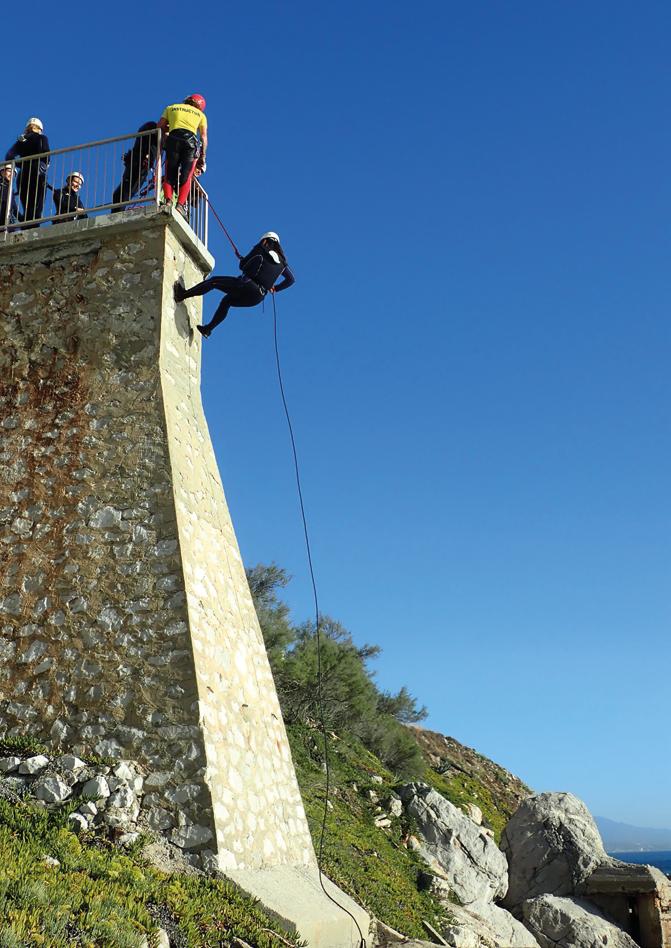
113 112
OTWO 32 / MARCH 2022 OTWO 32 / MARCH 2022
Emotions are a set of physical or bodily reactions to an external stimulus (seeing, hearing, tasting...) or an internal stimulus (thinking, remembering, imagining...) that are unconscious, intense and uncontrollable and that take us out of our “normal” state in which we live. They motivate us, stimulate us and push us to react.
If we add a thought to an emotion, it becomes a feeling, as long as we are able to become aware of it.
From an early age, we have not been taught to love and care for our roots. I speak of roots because that is where we come from, we are all part of Nature.
We have survived this time trying to fit into our society, without being able to be ourselves or what is much worse, without dedicating moments to feel. Nothing is permanent, everything changes, we are in continuous movement, led by stress, work, schedules?
Do you want to know what Nature has to do with all this?
Nature does not demand you to be valid or to make the grade, for her you are one more, being a wise pupil, you can arrive without calling or stay as long as you need, it is your house, your home ... your inner forest.
The way is towards NATURE! Everything we need comes from her, water, oxygen, food, plants, medicine.
The Forest Bath is a reconnection with nature through the senses, walk a few kilometers, with a duration of 2 to 3 hours, letting your intuition flow following my advice.
The regular contact with the Forest Baths, scientifically proven, improves mental and physical health and increases the immune system, walking among the plants and trees causes your blood pressure to lower, reduces depression and stress, improves creativity and all this is due to the essential oils of plants and trees that are transmitted through the air, and that prevent them from germs, this benefit also falls on ourselves.
It is not necessary to have physical preparation, just have time for the appointment with oneself, we must break the hyperconnection with daily tasks and stress, get out of that wheel will make everything better, following the rhythm that nature marks us; a slow and calm pace, allowing us to appreciate the details, sounds, textures, smells and sensations.
Forest Baths
Baños de Bosque
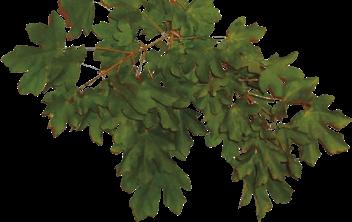
Raquel Collante

Las emociones son un conjunto de reacciones físicas o corporales ante un estímulo externo (ver, oír, saborear…) o interno (pensar, recordar, imaginar…) inconscientes, intensas e incontrolables que nos sacan de nuestro estado “normal” en el cual vivimos. Nos motivan, nos sirven de estímulo y nos empujar a reaccionar.
Si a una emoción le añadimos un pensamiento, se convierte en un sentimiento, siempre que seamos capaces de tomar conciencia de ello.
Desde pequeños no nos han enseñado a amar y cuidar nuestras raíces. Hablo de raíces porque es de dónde venimos, todos somos y formamos parte de la Naturaleza. Hemos sobrevivido este tiempo buscando encajar en nuestra sociedad, sin poder ser uno mismo o lo que es mucho peor, sin dedicarnos momentos para sentir. Nada es permanente, todo cambia, estamos en continuo movimiento, liderado por el estrés, el trabajo, los horarios… ¿Quieres saber que tiene que ver la Naturaleza en todo esto?
La Naturaleza no te exige ser válida o dar la talla, para ella eres una más, siendo una alumna sabia, puedes llegar sin llamar o quedarte el tiempo que te haga falta, es tu casa, tu hogar….tu bosque interior
¡El camino es hacia la NATURALEZA! Todo lo que necesitamos proviene de ella, agua, oxigeno, alimentos, plantas, medicinas
Potencia el sentido de lo natural, el Baño de Bosque es una reconexión con la naturaleza mediante los sentidos, pasear pocos kilómetros, con una duración de 2 a 3 horas, dejando a tu intuición fluir siguiendo mis consejos.
El contacto regular con los Baños de Bosques, científicamente probado, mejora la salud mental, física y aumenta el sistema inmunológico, pasear entre las plantas y los arboles provoca que tu tensión arterial baje, reduce la depresión y el estrés, mejora la creatividad y todo ello se debe a los aceites esenciales de plantas y árboles que se trasmiten a través del aire, y que previenen a estos de los gérmenes, este beneficio también recae en nosotros mismos.
No es necesario tener preparación física, solo disponer del tiempo para la cita con uno mismo, hay que romper la hiperconexion con las tareas diarias y el estrés, salir de esa rueda va a hacer que todo mejore, siguiendo el compás que la Naturaleza nos marca; un ritmo lento y sosegado, nos permita apreciar los detalles, los sonidos, las texturas, olores y sensaciones.
OTWO 32 / MARCH 2022 115 114 OTWO 32 / MARCH 2022
Forest Bath in Pinar del Rey
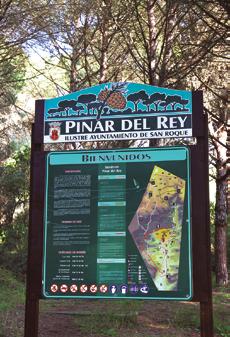
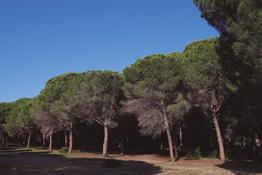
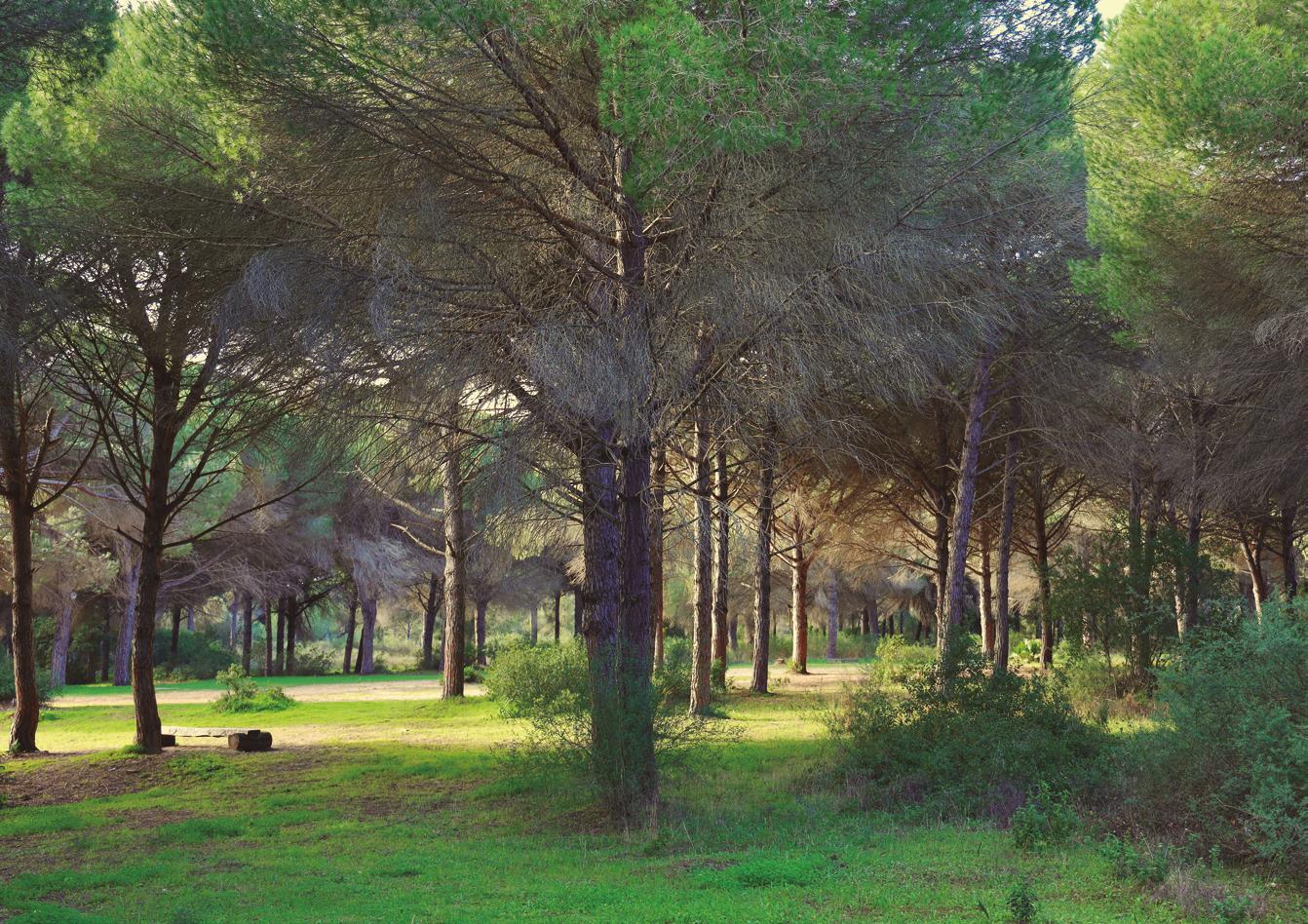
In the Natural Park Los Alcornocales, the Pinar del Rey is located between the municipalities of San Roque and Castellar de la Frontera, in Cadiz.
Its origin dates back to 1800, this place was chosen to plant pine trees (Pinus Pinea) brought from Vejer de la Frontera, and thus obtain wood for the construction of ships.
It currently consists of a recreational area with a picnic area and barbecues, the Alhaja stream, the Nature Classroom and a botanical garden. In addition, there are two trails: El Cerro del Águila and Tajo del Pajarraco.
A peculiar place, with a mild climate, and a migratory bird route. Its environmental conditions make it a paradise for flora. We can even see some plants that only occur in northern Spain and the Canary Islands.
We will walk through a mixed forest, with cork oaks, gall oaks, poplars, alders and ash trees, with a wide variety of botanical species, some of them endangered. In addition, of course we will discover its rich and varied fauna.
In addition, the Pinar del Rey, was part of a sandy seabed settlement, so we can easily find shells and marine pieces.
Discover the cumulative effect that nature has, the nuances in which you had never noticed, the calm that offers a place with so much magic.
To begin the activity we will leave the car at the end of the parking lot of the recreational area of Pinar del Rey (San Roque), it is important to bring water, sunscreen, (optional mat for floor and camera).
Duration: 2 to 3 hours.
Minimum and maximum number of participants: 5 to 15 people
Dates: Any season of the year.
Maximum distance: 2 kilometers.
Important: Notify any food allergies.
Prices: 20£ /person.
(RC and accident insurance included).
En el Parque Natural Los Alcornocales, se ubica el Pinar del Rey entre los términos municipales de San Roque y Castellar de la Frontera, en Cádiz.
Su origen se remonta a 1800, este lugar fue elegido para plantar ejemplares de pinos piñoneros (Pinus Pinea) traídos desde Vejer de la Frontera, y obtener así madera para la construcción de navíos.
Actualmente consta de un área recreativa con una zona de picnic y barbacoas, el arroyo de Alhaja, el Aula de Naturaleza y un jardín botánico. Además, existen dos senderos: El Cerro del Águila y el Tajo del Pajarraco.
Un lugar peculiar, de clima suave, y paso de ruta de aves migratorias. Sus condiciones ambientales lo convierten en un paraíso para la flora. Incluso podemos ver algunas plantas que únicamente se dan en el norte de España y en las Islas Canarias.
Recorreremos un bosque mixto, con alcornoques, quejigos, álamos, alisos y fresnos, con una extensa variedad de especies botánicas, algunas de ellas amenazadas. Y por supuesto descubriremos su rica y variada fauna.
Además, el Pinar del Rey, formó parte de un asentamiento arenoso de fondos marinos, con lo cual podremos encontrar fácilmente conchas y piezas marinas. Descubre el efecto acumulativo que tiene la naturaleza, los matices en los que nunca te habías fijado, la calma que ofrece un lugar con tanta magia.
Para comenzar la actividad dejaremos el coche al final del aparcamiento de la zona recreativa del Pinar del Rey (San Roque), es importante llevar agua, protección solar, (opcional esterilla para suelo y cámara de fotos).
Duración: 2 a 3 horas.
Mínimo y máximo de participantes:. 5 a 15 personas.
Fechas: Cualquier estación del año. Distancia máxima: 2 kilómetros.
Importante: Informar de alergias alimenticias .
Precios: 20£ /persona.
(Seguro RC y accidentes incluidos),
OTWO 32 / MARCH 2022 117 116 OTWO 32 / MARCH 2022
Baño de Bosque en el Pinar del Rey.
Photographs: Juan Luis González
ADVENTURE IN THE GENAL VALLEY VIA FERRATA “BENADALID”


Our adventure takes place in one of the most beautiful places in Andalusia, the Genal River Valley. The river rises in Igualeja and forms a gorge, although not too deep, very lush between gall oaks, chestnut trees, walnut trees... Also watering the villages of Andalusian origin as Igualeja, Atajate, Benadalid, Benalauría and Benarrabá.
A via ferrata is a vertical path equipped with staples, lifelines, bridges... It has its origin in the Second World War, when the partisans tried to avoid the Nazis on the mountain roads.
The via ferrata of “Benadalid” is considered a K3. This level indicates that it is necessary to have an acceptable physical form to be able to enjoy it.
For the adventure, you will have all the necessary technical equipment: harness, helmet, fall arrester and short anchor rope.
Vía Ferrata.
The via ferrata of Benadalid, is a K3 level ferrata, very vertical with 80m of vertical drop. It has two steep overhangs that will make us download
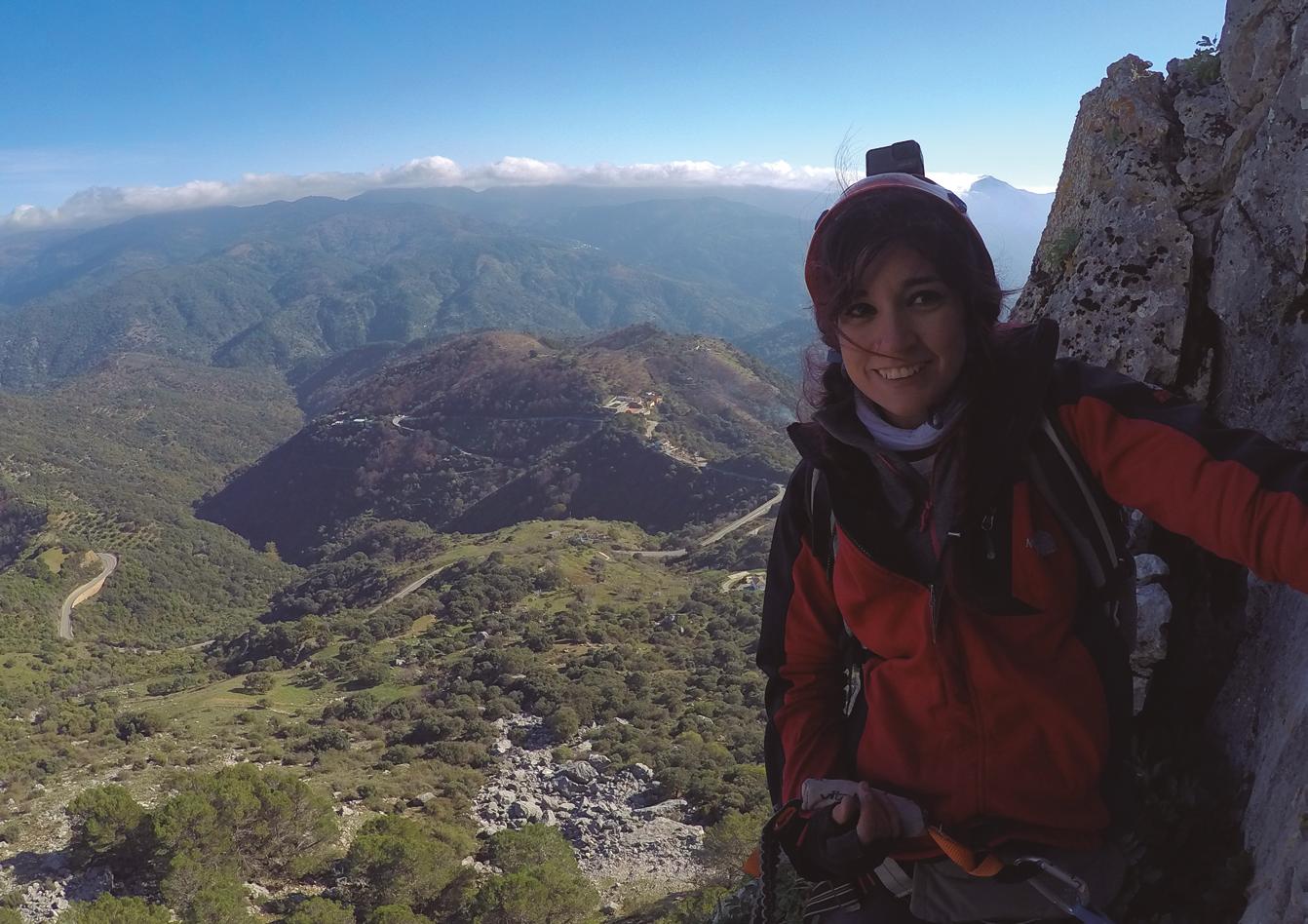
adrenaline without any doubt. Ideal for lovers of heights. On clear days we can see the Rock of Gibraltar and Jbel Mussa in Morocco. This via ferrata has two pronounced overhangs that will make us release adrenaline without a doubt. Ideal for lovers of heights, it is advisable to have previously done a via ferrata of equal or lower level. After finishing the via ferrata, we descend along a path located at the back of the route until we reach the starting point.
Duration: Vïa Ferrata 2 hours.
Minimum/Maximum number of participants: 6/12 participants.
Recommended Dates: Spring, Fall and Winter.
Services:
Specialized monitors and equipment. All technical equipment. First aid kit. RC and Accident Insurance. Photographic report with video summary.
Pricing: Full adventure..........30€
119 118
OTWO 32 / MARCH 2022 OTWO 32 / MARCH 2022
AVENTURA EN EL VALLE DEL GENAL VÍA FERRATA «BENADALID»
Nuestra aventura se realiza en uno de los lugares más bellos de Andalucía, el Valle del Río Genal. El río nace en Igualeja y forma una garganta, aunque no demasiado profunda, muy frondosa entre quejigos, castaños, nogales… Además regando los pueblos de origen andalusí como Igualeja, Atajate, Benadalid, Benalauría y Benarrabá.
Una vía ferrata es un camino vertical equipado en la parted con grapas, líneas de vída, puentes… Tiene su origen en la Segunda Guerra Mundial, cuando los partisanos trataban de esquivar a los nazis en los caminos de montaña. La vía ferrata del «Benadalid», esta considerada una K3. Este nivel nos indica, que hay que tener una forma física aceptable para poder disfrutar de ella.
Para la aventura se dipondrá de todo el material técnico necesario: arnés, casco, disipador anticaída y vaga corta de anclaje.
La Vía Ferrata
La vía ferrata de Benadalid, es una ferrata de nivel K3, muy vertical con 80m de desnivel. Tiene dos extraplomos pronunciados que nos harán descargar adrenalina sin duda alguna. Idea para amantes a las alturas. En días despejados podemos ver el Peñón de Gibraltar y el Jbel Mussa en Marruecos. Esta vía ferrata tiene dos extraplomos pronunciados que nos harán descargar adrenalina sin duda alguna. Ideal para los amantes a las alturas, es recomendable haber realizado antes alguna vía ferrata de nivel igual o inferior. Tras acabar descendemos por un sendero situado en la parte posterior hasta llegar al punto de inicio.
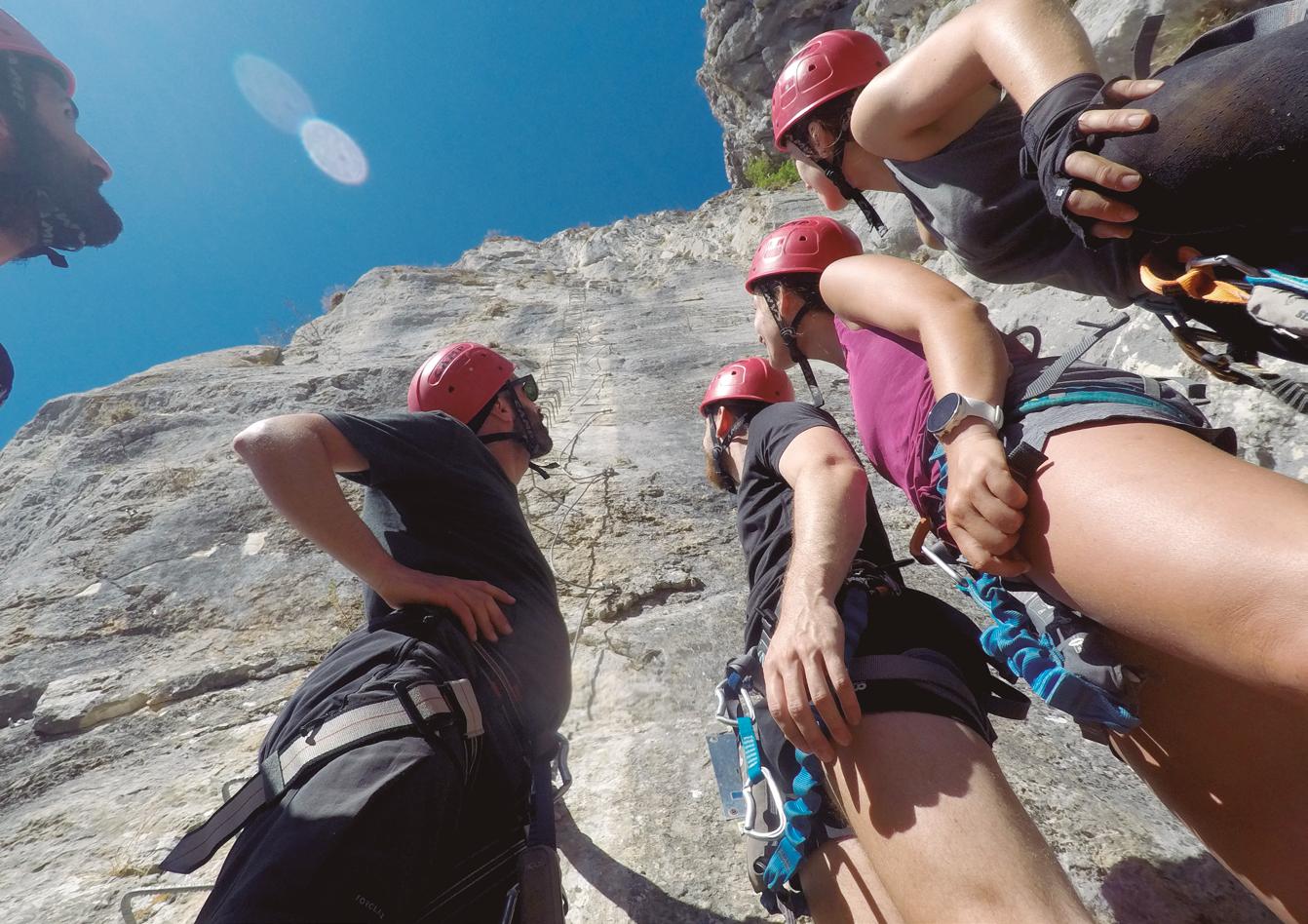
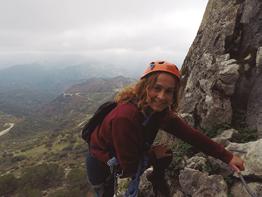
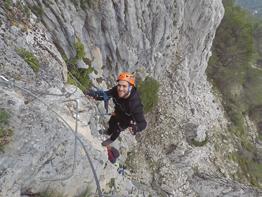
Duración: Vïa Ferrata de 2 horas.
Mínimo/Máximo de participantes: 6/12
Fechas Recomendadas:
Primavera, Otoño e Invierno.
Servicios: Monitores y equipos especializados.
Todo el material técnico Botiquín primeros auxilios.
Seguros RC y Accidentes. Reportaje fotográfico con vídeo resumen
Precios: Aventura completa……….30€
121 120
OTWO 32 / MARCH 2022 OTWO 32 / MARCH 2022
We´re raising £10,000
to restore and renovate historical sights around Gibraltar
Whilst there is a rich history of defence on the Rock of Gibraltar there is no one organisation that takes responsibility for the upkeep of the various guns and other military positions.
It is my mission to do my best to restore, renovate and refurbish as many of these sights as possible to ensure our heritage and history is not lost to neglect.
This has been a completely voluntary project which has recieved minimum adhoc funding. Any donations will go towards the purchasing of the necessary materials and equipment to continue this project.
COLLABORATE IN THIS LINK:
https://www.justgiving.com/crowdfunding/rachael-jackson-904?utm_term=AGy2zwmZ9--


